
Oracle9
i
DBA Fundamentals I
Volume 2 • Student Guide
D11321GC10
Production 1.0
May 2001
D32644

Authors
Sarath Chandran
Marie St. Gelais
S Matt Taylor Jr
Technical Reviewers
Howard Bradley
Ruth Baylis
Paul Cartwright
Trevor Davis
Joel Goodman
Scott Gossett
Tomoki Ishii
Peter Kilpatrick
Stefan Lindblad
Howard Ostrow
Ashesh Parekh
Radhanes Petronilla
Venceslava Pretlova
Andreas Reinhardt
Ranbir Singh
Peter Sharman
Barry Trute
Ric VanDyke
Karla Villasenor
John Watson
Teppei Yagihashi
Publisher
Shane Mattimoe
Copyright © Oracle Corporation, 2001. All rights reserved.
This documentation contains proprietary information of Oracle Corporation. It is
provided under a license agreement containing restrictions on use and disclosure
and is also protected by copyright law. Reverse engineering of the software is
prohibited. If this documentation is delivered to a U.S. Government Agency of the
Department of Defense, then it is delivered with Restricted Rights and the
following legend is applicable:
Restricted Rights Legend
Use, duplication or disclosure by the Government is subject to restrictions for
commercial computer software and shall be deemed to be Restricted Rights
software under Federal law, as set forth in subparagraph (c)(1)(ii) of DFARS
252.227-7013, Rights in Technical Data and Computer Software (October 1988).
This material or any portion of it may not be copied in any form or by any means
without the express prior written permission of Oracle Corporation. Any other
copying is a violation of copyright law and may result in civil and/or criminal
penalties.
If this documentation is delivered to a U.S. Government Agency not within the
Department of Defense, then it is delivered with “Restricted Rights,” as defined in
FAR 52.227-14, Rights in Data-General, including Alternate III (June 1987).
The information in this document is subject to change without notice. If you find
any problems in the documentation, please report them in writing to Education
Products, Oracle Corporation, 500 Oracle Parkway, Box SB-6, Redwood Shores,
CA 94065. Oracle Corporation does not warrant that this document is error-free.
SQL*Loader, SQL*Net, SQL*Plus, Net8, Oracle Call Interface, Oracle7, Oracle8,
Oracle 8i, Developer/2000, Developer/2000 Forms, Designer/2000, Oracle
Enterprise Manager, Oracle Parallel Server, PL/SQL, Pro*C, Pro*C/C++, and
Trusted Oracle are trademarks or registered trademarks of Oracle Corporation.
All other products or company names are used for identification purposes only,
and may be trademarks of their respective owners.

Introduction
Course Objectives I-2
Oracle 9
i
Enterprise Edition I-3
Database Administrator Tasks I-4
1
Oracle Architectural Components
Objectives 1-2
Overview of Primary Componenets 1-3
Oracle Server 1-5
Oracle Instance 1-6
Establishing a Connection and Creating a Session 1-7
Oracle Database 1-9
Physical Structure 1-10
Memory Structure 1-11
System Global Area (SGA) 1-12
Shared Pool 1-15
Library Cache 1-16
Data Dictionary Cache 1-17
Database Buffer Cache 1-18
Redo Log Buffer Cache 1-21
Large Pool 1-22
Java Pool 1-23
Program Global Area (PGA) 1-24
Process Structure 1-25
User Process 1-26
Sever Process 1-27
Background Processes 1-28
Database Writer (DBWn) 1-29
Log Writer (LGWR) 1-30
System Monitor (SMON) 1-31
Process Monitor (PMON) 1-32
Checkpoint (CKPT) 1-33
Archiver (ARCn) 1-35
Logical Structure 1-37
Processing a SQL Statement 1-38
Summary 1-40
Practice 1 Overview 1-41
2 Getting Started With the Oracle Server
Objectives 2-2
Database Administration Tools 2-3
Contents
iii

Oracle Universal Installer 2-4
Interactive Installation 2-5
Non-Interactive Installation Using Response Files 2-6
Oracle Database Configuration Assistant 2-9
Optimal Flexible Architecture (OFA) 2-10
Oracle Software and File Locations 2-11
Database Administrator Users 2-12
Authentication Methods for Database Administrators 2-13
Using Password File Authentication 2-14
SQL* Plus 2-16
Oracle Enterprise Manager 2-17
Oracle Enterprise Manager Architecture: Java-Based Console and
Applications 2-18
Oracle Enterprise Manager Architecture: Managed Nodes 2-19
Oracle Enterprise Manager Console 2-20
DBA Tools 2-22
Summary 2-24
Practice 2 Overview 2-25
3 Managing an Oracle Instance
Objectives 3-2
Initialization Parameter Files 3-3
PFILE initSID.ora
3-5
PFILE
Example 3-6
SPFILE spfileSID.ora
3-7
Creating an
SPFILE
3-8
SPFILE
Example 3-10
Oracle Managed Files 3-12
Oracle Managed File Example 3-14
Starting UP a Database 3-15
STARTUP
Command 3-18
The
ALTER DATABASE
Comand 3-20
Opening a Database in Restricted Mode 3-21
Opening a Database in Read-Only Mode 3-23
Shutting Down the Database 3-24
Shutdown Options 3-25
Managing an Instance by Monitoring Diagnostic Files 3-29
Alert Log File 3-30
Background Trace Files 3-32
User Trace File 3-33
iv

Enabling or Disabling User Tracing 3-34
Summary 3-35
Practice 3 Overview 3-38
4
Creating a Database
Objectives 4-2
Managing and Organizing a Database 4-3
Creation Prerequisites 4-4
Planning Database Files Locations 4-5
Creating a Database 4-7
Operating System Environment 4-8
Using the Database Configuration Assistant 4-9
Create a Database 4-11
Database Information 4-12
Typical or Custom Install 4-13
Other Parameters 4-15
Complete Database Creation 4-16
Creating a Database Manually 4-17
Preparing the Parameter File 4-18
Creating
SPFILE
4-19
Starting the Instance 4-20
Creating the Database 4-21
Creating a Database Using OMF 4-24
Troubleshooting 4-25
After Database Creation 4-26
Summary 4-27
5
Data Dictionary Contents and Usage
Objectives 5-2
Data Dictionary 5-3
Data Dictionary Contents 5-5
How the Data Dictionary Is Used 5-6
Data Dictionary View Categories 5-7
Dynamic Performance Tables 5-9
Querying the Data Dictionary and Dynamic Performance Views 5-10
Data Dictionary Examples 5-11
Summary 5-12
Practice 5 Overview 5-13
6
Maintaining the Control File
Objectives 6-2
Control File 6-3
v

Control File Contents 6-5
Multiplexing the Control File Using
SPFILE
6-7
Multiplexing the Control File Using
init.ora
6-8
Managing Control Files with OMF 6-9
Obtaining Control File Information 6-10
Summary 6-13
Practice 6 Overview 6-14
7
Maintaining Redo Log Files
Objectives 7-2
Using Redo Log Files 7-3
Structure of Redo Log Files 7-4
How Redo Logs Work 7-6
Forcing Log Switches and Checkpoints 7-8
Adding Online Redo Log Groups 7-9
Adding Online Redo Log Members 7-10
Dropping Online Redo Log Groups 7-12
Dropping Online Redo Log Members 7-13
Clearing, Relocating, or Renaming Online Redo Log Files 7-15
Online Redo Log Configuration 7-17
Managing Online Redo Logs with OMF 7-19
Obtaining Group and Member Information 7-20
Archived Redo Log Files 7-22
Summary 7-26
Practice 7 Overview 7-28
8
Managing Tablespaces and Data files
Objectives 8-2
Overview 8-3
Database Storage Hierarchy 8-4
SYSTEM
and Non-
SYSTEM
Tablespaces 8-7
Creating Tablespaces 8-8
Space Management in Tablespaces 8-11
Locally Managed Tablespaces 8-12
Dictionary Managed Tablespaces 8-14
Changing the Storage Settings 8-15
Undo Tablespace 8-17
Temporary Tablespace 8-18
Default Temporary Tablespace 8-21
Restrictions on Default Temporary Tablespace 8-22
Offline Status 8-23
Read-Only Tablespaces 8-26
Dropping Tablespaces 8-29
vi

Resizing a Tablespace 8-32
Enabling Automatic Extension of Data Files 8-33
Changing the Size of Data Files Manually 8-36
Adding Data files to a Tablespace 8-37
Moving Data Files:
ALTER TABLESPACE
8-39
Configuring Oracle Managed Files for Tablespace Creation 8-42
Creating Tablespaces with OMF 8-43
Obtaining Tablespaces Information 8-44
Summary 8-45
Practice 8 Overview 8-47
9
Storage Structure and Relationships
Objectives 9-2
Overview 9-3
Types of Segments 9-4
Storage Clause Precedence 9-8
Extent Allocation and Deallocation 9-9
Used and Free Extents 9-10
Database Block 9-11
Database Block Contents 9-12
Block Space Utilization Parameters 9-13
Data Block Management 9-15
Automatic Segment-Space Management 9-16
Configuring Automatic Segment-Space Management 9-18
Manual Data Block Management 9-19
Block Space Usage 9-20
Data Dictionary Views 9-21
Obtaining Storage Information 9-22
Summary 9-24
Practice 9 Overview 9-26
10 Managing Undo Data
Objectives 10-2
Managing Undo Data Overview 10-3
Undo Segment 10-4
Undo Segments: Purpose 10-5
Read Consistency 10-6
Types of Undo Segments 10-7
Automatic Undo Management: Concepts 10-9
Automatic Undo Management: Configuration 10-10
Automatic Undo Management: Initialization Parameters 10-11
Automatic Undo Management:
UNDO
Tablespace 10-12
vii

Automatic Undo Management: Altering and
UNDO
Tablespace 10-14
Automatic Undo Management: Switching
UNDO
Tablespaces 10-16
Automatic Undo Management: Dropping an
UNDO
Tablespace 10-18
Automatic Undo Management: Other Parameters 10-21
Undo Data Statistics 10-23
Automatic Undo Management: Sizing an
UNDO
Tablespaces 10-24
Automatic Undo Management Undo Quota 10-26
Obtaining Undo Segments Information 10-27
Summary 10-29
Practice 10 Overview 10-31
11 Managing Tables
Objectives 11-2
Storing User Data 11-3
Oracle Data Types 11-6
ROWID Format 11-10
Structure of a Row 11-12
Creating a Table 11-13
Creating Temporary Tables 11-17
Creating a Table: Guidelines 11-18
Changing Storage Parameters 11-19
Manually Allocating Extents 11-22
Nonpartitioned Table Reorganization 11-23
Truncating a Table 11-24
Dropping a Table 11-26
Dropping a Column 11-27
Using the UNUSED Option 11-28
Obtaining Table Information 11-30
Summary 11-33
Practice 11 Overview 11-34
12 Managing Indexes
Objectives 12-2
Classification of Indexes 12-3
B-Tree Index 12-5
Bitmap Index 12-7
Comparing B-Tree and Bitmap Indexes 12-9
Creating Normal B-Tree Indexes 12-10
Creating Indexes: Guidelines 12-14
Creating Bitmap Indexes 12-16
Changing Storage Parameters for Indexes 12-19
Allocating and Deallocating Index Space 12-21
viii

Rebuilding Indexes 12-22
Online Rebuild of Indexes 12-24
Coalescing Indexes 12-25
Checking Index Validity 12-26
Dropping Indexes 12-28
Identifying Unused Indexes 12-30
Obtaining Index Information 12-31
Summary 12-32
Practice 12 Overview 12-34
13 Maintaining Data Integrity
Objectives 13-2
Data Integrity 13-3
Types of Constraints 13-5
Constraint States 13-6
Constraint Checking 13-8
Defining Constraints as Immediate or Deferred 13-9
Primary and Unique Key Enforcement 13-10
Foreign Key Considerations 13-11
Defining Constraints While Creating a Table 13-13
Guidelines for Defining Constraints 13-18
Enabling Constraints 13-19
Using the
EXCEPTIONS
Table 13-24
Obtaining Constraint Information 13-27
Summary 13-30
Practice 13 Overview 13-32
14 Managing Password Security and Resources
Objectives 14-2
Profiles 14-3
Password Management 14-5
Enabling Password Management 14-6
Password Account Locking 14-7
Password Expiration and Aging 14-8
Password History 14-9
Password Verification 14-10
User-Provided Password Function 14-11
Password Verification Function
VERIFY_FUNCTION
14-12
Creating a Profile: Password Settings 14-13
Altering a Profile: Password Setting 14-17
Dropping a Profile: Password Setting 14-19
Resource Management 14-21
ix

Enabling Resource Limits 14-22
Setting Resource Limits at Session Level 14-23
Setting Resource Limits at Call Level 14-24
Creating a Profile: Resource Limit 14-25
Managing Resource Using the Database Resource Manager 14-28
Resource Plan Directives 14-30
Obtaining Password and Resource Limits Information 14-32
Summary 14-34
Practice Overview 14-36
15 Managing Users
Objectives 15-2
Users and Security 15-3
Database Schema 15-5
Checklist for Creating Users 15-6
Creating a New User: Database Authentication 15-7
Creating a New User: Operating System Authentication 15-10
Changing User Quota on Tablespace 15-12
Dropping a User 15-14
Obtaining User Information 15-15
Summary 15-16
Practice 15 Overview 15-17
16 Managing Privileges
Objectives 16-2
Managing Privileges 16-3
System Privileges 16-4
System Privileges: Examples 16-5
Granting System Privileges 16-6
SYSDBA
and
SYSOPER
Privileges 16-9
System Privilege Restrictions 16-10
Revoking System Privileges 16-11
Revoking System Privileges
WITH ADMIN OPTION
16-12
Object Privileges 16-13
Granting Object Privileges 16-14
Revoking Object Privileges 16-17
Revoking Object Privileges
WITH GRANT OPTION
16-20
Obtaining Privileges Information 16-21
Auditing 16-22
Auditing Guidelines 16-23
Auditing Categories 16-25
x

Database Auditing 16-27
Auditing Options 16-29
Viewing Auditing Options 16-31
Obtaining Audit Records 16-32
Summary 16-33
Practice 16 Overview 16-35
17 Managing Roles
Objectives 17-2
Roles 17-3
Benefits of Roles 17-4
Creating Roles 17-5
Predefined Roles 17-8
Modifying Roles 17-9
Assigning Roles 17-11
Establishing Default Roles 17-13
Application Roles 17-16
Enabling and Disabling Roles 17-17
Removing Roles from Users 17-21
Removing Roles 17-23
Guidelines for Creating Roles 17-25
Guidelines for Using Passwords and Default Roles 17-26
Displaying Role Information 17-27
Summary 17-28
Practice 17 Overview 17-30
18 Using Globalization Support
Objectives 18-2
Globalization Support Features 18-3
Different Types of Encoding Schemes 18-5
Database Character Sets and National Character Sets 18-8
Guidelines for Choosing an Oracle Database Character Set 18-9
Guidelines for Choosing an Oracle National Character Set 18-11
Choosing a Unicode Solution Unicode Database 18-12
Choosing a Unicode Solution Unicode Datatype 18-13
Specifying Language-Dependent Behavior 18-14
Specifying Language-Dependent Behavior for the Server 18-15
Dependent Language and Territory Default Values 18-16
Specifying Language-Dependent Behavior for the Session 18-18
Character Sets in Client-Server Architecture 18-19
Specifying Language-Dependent Behavior for the Session 18-21
xi

Linguistic Sorting 18-22
NLS Sorting 18-23
Using NLS Parameters in SQL Functions 18-26
Linguistic Index Support 18-30
Import and Loading Data Using NLS 18-31
Obtaining Information About Character Sets 18-32
Obtaining Information About NLS Settings 18-33
Globalization Support Utilities 18-37
Summary 18-39
Practice 18 Overview 18-40
Appendix A: How to Create an Oracle9
i
Database in an Unix Environment
Appendix B: Managing Rollback Segments
Appendix C: Practice for SQL*Plus
xii

DBA Fundamentals I 12
-
1
12
Copyright © Oracle Corporation, 2001. All rights reserved.
Managing Indexes

DBA Fundamentals I 12
-
2
12-2
Copyright © Oracle Corporation, 2001. All rights reserved.
Objectives
After completing this lesson, you should be able to
do the following:
•
List the different types of indexes and their uses
•
Create various types of indexes
•
Reorganize indexes
•
Drop indexes
•
Get index information from the data dictionary
•
Monitor the usage of an index

DBA Fundamentals I 12
-
3
Classification of Indexes
An index is a tree structure that allows direct access to a row in a table. Indexes can be
classified based on their logical design or on their physical implementation. The logical
classification groups indexes from an application perspective, while the physical
classification is derived from the way the indexes are stored.
Single Column and Concatenated Indexes
A single column index has only one column in the index key—for example, an index on the
employees
number column of an
employees
table.
A concatenated index, also known as a composite index, is created on multiple columns in a
table. Columns in a concatenated index do not need to be in the same order as the columns in
the table, nor do they need to be adjacent—for example, an index on the department and job
columns of an employee table.
The maximum number of columns in a composite key index is 32. However, the combined
size of all the columns cannot exceed roughly one-third of the data block size.
12-3
Copyright © Oracle Corporation, 2001. All rights reserved.
Classification of Indexes
•
Logical
–
Single column or concatenated
–
Unique or nonunique
–
Function-based
–
Domain
•
Physical
–
Partitioned or nonpartitioned
–
B-tree
–
Normal or reverse key
–
Bitmap

DBA Fundamentals I 12
-
4
Classification of Indexes (continued)
Unique and Nonunique Indexes
A unique index guarantees that no two rows of a table have duplicate values in the column
that defines the index. An index key in a unique index can point to only one row in the table.
In a nonunique index, a single key can have multiple rows associated with it, and can be used
to enforce uniqueness.
Function-Based Indexes
A function-based index is created when using functions or expressions that involve one or
more columns in the table being indexed. A function-based index precomputes the value of
the function or expression and stores it in the index. Function-based indexes can be created as
either a B-tree or a bitmap index.
Domain Indexes
A domain index is an application-specific (Text, Spatial) index that is created, managed, and
accessed by routines supplied by an indextype. It is called a domain index because it indexes
data in application-specific domains.
Only single-column domain indexes are supported. You can build single-column domain
indexes on columns having scalar, object, or LOB datatypes.
Partitioned and Nonpartitioned Indexes
Partitioned indexes are used for large tables to store index entries corresponding to an index
in several segments. Partitioning allows an index to be spread across many tablespaces,
decreasing contention for index lookup, and increasing manageability. Partitioned indexes are
often used with partitioned tables to improve scalability and manageability. An index
partition can be created for each table partition.
This lesson discusses the creation and maintenance of nonpartitioned B-tree and bitmap
indexes.

DBA Fundamentals I 12
-
5
How Indexes Are Stored
Although all the indexes use a B-tree structure, the term B-tree index is usually associated
with an index that stores a list of ROWIDS for each key.
Structure of a B-Tree Index
At the top of the index is the root, which contains entries that point to the next level in the
index. At the next level are branch blocks, which in turn point to blocks at the next level in
the index. At the lowest level are the leaf nodes, which contain the index entries that point to
rows in the table. The leaf blocks are doubly linked to facilitate scanning the index in an
ascending as well as descending order of key values.
Format of Index Leaf Entries
An index entry is made up of the following components:
• An entry header, which stores number of columns and locking information
• Key column length-value pairs, which define the size of a column in the key followed
by the value for the column (The number of such pairs is a maximum of the number of
columns in the index.)
• ROWID of a row, which contains the key values
12-5
Copyright © Oracle Corporation, 2001. All rights reserved.
B-Tree Index
Index entry header
Key column length
Key column value
ROWID
Root
Branch
Leaf
Index entry

DBA Fundamentals I 12
-
6
Index Leaf Entry Characteristics
In a B-tree index on a nonpartitioned table:
• Key values are repeated if there are multiple rows that have the same key value.
• There is no index entry corresponding to a row that has all key columns that are
NULL
.
Therefore a
WHERE
clause specifying
NULL
will always result in a full table scan.
• Restricted ROWID is used to point to the rows of the table, since all rows belong to the
same segment.
Effect of DML Operations on an Index
The Oracle server maintains all the indexes when DML operations are carried out on the
table. Here is an explanation of the effect of a DML command on an index:
• Insert operations result in the insertion of an index entry in the appropriate block.
• Deleting a row results only in a logical deletion of the index entry. The space used by
the deleted row is not available for new entries until all the entries in the block are
deleted.
• Updates to the key columns result in a logical delete and an insert to the index. The
PCTFREE
setting has no effect on the index except at the time of creation. A new entry
may be added to an index block even if it has less space than that specified by
PCTFREE
.

DBA Fundamentals I 12
-
7
8
Bitmap Indexes
Bitmap indexes are more advantageous than B-tree indexes in certain situations:
• When a table has millions of rows and the key columns have low cardinality—that is,
there are very few distinct values for the column. For example, bitmap indexes may be
preferable to B-tree indexes for the gender and marital status columns of a table
containing passport records.
• When queries often use a combination of multiple
WHERE
conditions involving the
OR
operator.
• When there is read-only or low update activity on the key columns.
Structure of a Bitmap Index
A bitmap index is also organized as a B-tree, but the leaf node stores a bitmap for each key
value instead of a list of ROWIDs. Each bit in the bitmap corresponds to a possible ROWID,
and if the bit is set, it means that the row with the corresponding ROWID contains the key
value.
As shown in the diagram, the leaf node of a bitmap index contains the following:
• An entry header, containing the number of columns and lock information
• Key values consisting of length and value pairs for each key column (In the example,
the key consists of only one column, and the first entry has a key value of Blue.)
12-7
Copyright © Oracle Corporation, 2001. All rights reserved.
Bitmap Index
<Blue, 10.0.3, 12.8.3, 1000100100010010100>
<Green, 10.0.3, 12.8.3, 0001010000100100000>
<Red, 10.0.3, 12.8.3, 0100000011000001001>
<Yellow, 10.0.3, 12.8.3, 0010001000001000010>
key
start
ROWID
end
ROWID
bitmap
Table
Index
Block 10
Block 11
Block 12
File 3

DBA Fundamentals I 12
-
8
Structure of a Bitmap Index (continued)
• Start ROWID, which in the example contains a file number 3, a block number 10, and a
row number 0
• End ROWID, which in the example includes a block number 12 and a row
number 8
• A bitmap segment consisting of a string of bits (The bit is set when the corresponding
row contains the key value and is unset when the row does not contain the key value.
The Oracle server uses a patented compression technique to store bitmap segments.)
The start ROWID is the ROWID of the first row pointed to by the bitmap segment of the
bitmap—that is, the first bit of the bitmap corresponds to that ROWID, the second bit of the
bitmap corresponds to the next row in the block, and the end ROWID is a pointer to the last
row in the table covered by the bitmap segment. Bitmap indexes use restricted ROWIDs.
Using a Bitmap Index
The B-tree is used to locate the leaf nodes that contain bitmap segments for a given value of
the key. Start ROWID and the bitmap segments are used to locate the rows that contain the
key value.
When changes are made to the key column in the table, bitmaps must be modified. This
results in locking of the relevant bitmap segments. Because locks are acquired on the whole
bitmap segment, a row that is covered by the bitmap cannot be updated by other transactions
until the first transaction ends.

DBA Fundamentals I 12
-
9
Comparing B-Tree and Bitmap Indexes
Bitmap indexes are more compact than B-tree indexes when used with
low-cardinality columns.
Updates to key columns in a bitmap index are more expensive because bitmaps use bitmap-
segment-level locking, whereas in a B-tree index, locks are on entries corresponding to
individual rows of the table.
Bitmap indexes can be used to perform operations such as Bitmap Boolean. The Oracle
server can use two bitmap segments to perform a bitwise boolean and get a resulting bitmap.
This allows efficient use of bitmaps in queries that use the boolean predicate.
In summary, B-tree indexes may be more suitable in an OLTP environment for indexing
dynamic tables, whereas bitmap indexes may be useful in data warehouse environments
where complex queries are used on large, static tables.
12-9
Copyright © Oracle Corporation, 2001. All rights reserved.
Comparing B-Tree and
Bitmap Indexes
B-tree
Suitable for high-cardinality
columns
Updates on keys relatively
inexpensive
Inefficient for queries
using OR predicates
Useful for OLTP
Bitmap
Suitable for low-cardinality
columns
Updates to key columns very
expensive
Efficient for queries
using OR predicates
Useful for data warehousing

DBA Fundamentals I 12
-
10
Creating Normal B-Tree Indexes
An index can be created either in the account of the user who owns the table or in a different
account, although it is generally created in the same account as the table.
The syntax above creates an index on the EMPLOYEES table using the LAST_NAME
column.
12-10
Copyright © Oracle Corporation, 2001. All rights reserved.
Creating Normal B-Tree Indexes
CREATE INDEX hr.employees_last_name_idx
ON hr.employees(last_name)
PCTFREE 30
STORAGE(INITIAL 200K NEXT 200K
PCTINCREASE 0
MAXEXTENTS 50)
TABLESPACE indx;

DBA Fundamentals I 12
-
11
Syntax (continued)
where:
UNIQUE
is used to specify a unique index
(Nonunique is the default.)
schema
is the owner of the index/table
index
is the name of the index
table
is the name of the table
column
is the name of the column
ASC/ DESC
indicates whether the index should be created
in ascending or decending order.
TABLESPACE
identifies the tablespace where the index will
be created
PCTFREE
is the amount of space reserved in each block
(in percentage of total space minus the block
header) at the time of creation for
accommodating new index entries
INITRANS
specifies the number of transaction entries
preallocated in each block
(The default and the minimum value is 2.)
MAXTRANS
limits the number of transaction entries that
can be allocated to each block
(The default is 255.)
STORAGE clause
identifies the storage clause that determines
how extents are allocated to the index
LOGGING
specifies that the creation of the index and
subsequent operations on the index are logged
in the redo log file
(This is the default.)
NOLOGGING
specifies that the creation and certain types of
data loads are not logged in the redo log file
NOSORT
specifies that the rows are stored in the
database in ascending order, and therefore, the
Oracle server does not have to sort the rows
while creating the index

DBA Fundamentals I 12
-
12
Syntax (continued)
Note
• If
MINIMUM EXTENT
has been defined for the tablespace, the extent sizes for the
index are rounded up to the next higher multiple of the
MINIMUM EXTENT
value.
• If the
[NO]LOGGING
clause is omitted, the logging attribute of the index defaults to
the logging attribute of the tablespace in which it resides.
• PCTUSED
cannot be specified for an index. Because index entries must be stored in the
correct order, the user cannot control when an index block is used for inserts.
• If the
NOSORT
keyword is used when the data is not sorted on the key, the statement
terminates with an error. This option is likely to fail if the table has had several DML
operations on it.
• The Oracle server uses existing indexes to create a new index, if possible. This happens
when the key for the new index corresponds to the leading part of the key of an existing
index.

DBA Fundamentals I 12
-
13
Using Oracle Enterprise Manager to Create an Index
Launch Schema Manager from the Console.
1. Launch the Console
•
%
oemapp console
•
Choose to Launch standalone
2. Expand your working database from the databases folder
3. Expand Schema folder and select Index in the navigator tree
4. Choose Object—>Create.
5. Select Index from the list of values and then click Create
6. Enter General, Partitions, Storage, and Options information in the property sheet.
7. Click Create.
While using Schema Manager, the user also has the option to let the tool automatically
define the storage and block utilization parameters based on an estimate of the initial
volume, the growth rate, the insert activity on the table, and the order in which rows are
inserted.
Note: You can also launch the Console from Windows NT Start menu

DBA Fundamentals I 12
-
14
Guidelines When Creating Indexes
Consider the following while creating an index:
• Indexes speed up query performance and slow down DML operations. Always
minimize the number of indexes needed on volatile tables.
• Place indexes in a separate tablespace, not in a tablespace that has rollback segments,
temporary segments, and tables.
• There could be significant performance gain for large indexes by avoiding redo
generation. Consider using the
NOLOGGING
clause for creating large indexes.
• Because index entries are smaller compared to the rows they index, index blocks tend to
have more entries per block. For this reason,
INITRANS
should generally be higher on
indexes than on the corresponding tables.
Indexes and PCTFREE
The
PCTFREE
parameter for an index works differently from that of a table. This parameter
is used only during creation of the index to reserve space for index entries that may need to
be inserted into the same index block. Index entries are not updated. When a key column is
updated, this involves a logical delete of the index entry and an insert.
12-14
Copyright © Oracle Corporation, 2001. All rights reserved.
Creating Indexes: Guidelines
•
Balance query and DML needs
•
Place in separate tablespace
•
Use uniform extent sizes: Multiples of five blocks
or
MINIMUM EXTENT
size for tablespace
•
Consider
NOLOGGING
for large indexes
•
INITRANS
should generally be higher on indexes
than on the corresponding tables.

DBA Fundamentals I 12
-
15
Indexes and PCTFREE (continued)
Use a low
PCTFREE
for indexes on columns that are monotonically increasing, such as a
system-generated invoice number. In these cases, new index entries are always appended to
the existing entries and there is no need to insert a new entry between two existing index
entries.
Where the value for an indexed column of an inserted row can take on any value, that is, the
new value can fall within the current range of values—you should provide for a higher
PCTFREE.
An example of an index requiring a high
PCTFREE
is an index on the customer
code column of an invoice table. In this case, it is useful to specify a value of
PCTFREE
as
indicated by the following equation:
Maximum number of rows – Initial number of rows X 100
Maximum number of rows
The maximum value can cater to a specific time period, such as a year.

DBA Fundamentals I 12
-
16
Syntax
Use the following command to create a bitmap index:
CREATE BITMAP INDEX [schema.] index
ON [schema.] table
(column [ ASC | DESC ] [ , column [ASC | DESC ] ] ...)
[ TABLESPACE tablespace ]
[ PCTFREE integer ]
[ INITRANS integer ]
[ MAXTRANS integer ]
[ storage-clause ]
[ LOGGING| NOLOGGING ]
[ NOSORT ]
Notice that a bitmap index cannot be unique.
12-16
Copyright © Oracle Corporation, 2001. All rights reserved.
Creating Bitmap Indexes
Use the parameter CREATE_BITMAP_AREA_SIZE to
specify the amount of memory allocated for bitmap
creation.
CREATE BITMAP INDEX orders_region_id_idx
ON orders(region_id)
PCTFREE 30
STORAGE(INITIAL 200K NEXT 200K
PCTINCREASE 0
MAXEXTENTS 50)
TABLESPACE indx;

DBA Fundamentals I 12
-
17
CREATE_BITMAP_AREA_SIZE
The initialization parameter
CREATE_BITMAP_AREA_SIZE
determines the amount of
space that will be used for storing bitmap segments in memory. The default value is 8 MB. A
larger value may lead to a faster index creation. If cardinality is very small, this value can be
set to a small value. For example, if cardinality is only 2, then the value can be in the order of
kilobytes rather than megabytes. As a general rule, for a higher cardinality, more memory is
needed for optimal performance.

DBA Fundamentals I 12
-
18
Using Oracle Enterprise Manager to Create a Bitmap Index
Launch Schema Manager from the Console.
1. Launch the Console
•
%
oemapp console
•
Choose to Launch standalone
2. Expand your working database from the databases folder
3. Expand Schema folder and select Index in the navigator tree
4. Select Object—>Create from the menu
5. Select Index from the list of values and then click Create.
6. Enter General, Partitions, Storage, and Options information in the property sheet, and
make sure that the Bitmap option is selected in the General page.
7. Click Create.

DBA Fundamentals I 12
-
19
Changing Storage Parameters for Indexes
Some of the storage parameters and block utilization parameters can be modified by using the
ALTER INDEX
command.
Syntax
ALTER INDEX [schema.]index
[ storage-clause ]
[ INITRANS integer ]
[ MAXTRANS integer ]
The implications of changing the storage parameters for an index are the same as the
implications of changing them for a table. A common use of this change is to increase the
MAXEXTENTS
for an index.
Block utilization parameters may be changed to guarantee higher levels of concurrency on an
index block.
12-19
Copyright © Oracle Corporation, 2001. All rights reserved.
Changing Storage Parameters for Indexes
ALTER INDEX employees_last_name_idx
STORAGE(NEXT 400K
MAXEXTENTS 100);

DBA Fundamentals I 12
-
20
Using Oracle Enterprise Manager to Change Storage Parameters
Launch Schema Manager from the Console.
1. Launch the Console
•
%
oemapp console
•
Choose to Launch standalone
2. Expand your working database from the databases folder
3. Expand Schema folder and expand on Index folder in the navigator tree
4. Expand the user name (or schema).
5. Select the index.
6. Modify the values in the Storage tab of the property sheet.
7. Click Apply.
Note: You can also launch the Console from Windows NT Start menu

DBA Fundamentals I 12
-
21
Manual Allocation of Space to an Index
It may be necessary to add extents to an index before a period of high insert activity on a
table. Adding extents prevents dynamic extension of indexes and the resulting degradation in
performance.
Manual Deallocation of Space from an Index
Use the
DEALLOCATE
clause of the
ALTER INDEX
command to release unused space
above the high-water mark in an index.
Syntax
Use the following command to allocate or deallocate index space:
ALTER INDEX [schema.]index
{ALLOCATE EXTENT ([SIZE integer [K|M]]
[ DATAFILE ‘filename’ ])
| DEALLOCATE UNUSED [KEEP integer [ K|M ] ] }
Manual allocation and deallocation of space for an index follow the same rules as those that
are used when using these commands against a table.
Note: Index space is deallocated when the table on which the index built is truncated.
Truncating a table results in truncation of the associated index.
12-21
Copyright © Oracle Corporation, 2001. All rights reserved.
Allocating and Deallocating Index Space
ALTER INDEX orders_region_id_idx
ALLOCATE EXTENT (SIZE 200K
DATAFILE ‘/DISK6/indx01.dbf’);
ALTER INDEX orders_id_idx
DEALLOCATE UNUSED;

DBA Fundamentals I 12
-
22
Rebuilding Indexes
Index rebuilds have the following characteristics:
• A new index is built using an existing index as the data source.
• Sorts are not needed when an index is built using an existing index, resulting in better
performance.
• The old index is deleted after the new index is built. During the rebuild, sufficient space
is needed to accommodate both the old and the new index in their respective
tablespaces.
• The resulting index does not contain any deleted entries. Therefore, this index uses
space more efficiently.
• Queries can continue to use the existing index while the new index is being built.
Possible Rebuild Situations
Rebuild an index in the following situations:
• The existing index needs to be moved to a different tablespace. This may be necessary
if the index is in the same tablespace as the table or if objects need to be redistributed
across disks.
12-22
Copyright © Oracle Corporation, 2001. All rights reserved.
Rebuilding Indexes
Use the ALTER INDEX command to:
•
Move an index to a different tablespace
•
Improve space utilization by removing deleted
entries
•
Change a reverse key index to a normal B-tree
index and vice versa
ALTER INDEX orders_region_id_idx REBUILD
TABLESPACE indx02;

DBA Fundamentals I 12
-
23
Possible Rebuild Situations (continued)
• An index contains many deleted entries. This is a typical problem with sliding indexes,
such as an index on the order number of an orders table, where completed orders are
deleted and new orders with higher numbers are added to the table. If a few old orders
are outstanding, there may be several index leaf blocks with all but a few deleted
entries.
• An existing normal index needs to be converted into a reverse key index. This may be
the case when migrating applications from an earlier release of the Oracle server.
• The table of the index has been moved to another tablespace using the
ALTER TABLE
... MOVE TABLESPACE
command.
Syntax
Use the following command to rebuild an index:
ALTER INDEX [schema.] index REBUILD
[ TABLESPACE tablespace ]
[ PCTFREE integer ]
[ INITRANS integer ]
[ MAXTRANS integer ]
[ storage-clause ]
[ LOGGING| NOLOGGING ]
[ REVERSE | NOREVERSE ]
The
ALTER INDEX ... REBUILD
command cannot be used to change a bitmap index to
B-tree and vice versa. The
REVERSE
or
NOREVERSE
keyword, can only be specified for B-
tree indexes.

DBA Fundamentals I 12
-
24
Rebuilding Indexes Online
Building or rebuilding an index can be a time-consuming task, especially if the table is very
large. Before Oracle8i, creating or rebuilding indexes required a lock on the table and
prevented concurrent DML operations.
Oracle8i offers a method of creating or re-creating an index while allowing concurrent
operations on the base table, but performing large DML operations during this procedure is
not recommended .
Note: There are still DML locks, which means you cannot perform other DDL operations
during an online index build.
Restrictions
• You cannot rebuild an index on a temporary table
• You cannot rebuild an entire partitioned index. You must rebuild each partition or
subpartition.
• You cannot also deallocate unused space.
• You cannot change the value of the
PCTFREE
parameter for the index as a whole.
12-24
Copyright © Oracle Corporation, 2001. All rights reserved.
Online Rebuild of Indexes
•
Rebuilding indexes can be done with minimal table
locking
•
Some restrictions still apply
ALTER INDEX orders_id_idx REBUILD ONLINE;

DBA Fundamentals I 12
-
25
Coalescing Indexes
When you encounter index fragmentation, you can rebuild or coalesce the index. Before you
perform either task, you should consider the cost and benefits of each option and choose the
one that works best for your situation. Coalesce on an index is a block rebuild that is done
online.
In situations where you have B-tree index leaf blocks that can be freed up for reuse, you can
merge those leaf blocks using the following SQL statement:
ALTER INDEX hr.employees_idx COALESCE;
The figure above shows the effect of
ALTER INDEX … COALESCE
on the index
hr.employees_idx. Before performing the
COALESCE
operation, the first two leaf blocks
are 50% full. This means the index is fragmented and can be coalesced to completely filling
the first block, reducing fragmentation.
12-25
Copyright © Oracle Corporation, 2001. All rights reserved.
Coalescing Indexes
Before coalescing
After coalescing
ALTER INDEX orders_id_idx COALESCE;

DBA Fundamentals I 12
-
26
Analyzing an Index
Analyze the index to perform the following:
• Check all the index blocks for block corruption. Note that this command does not verify
whether index entries correspond to data in the table.
• Populate the
INDEX_STATS
view with information about the index.
Syntax
ANALYZE INDEX [ schema.]index VALIDATE STRUCTURE
After running this command, query
INDEX_STATS
to obtain information about the index as
shown in the following example:
12-26
Copyright © Oracle Corporation, 2001. All rights reserved.
Checking Index Validity
ANALYZE INDEX orders_region_id_idx
VALIDATE STRUCTURE;
INDEX_STATS

DBA Fundamentals I 12
-
27
Checking Indexes and Their Validity (continued)
SELECT blocks, pct_used, distinct_keys
lf_rows, del_lf_rows
FROM index_stats;
BLOCKS
PCT_USED
LF_ROWS
DEL_LF_ROWS
------
---------
--------
------------
25
11
14
0
1 row selected.
Reorganize the index if it has a high proportion of deleted rows. For example: when the ratio
of DEL_LF_ROWS to LF_ROWS exceeds 30%.

DBA Fundamentals I 12
-
28
When Should Indexes Be Dropped?
Indexes may need to be dropped in the following scenarios:
• An index that is no longer needed by applications can be removed.
• An index may be dropped prior to performing bulk loads. Dropping an index prior to
large data loads and re-creating them after the load:
– Improves performance of the load
– Uses index space more efficiently
• Indexes that are used only periodically do not need to be maintained unnecessarily,
especially if they are based on volatile tables. This is generally the case in an OLTP
system, where ad hoc queries are generated at year-end or quarter-end to gather
information for review meetings.
• An index may be marked
INVALID
when there is an instance failure during certain
types of operations such as loading. In this case, the index needs to be dropped and re-
created.
• The index is corrupt.
Indexes that are required for constraints cannot be dropped, therefore, the dependent
constraint must be disabled or dropped first.
12-28
Copyright © Oracle Corporation, 2001. All rights reserved.
Dropping Indexes
•
Drop and re-create an index before bulk loads.
•
Drop indexes that are infrequently needed and
build them when necessary.
•
Drop and re-create invalid indexes.
DROP INDEX hr.deptartments_name_idx;

DBA Fundamentals I 12
-
29
Using Oracle Enterprise Manager to Drop an Index
Launch Schema Manager from the Console.
1. Launch the Console
•
%
oemapp console
•
Choose to Launch standalone
You can also launch the Console from Windows NT Start menu
2. Expand your working database from the databases folder
3. Expand Schema folder and expand the Index folder in the navigator tree
4. Expand the user name (or schema).
5. Select the index.
6. Select Object—>Remove.
7. Select Yes in the dialog box.
Note: An index cannot be dropped if it is used to implement an integrity constraint that is
enabled. Constraints are discussed in the lesson “Maintaining Data Integrity.”

DBA Fundamentals I 12
-
30
Identifying Unused Indexes
Beginning with Oracle9i, statistics about the usage of an index can be gathered and displayed
in
V$OBJECT_USAGE
. If the information gathered indicates that an index is never used, the
index can be dropped. In addition, eliminating unused indexes cuts down on overhead that
the Oracle server has to do for DML, thus performance is improved. Each time the
MONITORING USAGE
clause is specified,
V$OBJECT_USAGE
will be reset for the
specified index. The previous information is cleared or reset, and a new start time is
recorded.
V$OBJECT_USAGE
Columns
INDEX_NAME:
The index name.
TABLE_NAME:
The corresponding table.
MONITORING:
Indicates whether monitoring is
ON
or
OFF
.
USED:
Indicates
YES
or
NO
whether index has been used during the monitoring time.
START_MONITORING:
Time monitoring began on index.
END_MONITORING:
Time monitoring stopped on index.
12-30
Copyright © Oracle Corporation, 2001. All rights reserved.
Identifying Unused Indexes
•
To start monitoring the usage of an index
•
To stop monitoring the usage of an index
ALTER INDEX summit.orders_id_idx
MONITORING USAGE
ALTER INDEX summit.orders_id_idx
NOMONITORING USAGE

DBA Fundamentals I 12
-
31
12-31
Copyright © Oracle Corporation, 2001. All rights reserved.
Obtaining Index Information
Information about indexes can be obtained by
querying the data dictionary.
•
DBA_INDEXES
: Provides information on the
indexes
•
DBA_IND_COLUMNS
: Provides information on the
columns indexed
•
DBA_IND_EXPRESSIONS:
Provides information on
function based indexes
•
V$OBJECT_USAGE:
Provides information on the
usage of an index

DBA Fundamentals I 12
-
32
12-32
Copyright © Oracle Corporation, 2001. All rights reserved.
Summary
In this lesson, you should have learned how to:
•
Create different types of indexes
•
Reorganize indexes
•
Drop indexes
•
Get index information from the data dictionary
•
Begin and end monitoring usage of indexes

DBA Fundamentals I 12
-
33
Quick Reference
Context
Reference
Initialization parameters
CREATE_BITMAP_AREA_SIZE
Dynamic performance views
None
Data dictionary tables/views
DBA_INDEXES
DBA_IND_COLUMNS
DBA_OBJECTS
IND$
INDEX_STATS
Commands
CREATE INDEX
CREATE UNIQUE INDEX
CREATE BITMAP INDEX
CREATE INDEX ... REVERSE
ALTER INDEX ... STORAGE
ALTER INDEX ... INITRANS ... MAXTRANS
ALTER INDEX ... ALLOCATE EXTENT
ALTER INDEX ... DEALLOCATE UNUSED
ALTER INDEX .... REBUILD
ALTER INDEX .... REBUILD ... REVERSE
ALTER INDEX .... REBUILD ... NOREVERSE
ANALYZE INDEX ... VALIDATE STRUCTURE
DROP INDEX
Packaged procedures and
functions
None

DBA Fundamentals I 12
-
34
12-34
Copyright © Oracle Corporation, 2001. All rights reserved.
Practice 12 Overview
This practice covers the following topics:
•
Creating an index on columns of a table
•
Moving the index to another tablespace
•
Dropping an index
•
Obtain index information

DBA Fundamentals I 12
-
35
Practice 12: Managing Indexes
1
You are considering creating indexes on the
NAME
and
REGION
columns of the
CUSTOMERS
table. What types of index are appropriate for the two columns? Create
the indexes, naming them
CUST_NAME_IDX
and
CUST_REGION_IDX
, respectively,
and placing them in the appropriate tablespaces.
Hint: A B-tree index is suitable for a column with many distinct values, and a
bitmap index is suitable for columns with only a few distinct values.
2
Move the
CUST_REGION_IDX
index to another tablespace.
Hint: The index can be rebuilt specifying a different tablespace.
3
Note the files and blocks used by the extents by
CUST_REGION_IDX
index.
Hint: Use the view
DBA_EXTENTS
to get this information.
4
Re-create the
CUST_REGION_IDX
index without dropping and re-creating it, and
retain it in the same tablespace as before. Does the new index use the same blocks that
were used earlier?
Hint: Rebuild the index.
The new index does not reuse the same space as seen from the location of the extent
after rebuild. This is because Oracle server builds a temporary index, drops the old one,
and renames the temporary index.
5
a
As user
SYSTEM
, run the script
lab12_05a.sql
to create and populate
the
NUMBERS
table.
b
Query the table
NUMBERS
to find the number of distinct values in the two
columns in the table.
c
Create B-tree indexes
NUMB_OE_IDX
and
NUMB_NO_IDX
on the
ODD_EVEN
and
NO
columns of the
NUMBERS
table, respectively, and check the total sizes
of the indexes. Put the indexes in tablespace
INDX01
.
Hint: Check the total blocks allocated to the extents from
DBA_SEGMENTS
.
d
Create bitmap indexes
NUMB_OE_IDX
and
NUMB_NO_IDX
on the
ODD_EVEN
and
NO
columns of the
NUMBERS
table, respectively, and check the total sizes
of the indexes. Put the indexes in tablespace
INDX01.
What can you conclude about the relationship between cardinality and sizes of the
two types of indexes?
Hint: The existing indexes need to be dropped before creating the new indexes.
Now re-execute the query to check the sizes of the indexes.

DBA Fundamentals I 12
-
36

DBA Fundamentals I 13
-
1
13
Copyright © Oracle Corporation, 2001. All rights reserved.
Maintaining Data Integrity

DBA Fundamentals I 13
-
2
13-2
Copyright © Oracle Corporation, 2001. All rights reserved.
Objectives
After completing this lesson, you should be able to
do the following:
•
Implement data integrity constraints
•
Maintain integrity constraints
•
Obtain constraint information from the data
dictionary

DBA Fundamentals I 13
-
3
Methods to Guarantee Data Integrity
Data integrity means that data in a database adheres to business rules. There are three primary
ways in which data integrity can be maintained:
• Application code
• Database triggers
• Declarative integrity constraints
Mapping the business rules using one of the three methods is a design decision made by the
designer. The database administrator is primarily concerned with implementing the methods
chosen by the designer and balancing the performance needs against integrity requirements.
Application code can be implemented either as stored procedures within the database or as
applications running on the client. This lesson focuses on the use of integrity constraints.
13-3
Copyright © Oracle Corporation, 2001. All rights reserved.
Data Integrity
Application
code
Table
Data
Integrity
constraint
Database
trigger

DBA Fundamentals I 13
-
4
Methods to Guarantee Data Integrity (continued)
Database Triggers
Database triggers are PL/SQL programs that are executed when a certain event such as an insert
or an update of a column occurs on a table. Triggers can be enabled or disabled—that is, they can
be set to execute when the event occurs, or they can be set not to execute even though they are
defined. Database triggers are usually created only to enforce a complex business rule that cannot
be defined as an integrity constraint.
Note: Database triggers are covered in other Oracle courses.
Integrity Constraints
Integrity constraints are the preferred mechanism for enforcing business rules because they:
• Provide improved performance
• Are easy to declare and modify—they do not require extensive coding
• Centralize rules
• Are flexible (enabled or disabled)
• Are fully documented in the data dictionary
The following sections explain the behavior of integrity constraints and discuss how they are
implemented by the Oracle server.

DBA Fundamentals I 13
-
5
Types of Constraints
By default, all columns in a table allow nulls. Null means absence of a value. A
NOT NULL
constraint requires a column of a table to contain values.
A
UNIQUE
key constraint requires that every value in a column or set of columns (key) be
unique. No two rows of a table can have duplicate values in a specified column or set of columns.
Each table in the database can have at most one
PRIMARY KEY
constraint. A
PRIMARY KEY
constraint ensures that both of the following are true:
• No two rows of a table have duplicate values in the specified column.
• Primary key columns do not contain nulls.
A
CHECK
integrity constraint on a column or a set of columns requires that a specified condition
be true or unknown for every row of the table.
Although the
NOT NULL
and
CHECK
constraints do not directly require DBA attention, the
primary key, unique, and foreign key constraints must be managed to ensure high availability and
acceptable performance levels.
13-5
Copyright © Oracle Corporation, 2001. All rights reserved.
Types of Constraints
Constraint
NOT NULL
UNIQUE
PRIMARY KEY
FOREIGN KEY
CHECK
Description
Specifies that a column cannot contain null
values
Designates a column or combination of
columns as unique
Designates a column or combination of
columns as the table’s primary key
Designates a column or combination of
columns as the foreign key in a referential
integrity constraint
Specifies a condition that each row of the
table must satisfy

DBA Fundamentals I 13
-
6
Constraint States
An integrity constraint can be enabled (ENABLE) or disabled (DISABLE). If a constraint is
enabled, data is checked as it is entered or updated in the database. Data that does not confirm to
the constraint’s rule is prevented from being entered. If a constraint is disabled, then data that
does not confirm can be entered into the database. An integrity constraint can be in one of the
following states:
• DISABLE NOVALIDATE
• DISABLE VALIDATE
• ENABLE NOVALIDATE
• ENABLE VALIDATE
Disable Novalidate
A constraint that is disable novalidate is not checked. Data in the table, as
well as new data that is entered or updated, may not conform to the rules defined by the
constraint.
Disable Validate
If a constraint is in this state, then any modification of the constrained
columns is not allowed. In addition, the index on the constraint is dropped and the constraint is
disabled.
13-6
Copyright © Oracle Corporation, 2001. All rights reserved.
Constraint States
ENABLE
NOVALIDATE
ENABLE
VALIDATE
Existing data
New data
DISABLE
NOVALIDATE
DISABLE
VALIDATE
=
=

DBA Fundamentals I 13
-
7
Constraint States (continued)
Enable Novalidate If a constraint is in this state, new data that violates the constraint cannot be
entered. However, the table may contain data that is invalid—that is, data that violates the
constraint. Enabling constraints in the novalidated state is most useful in data warehouse
configurations that are uploading valid OLTP data.
Enable Validate If a constraint is in this state, no row violating the constraint can be inserted
into the table. However, while the constraint is disabled such a row can be inserted. This row is
known as an exception to the constraint. If the constraint is in the enable novalidate state,
violations resulting from data entered while the constraint was disabled remain. The rows that
violate the constraint must be either updated or deleted in order for the constraint to be put in the
validated state.
When a constraint changes to enable validate from a disabled state, the table is locked and all data
in the table is checked for conformity. This may cause DML operations such as a data load to
wait, so it is advisable to move first from a disabled state to enable novalidate, and then to enable
validate.
Transitions between these states are governed by the following rules:
• ENABLE
implies
VALIDATE
, unless
NOVALIDATE
is specified.
• DISABLE
implies
NOVALIDATE
, unless
VALIDATE
is specified.
• VALIDATE
and
NOVALIDATE
do not have default implications for the
ENABLE
and
DISABLE
states.
• When a unique or primary key moves from the
DISABLE
state to the
ENABLE
state and there
is no existing index, a unique index is created automatically. Similarly, when a unique or
primary key moves from
ENABLE
to
DISABLE
and it is enabled with a unique index, the
unique index is dropped.
• When any constraint is moved from the
NOVALIDATE
state to the
VALIDATE
state, all data
must be checked. However, moving from
VALIDATE
to
NOVALIDATE
simply forgets that
the data was ever checked.
• Moving a single constraint from the
ENABLE NOVALIDATE
state to the
ENABLE
VALIDATE
state does not block reads, writes, or other DDL statements.

DBA Fundamentals I 13
-
8
Constraint Checking
You can defer checking constraints for validity until the end of the transaction.
Nondeferred or Immediate Constraints
Nondeferred constraints, also known as immediate constraints, are enforced at the end of every
DML statement. A constraint violation causes the statement to be rolled back. If a constraint
causes an action such as
delete cascade
, the action is taken as part of the statement that
caused it. A constraint that is defined as nondeferrable cannot be modified to be enforced at the
end of a transaction.
Deferred Constraints
Deferred constraints are constraints that are checked only when a transaction is commited. If any
constraint violations are detected at commit time, the entire transaction is rolled back. These
constraints are most useful when both the parent and child rows in a foreign key relationship are
entered at the same time, as in the case of an order entry system, where the order and the items in
the order are entered at the same time.
A constraint that is defined as deferrable can be specified as one of the following:
• Initially immediate specifies that by default it should function as an immediate constraint,
unless explicitly set otherwise.
• Initially deferred specifies that by default the constraint should only be enforced at the end of
the transaction.
13-8
Copyright © Oracle Corporation, 2001. All rights reserved.
Constraint Checking
DML statement
Check nondeferred
constraints
COMMIT
Check deferred
constraints

DBA Fundamentals I 13
-
9
Changing the Enforcement of Constraints
The
SET CONSTRAINTS
statement makes constraints either
DEFERRED
or
IMMEDIATE
for a
particular transaction. You can use this statement to set the mode for a list of constraint names or
for constraints. The
SET CONSTRAINTS
mode lasts for the duration of the transaction or until
another
SET CONSTRAINTS
statement resets the mode. The
SET CONSTRAINTS
statement is
disallowed inside triggers.
The
ALTER SESSION
statement also has clauses to
SET CONSTRAINTS
to
IMMEDIATE
or
DEFERRED
. These clauses imply setting ALL deferrable constraints (list of constraint names
cannot be specified). The
ALTER SESSION SET CONSTRAINTS
statement applies to a
current session only.
ALTER SESSION
SET CONSTRAINT[S] =
{IMMEDIATE|DEFERRED|DEFAULT}
SET CONSTRAINT | CONSTRAINTS
{constraint |ALL }
{IMMEDIATE|DEFERRED}
13-9
Copyright © Oracle Corporation, 2001. All rights reserved.
Defining Constraints as
Immediate or Deferred
•
Use the
SET CONSTRAINTS
statement to make
constraints either
DEFERRED
or
IMMEDIATE
•
The
ALTER SESSION
statement also has clauses
to
SET CONSTRAINTS
to
DEFERRED
or
IMMEDATE

DBA Fundamentals I 13
-
10
13-10
Copyright © Oracle Corporation, 2001. All rights reserved.
Primary and Unique Key Enforcement
Is an index
available
for use?
Yes
No
No
Yes
Yes
No
Create nonunique
index
Create unique
index
Do not use
index
Use existing
index
Key enabled?
Constraint
deferrable?
No
Yes
Constraint
Deferrable?
Is the index
non-unique?
No
How to Enforce Primary and Unique Key Constraints
Primary and unique keys are enforced using indexes. You can control the location and type of
index that is used for enforcing these constraints.
The Oracle server uses the following procedure to implement unique and primary key constraints:
•
If the constraint is disabled, no indexes are needed.
•
If the constraint is enabled and the columns in the constraint form the leading part of an
index, the index is used to enforce the constraint whether the index itself was created as
unique or non-unique.
•
If the constraint is enabled and there is no index that uses the constraint columns as a
leading part of the index, then an index with the same name as the constraint is created
using the following rules:
–
If the key is deferrable, a non-unique index on the key column is created.
–
If the key is non-deferrable, a unique index is created.
•
If an index is available for use and constraint is non-deferrable, use existing index. If the
constraint is deferrable and the index is non-unique, use existing index.

DBA Fundamentals I 13
-
11
Foreign Key Considerations
You need to consider several factors in maintaining tables that are in a foreign key relationship.
DDL Involving Parent Table
The foreign key must be dropped before dropping the parent table. Use the following command to
perform both actions using a single statement:
DROP TABLE table CASCADE CONSTRAINTS
The parent table cannot be truncated without dropping or disabling the foreign key.
The foreign key must be dropped before the tablespace containing the parent is dropped. The
following command can be used to achieve this:
DROP TABLESPACE tablespace INCLUDING CONTENTS
CASCADE CONSTRAINTS
13-11
Copyright © Oracle Corporation, 2001. All rights reserved.
Foreign Key Considerations
Ensure the tablespace containing
the parent key key is online
Perform DML on child
table
Use the
CASCADE CONSTRAINTS
clause
Drop tablespace
containing parent table
Disable or drop foreign key
Truncate parent table
Cascade constraints
Drop parent table
Appropriate Solution
Desired Action

DBA Fundamentals I 13
-
12
Foreign Key Considerations (continued)
If the
DELETE CASCADE
option is not used when rows are deleted from the parent table, the
Oracle server needs to ensure that there are no rows in the child table with the corresponding
foreign key. Similarly, an update to the parent key is permitted only when there are no child rows
with the old key value. If there is no index on the foreign key on the child table, the Oracle server
locks the child table and prevents changes to ensure referential integrity. If there is an index on
the table, the referential integrity is maintained by locking the index entries and avoiding more
restrictive locks on the child table. If both tables need to be updated concurrently from different
transactions, create an index on the foreign key columns.
When data is inserted into or the foreign key column is updated in the child table, the Oracle
server checks the index on the parent table that is used for enforcing the referenced key.
Therefore, the operation succeeds only if the tablespace containing the index is online. Note that
the tablespace containing the parent table does not need to be online to perform DML operations
on the child table.
Oracle9i no longer requires a share lock on unindexed foreign keys when doing an update or
delete on the primary key. It still obtains the table-level share lock, but then releases it
immediately after obtaining it. If multiple primary keys are update or deleted, the lock is obtained
and released once per row.

DBA Fundamentals I 13
-
13
Defining Constraints While Creating a Table
A constraint can be defined either when a table is created or when a table is altered. Use the
constraint_clause
clause in a
CREATE TABLE
or
ALTER TABLE
statement to define a
constraint. You must have the requisite privileges to define an integrity constraint. To create a
referential integrity constraint, the parent table must be in your own schema, or you must have the
REFERENCES
privilege on the columns of the referenced key in the parent table.
13-13
Copyright © Oracle Corporation, 2001. All rights reserved.
Defining Constraints While
Creating a Table
CREATE TABLE hr.employee(
id NUMBER(7)
CONSTRAINT employee_id_pk PRIMARY KEY
DEFERRABLE
USING INDEX
STORAGE(INITIAL 100K NEXT 100K)
TABLESPACE indx,
last_name VARCHAR2(25)
CONSTRAINT employee_last_name_nn NOT NULL,
dept_id NUMBER(7))
TABLESPACE users;

DBA Fundamentals I 13
-
14
Defining Constraints While Creating a Table (continued)
The
column_constraint
syntax is part of the table definition. At the time the table is
created, the constraint can be defined using the following syntax:
column datatype [CONSTRAINT constraint]
{[NOT] NULL
|UNIQUE [USING INDEX index_clause]
|PRIMARY KEY [USING INDEX index_clause]
|REFERENCES [schema.]table [(column)]
[ON DELETE CASCADE]
|CHECK (condition)
}
constraint_state :==
[NOT DEFERRABLE|DEFERRABLE [INITIALLY
{IMMEDIATE|DEFERRED}]
]
[DISABLE|ENABLE [VALIDATE|NOVALIDATE]]
where:
CONSTRAINT
identifies the integrity constraint by the name
constraint
stored in data dictionary
USING INDEX
specifies that the parameters defined in the
index-clause
should be used for the index
the Oracle server uses to enforce a unique or
primary key constraint (The name of the index
is the same as the name of the constraint.)
DEFERRABLE
indicates that constraint checking can be
deferred until the end of the transaction by
using the
SET CONSTRAINT
command
NOT DEFERRABLE
indicates that this constraint is checked at the
end of each DML statement
(A
NOT DEFERRABLE
constraint cannot be
deferred by sessions or transactions.
NOT
DEFERRABLE
is the default.)

DBA Fundamentals I 13
-
15
Defining Constraints While Creating a Table (continued)
INITIALLY IMMEDIATE
indicates that at the start of every transaction, the
default is to check this constraint at the end of every
DML statement (If no
INITIALLY
clause is specified,
INITIALLY IMMEDIATE
is the default.)
INITIALLY DEFERRED
implies that this constraint is
DEFERRABLE
and
specifies that, by default, the constraint is checked only
at the end of each transaction
DISABLE
disables the integrity constraint
(If an integrity constraint is disabled, the Oracle server
does not enforce it.)

DBA Fundamentals I 13
-
16
Defining Constraints While Creating a Table (continued)
Using Enterprise Manager to define Constraints
1. Launch the Console:
%oemapp console
2. Choose to Launch the Console standalone.
3. Expand your working database from the databases folder
4. Right-click on the your working database and click Connect.
5. Supply the username, password and service name for your working database and click OK.
6. Expand the Schema folder.
7. Select the Table folder and select Create from the Object menu
8. Select Table from the list and click Create
9. Supply values for the table name, schema owner, tablespace and define the columns for the
table
10. Click the Constraints tab and define integrity constraints and click Create

DBA Fundamentals I 13
-
17
Defining Constraints While Creating a Table (continued)
Table Constraint
A table constraint is part of the table definition. This can define on any type of constraint except a
NOT NULL constraint. This is defined using the following syntax:
[CONSTRAINT constraint]
{PRIMARY KEY (column [, column ]... )
[USING INDEX index_clause]
|UNIQUE (column [, column ]... )
[USING INDEX index_clause]
|FOREIGN KEY (column [, column ]... )
REFERENCES [schema.]table [(column [, column ]... )]
[ON DELETE CASCADE]
|CHECK (condition)
}
[constraint_state]
Note
• It is a good practice to adopt a standard naming convention for constraints. This is
especially true with
CHECK
constraints because the same constraint can be created several
times with different names.
• Table constraints are needed in the following cases:
– When a constraint names two or more columns
– When a table is altered to add any constraint other than the NOT NULL constraint
•
Defining a constraint from the type NOT NULL after creating a table is only possible with:
ALTER TABLE table MODIFY column CONSTRAINT constraint NOT
NULL;
Defining Constraints After Creating a Table: Example
ALTER TABLE hr.employee
ADD(CONSTRAINT employee_dept_id_fk FOREIGN KEY(dept_id)
REFERENCES hr.department(id)
DEFERRABLE INITIALLY DEFERRED);
Note: The
EXCEPTIONS
clause, discussed under “Enabling Constraints” later in this lesson, can
be used to identify rows violating a constraint that is added using the
ALTER TABLE
command.

DBA Fundamentals I 13
-
18
Guidelines for Defining Constraints
The following guidelines are useful when defining constraints:
• Place indexes used for enforcing primary key and unique constraints in a tablespace
different from that of the table. This can be done either by specifying the
USING INDEX
clause or by creating the table, creating the index, and altering the table to add or enable the
constraint.
• If data is frequently loaded in bulk into a table, it is preferable to disable the constraints,
perform the load, and then enable the constraints. If a unique index is used for enforcing a
primary key or unique constraint, this index needs to be dropped when the constraint is
disabled. Performance can be enhanced by using a nonunique index for enforcement of
primary key or unique constraints in such situations: either create the key as deferrable or
create the index before defining or enabling the key.
• If a table contains a self-referencing foreign key, use one of the following methods to load
data:
– Define or enable the foreign key after the initial load
– Define the constraint as a deferrable constraint
The second method is useful if data loads are performed frequently.
13-18
Copyright © Oracle Corporation, 2001. All rights reserved.
Guidelines for
Defining Constraints
•
Primary and unique constraints:
– Place indexes in a separate tablespace
– Use nonunique indexes if bulk loads are
frequent
•
Self-referencing foreign keys:
– Define or enable foreign keys after initial load
– Defer constraint checking

DBA Fundamentals I 13
-
19
Enabling Constraints
A constraint that is currently disabled can be enabled in one of the two ways:
ENABLE
NOVALIDATE
or
ENABLE VALIDATE
Enable NOVALIDATE
For
PRIMARY KEY
and
UNIQUE
constraints which have an existing index, enabling a constraint
NOVALIDATE
is much faster than enabling a constraint
VALIDATE
because existing data is not
checked for constraint violation if the constraint is deferrable. If this option is used for enabling a
constraint, no locks are required on the table. This method is appropriate where there is a lot of
DML activity on a table, as in the case of an OLTP environment.
The following command can be used to enable a constraint
ENABLE NOVALIDATE
:
ALTER TABLE [ schema. ] table
ENABLE NOVALIDATE {CONSTRAINT constraint
| PRIMARY KEY
| UNIQUE ( column [, column ] ... ) }
[ USING INDEX index_clause ]
13-19
Copyright © Oracle Corporation, 2001. All rights reserved.
Enabling Constraints
ENABLE
NOVALIDATE
ALTER TABLE hr.departments
ENABLE NOVALIDATE CONSTRAINT dept_pk;
•
No locks on table
•
Primary and unique
keys must use
nonunique indexes

DBA Fundamentals I 13
-
20
Enabling Constraints (continued)
Restrictions
The
USING INDEX
clause is applicable only for primary key or unique constraints that were
created as deferrable, and when one of the following is true:
• The constraints were created disabled
• The constraints were disabled and the index was dropped.
However, if the index needs to be created, using this method of enabling a constraint does not
offer any significant benefit over
ENABLE VALIDATE
because the Oracle server locks the table
to build the index.
Note: Disabling constraints is covered in the course Introduction to SQL and PL/SQL.

DBA Fundamentals I 13
-
21
Enabling Constraints (continued)
Using Enterprise Manager to modify Constraints
1. Launch the Console:
%oemapp console
2. Choose to Launch the Console standalone.
3. Expand your working database from the databases folder
4. Right-click on the your working database and click Connect.
5. Supply the username, password and service name for your working database and click OK.
6. Expand the Schema folder.
7. Expand the Table folder and select the Table in which Constraints are to be modified
8. Click the Constraints tab, make the requisite modifications
9. Click Apply
Note: You can also launch the Console from Windows NT Start menu

DBA Fundamentals I 13
-
22
Enabling Constraints
Enabling a constraint
VALIDATE
checks existing data for constraint violation. This is the default
when a constraint is enabled. If executed when the constraint is disabled, it has the following
effects:
• The table is locked and changes to the table are prevented until validation of existing data is
complete.
• The Oracle server creates an index if one does not exist on the index columns. It creates a
unique index while enabling a primary key or unique constraint that is nondeferrable. A
nonunique index is built for a deferrable primary key or a unique constraint.
If this command is executed when a constraint is enforced, it does not require any table locks
during validation. The enforced constraint guarantees that no violations are introduced during
validation. This has the following advantages:
• All constraints are enabled concurrently.
• Each constraint is internally parallelized.
• Concurrent activity on the table is permitted.
13-22
Copyright © Oracle Corporation, 2001. All rights reserved.
Enabling Constraints
ENABLE
VALIDATE
ALTER TABLE hr.employees
ENABLE VALIDATE CONSTRAINT emp_dept_fk;
•
Locks table
•
Can use unique or
nonunique indexes
•
Needs valid table data

DBA Fundamentals I 13
-
23
Enabling Constraints (continued)
The following command is used to enable a constraint
ENABLE VALIDATE
:
ALTER TABLE [ schema. ] table
ENABLE [ VALIDATE ]{CONSTRAINT constraint
| PRIMARY KEY
| UNIQUE ( column [, column ] ... ) }
[ USING INDEX index_clause ]
[ EXCEPTIONS INTO [ schema. ] table ]
Note
• The
VALIDATE
option is the default and does not need to be specified when enabling a
constraint that is disabled.
• If data in the table violates the constraint, then the statement is rolled back and the
constraint remains disabled.
• The use of the
EXCEPTIONS
clause is discussed in the following section.

DBA Fundamentals I 13
-
24
How to Identify Row Violation
The
EXCEPTIONS
clause helps to identify any row that violates an enabled constraint. Use the
following procedure to detect constraint violations, rectify them, and reenable a constraint:
1. If the
EXCEPTIONS
is not already created, run the
utlexcpt1.sql
script:
SQL> @?/rdbms/admin/utlexcpt1
Statement processed.
SQL> DESCRIBE exceptions
Name
Null?
Type
--------------------------
-------
----------------
ROW_ID ROWID
OWNER
VARCHAR2(30)
TABLE_NAME
VARCHAR2(30)
CONSTRAINT
VARCHAR2(30)
Note:
The exact name and location of the
utlexcpt1.sql
script is specific to the operating
system. For more information, see your operating system specific Oracle documentation.
13-24
Copyright © Oracle Corporation, 2001. All rights reserved.
Using the
EXCEPTIONS
Table
•
Create the
EXCEPTIONS
table by running the
utlexcpt1.sql
script
•
Execute the
ALTER TABLE
statement with
EXCEPTIONS
option
•
Use subquery on
EXCEPTIONS
to locate rows with
invalid data
•
Rectify the errors
•
Reexecute
ALTER TABLE
to enable the constraint.

DBA Fundamentals I 13
-
25
How to Identify Row Violation (continued)
2. Execute the
ALTER TABLE
command using the
EXCEPTIONS
clause:
SQL> ALTER TABLE hr.employee
2 ENABLE VALIDATE CONSTRAINT employee_dept_id_fk
3 EXCEPTIONS INTO system.exceptions;
ALTER TABLE hr.employee
*
ORA-02298: cannot enable (hr.EMP_DEPT_FK) - parent keys not
found
If the
EXCEPTIONS
table is not qualified with the name of the owner, it must belong to the
owner of the table being altered.
Rows are inserted into the
EXCEPTIONS
table. If you are rerunning the command, truncate the
EXCEPTIONS
table to remove all existing rows.
3. Identify invalid data by using a subquery on the EXCEPTIONS table:
SQL> SELECT rowid, id, last_name, dept_id
2 FROM hr.employee
3 WHERE ROWID in (SELECT row_id
4 FROM exceptions)
5 FOR UPDATE;
ROWID
ID LAST_NAME DEPT_ID
------------------
----
---------
-------
AAAAeyAADAAAAA1AAA 1003 Pirie 50
1 row selected.
4. Correct the errors in the data:
SQL> UPDATE hr.employee
2 SET id=10
3 WHERE rowid=’AAAAeyAADAAAAA1AAA’;
1 row processed.
SQL> COMMIT;
Statement processed.

DBA Fundamentals I 13
-
26
How to Identify Row Violation (continued)
5. Truncate the
EXCEPTIONS
table and reenable the constraint:
SQL> TRUNCATE TABLE exceptions;
Statement processed.
SQL> ALTER TABLE hr.employee
2 ENABLE VALIDATE CONSTRAINT employee_dept_id_fk
3 EXCEPTIONS INTO system.exceptions;
Statement processed.

DBA Fundamentals I 13
-
27
Obtaining Constraint Information
Use the following query to obtain the names, types, and status of all constraints on
HR
’s
EMPLOYEE
table:
SQL> SELECT constraint_name, constraint_type, deferrable,
2 deferred, validated
3 FROM dba_constraints
4 WHERE owner='HR'
5 AND table_name='EMPLOYEE';
CONSTRAINT_NAME C
DEFERRABLE DEFERRED
VALIDATED
----------------
-
---------------
-----------
----------
EMPLOYEE_DEPT.. R
DEFERRABLE DEFERRED
VALIDATED
EMPLOYEE_ID_PK P
DEFERRABLE IMMEDIATE
VALIDATED
SYS_C00565 C
NOT DEFERRABLE IMMEDIATE
VALIDATED
3 rows selected.
13-27
Copyright © Oracle Corporation, 2001. All rights reserved.
Obtaining Constraint Information
Data Dictionary Views
•
DBA_CONSTRAINTS
•
DBA_CONS_COLUMNS

DBA Fundamentals I 13
-
28
Obtaining Constraint Information (continued)
The following table shows the columns in the
DBA_CONSTRAINTS
view that are not self-
evident:
Columns in Constraints
To get the columns in the constraints on HR’s EMPLOYEES table, use the following query:
SQL> SELECT c.constraint_name, c.constraint_type,
2 cc.column_name
3 FROM dba_constraints c, dba_cons_columns cc
4 WHERE c.owner='HR'
5 AND c.table_name='EMPLOYEE'
6 AND c.owner = cc.owner
7 AND c.constraint_name = cc.constraint_name
8 ORDER BY cc.position;
CONSTRAINT_NAME C COLUMN_NAME
----------------
-
---------------
EMPLOYEE_DEPT... R DEPT_ID
EMPLOYEE_ID_PK P ID
SYS_C00565 C LAST_NAME
3 rows selected.
If set, this flag will be used in the optimizer
RELY
The date when the constraint was last enabled or disabled
LAST_CHANGE
Indicates that the constraint is to be rewritten to avoid such
situations as Year 2000 problems.
BAD
Indicates whether the constraint name is system-generated
(Valid values are ‘USERNAME’ and ‘GENERATED
NAME.’)
GENERATED
Defines the owner and name of the referenced constraint for
foreign keys
R_OWNER
R_CONSTRAINT_NAME
Show the condition specified for a check constraint
SEARCH_CONDITION
The type of constraint is P if Primary Key, U if Unique, R if
foreign key, or C if Check constraint. NOT NULL constraints
are stored as check constraints.
CONSTRAINT_TYPE
Description
Name

DBA Fundamentals I 13
-
29
Obtaining Constraint Information (continued)
Finding Primary Key–Foreign Key Relationships
To find foreign keys on hr’s EMPLOYEE table and the parent constraints, use the following
query:
SQL> SELECT c.constraint_name AS "Foreign Key",
2 p.constraint_name AS "Referenced Key",
3 p.constraint_type,
4 p.owner,
5 p.table_name
6 FROM dba_constraints c, dba_constraints p
7 WHERE c.owner='HR'
8 AND c.table_name='EMPLOYEE'
9 AND c.constraint_type='R'
10 AND c.r_owner=p.owner
11 AND c.r_constraint_name = p.constraint_name;
Foreign Key Referenced Key C OWNER TABLE_NAME
------------
--------------
-
----------
----------
EMPLOYEES_DEPT.. DEPT_PK P HR DEPARTMENT
1 row selected.

DBA Fundamentals I 13
-
30
13-30
Copyright © Oracle Corporation, 2001. All rights reserved.
Summary
In this lesson, you should have learned how to:
•
Implement data integrity
•
Use an appropriate strategy for creating and
maintaining constraints
•
Obtain information from the data dictionary

DBA Fundamentals I 13
-
31
Quick Reference
None
Packages, procedures, and
functions
ALTER TABLE…ENABLE VALIDATE
CONSTRAINT…EXCEPTIONS INTO
ALTER TABLE…ENABLE NOVALIDATE CONSTRAINT
ALTER TABLE…DISABLE CONSTRAINT
ALTER TABLE ADD CONSTRAINT…EXCEPTIONS
INTO
CREATE TABLE…CONSTRAINT
COMMANDS
DBA_CONS_COLUMNS
DBA_CONSTRAINTS
Data dictionary views
None
Dynamic performance views
None
Initialization parameters
Reference
Context

DBA Fundamentals I 13
-
32
13-32
Copyright © Oracle Corporation, 2001. All rights reserved.
Practice 13 Overview
This practice covers the following topics:
•
Creating constraints
•
Enabling unique constraints
•
Creating an Exceptions table
•
Identifying existing constraint violations in a table,
correcting the errors and re-enabling the
constraints

DBA Fundamentals I 13
-
33
Practice 13: Maintaining Data Integrity
1
Examine the script
lab13_01.sql
. Run the script to create the constraints.
2
Query the data dictionary to:
a
Check for constraints, whether they are deferrable, and their status.
Hint: Use the
DBA_CONSTRAINTS
view to get this information
b
Check the names and types of indexes created to validate the constraints.
Hint: The indexes are only created for primary key and unique constraints and
have the same name as the constraints
3
Insert two records with the following values into the
PRODUCTS
table:
4
Enable the unique constraint on the
PRODUCT
table. Was it successful?
Why or why not?
5
a
Ensure that new rows added to the table do not violate the constraint on the
PRODUCT
table.
Hint: This can be done by enabling the constraint
NOVALIDATE
.
b
Query the data dictionary to verify the effect of the change.
c
Test that the constraint disables inserts that violate the change by adding a
row with the following values:
6
Take the necessary steps to identify existing constraint violations in the
PRODUCTS
table, modify product codes as needed, and guarantee that all existing as well as new
data do not violate the constraint. (Assume that the table has several thousands of
rows and it is too time-consuming to verify each row manually.)
Hint: Use the following steps:
a
Create the
EXCEPTIONS
table.
b
Run the command to enable the constraint and trap the exceptions.
c
Use the
ROWID
s in the
EXCEPTIONS
table to list the rows in the
PRODUCTS
table that violate the constraint. (Do not list LOB columns.)
d
Rectify the errors.
e
Enable the constraint.
2400
NT Monitor
4000
3620
UNIX Monitor
4000
LIST_PRICE
PRODUCT_DESCRIPTION
PRODUCT_ID
3000
Monitor
4000
LIST_PRICE
PRODUCT_DESCRIPTION
PRODUCT_ID

DBA Fundamentals I 13
-
34
Practice 13: Maintaining Data Integrity
7
Run the script
lab13_07.sql
to insert rows into the table. Were the inserts
successful? Roll back the changes.
8
Now examine the script
lab13_08
. Notice that this script also performs the
inserts in the same sequence. Run the script and check if it executes successfully.
9
Truncate the
CUSTOMERS
table. Was it successful? Why or why not?

DBA Fundamentals I 14-1
14
Copyright © Oracle Corporation, 2001. All rights reserved.
Managing Password Security and
Resources

DBA Fundamentals I 14-2
14-2
Copyright © Oracle Corporation, 2001. All rights reserved.
Objectives
After completing this lesson, you should be able to
do the following:
•
Manage passwords using profiles
•
Administer profiles
•
Control use of resources using profiles
•
Obtain information about profiles, password
management, and resources

DBA Fundamentals I 14-3
14-3
Copyright © Oracle Corporation, 2001. All rights reserved.
Profiles
•
A profile is a named set of password and resource
limits
•
Profiles are assigned to users by the
CREATE
USER
or
ALTER USER
command
•
Can be enabled or disabled
•
Can relate to the
DEFAULT
profile
What Is a Profile?
A profile is a named set of the following password and resource limits:
• Password aging and expiration
• Password history
• Password complexity verification
• Account locking
• CPU time
• I/O operations
• Idle time
• Connect time
• Memory space (private SQL area for MTS only)
• Concurrent sessions
After a profile has been created, the database administrator can assign it to each user. If
resource limits are enabled, the Oracle server limits the database usage and resources to the
defined profile of the user.

DBA Fundamentals I 14-4
DEFAULT Profile
The Oracle server automatically creates a
DEFAULT
profile when the database is
created.
The users who have not been explicitly assigned a specific profile conform to all the
limits of the
DEFAULT
profile. All limits of the
DEFAULT
profile are initially
unlimited. However, the database administrator can change the values so that limits
are applied to all users by default.
Profile Usage
• Restrict users from performing some operations that require heavy use of
resources
• Ensure that users log off the database when they have left their session idle for
some time
• Enable group resource limits for similar users
• Easily assign resource limits to users
• Manage resource usage in large, complex multiuser database systems
• Control the use of passwords
Profile Characteristics
• Profile assignments do not affect current sessions.
• Profiles can be assigned only to users and not to roles or other profiles.
• If you do not assign a profile when creating a user, the user is automatically
assigned the
DEFAULT
profile.

DBA Fundamentals I 14-5
14-5
Copyright © Oracle Corporation, 2001. All rights reserved.
Password Management
User
Password
expiration
and aging
Password
verification
Password
history
Account
locking
Setting up
profiles
Password Management Features
For greater control over database security, Oracle password management is controlled by
database administrators with profiles.
This lesson describes the available password management features:
• Account locking: Enables automatic locking of an account when a user fails to log into
the system in the specified number of attempts
• Password aging and expiration: Enables the password to have a lifetime, after which it
expires and must be changed
• Password history: Checks the new password to ensure that the password is not reused
for a specified amount of time or a specified number of password changes
• Password complexity verification: Makes a complexity check on the password to verify
that it is complex enough to provide protection against intruders who might try to break
into the system by guessing the password

DBA Fundamentals I 14-6
14-6
Copyright © Oracle Corporation, 2001. All rights reserved.
Enabling Password Management
•
Set up password management by using profiles
and assign them to users.
•
Lock, unlock, and expire accounts using the
CREATE USER
or
ALTER USER
command.
•
Password limits are always enforced.
How to Enable Password Management
Create the profile to limit the password settings, and assign the profile to the user by using
the CREATE USER or ALTER USER command.
Password limit settings in profiles are always enforced.
When password management is enabled, the user account can be locked or unlocked by using
the CREATE USER or ALTER USER command.
Note: Refer to the Managing Users lesson for details regarding the CREATE USER
command.

DBA Fundamentals I 14-7
14-7
Copyright © Oracle Corporation, 2001. All rights reserved.
Password Account Locking
Parameter
FAILED_LOGIN_ATTEMPTS
PASSWORD_LOCK_TIME
Description
Number of failed login attempts
before lockout of the account
Number of days the account is
locked after the specified number
of failed login attempts
PASSWORD_LOCK_TIME
Account Locking
The Oracle server automatically locks an account after the FAILED_LOGIN_ATTEMPTS
value is reached. The account is either automatically unlocked after a specified time
PASSWORD_LOCK_TIME or it must be unlocked by the database administrator using the
ALTER USER command.
The database account can be explicitly locked with the ALTER USER command. When this
happens, the account is not automatically unlocked.
Note: The ALTER USER command will be demonstrated later in this lesson.

DBA Fundamentals I 14-8
14-8
Copyright © Oracle Corporation, 2001. All rights reserved.
Password Expiration and Aging
Parameter
Lifetime of the password in days
after which the password expires
Grace period in days for changing
the password after the first
successful login after the password
has expired
PASSWORD_LIFE_TIME
PASSWORD_GRACE_TIME
Parameter
Password Aging and Expiration
The PASSWORD_LIFE_TIME parameter sets the maximum lifetime after which the
password must be changed.
The database administrator can specify a grace period PASSWORD_GRACE_TIME, which
begins after the first attempt to log in to the database after password expiration. A warning
message is generated every time the user tries to log in until the grace period is over. The user
is expected to change the password within the grace period.
If the password is not changed, the account is locked.
The user’s account status is changed to EXPIRED by explicitly setting the password to be
expired.

DBA Fundamentals I 14-9
14-9
Copyright © Oracle Corporation, 2001. All rights reserved.
Password History
Parameter
PASSWORD_REUSE_TIME
PASSWORD_REUSE_MAX
Description
Number of days before a
password can be reused
Maximum number of times a
password can be reused
Password History
Password history checks ensure that a user cannot reuse a password for a specified time
interval. These checks can be implemented using one of the following:
• PASSWORD_REUSE_TIME to specify that a user cannot reuse a password for a given
number of days
• PASSWORD_REUSE_MAX to force a user to define a password that is not identical to
earlier passwords
When one parameter is set to a value other than DEFAULT or UNLIMITED, the other
parameter must be set to UNLIMITED.

DBA Fundamentals I 14-10
14-10
Copyright © Oracle Corporation, 2001. All rights reserved.
Password Verification
Parameter
PASSWORD_VERIFY_FUNCTION
Description
PL/SQL function that makes a
password complexity check
before a password is assigned
Password Verification
Before assigning a new password to a user, a PL/SQL function can be invoked to verify the
validity of the password.
The Oracle server provides a default verification routine or the database administrator can
write a PL/SQL function.

DBA Fundamentals I 14-11
14-11
Copyright © Oracle Corporation, 2001. All rights reserved.
User-Provided Password Function
Function must be created in the
SYS
schema and
must have the following specification:
function_name(
userid_parameter IN VARCHAR2(30),
password_parameter IN VARCHAR2(30),
old_password_parameter IN VARCHAR2(30))
RETURN BOOLEAN
How to Define a Function to Verify a Password
When a new password verification function is added, the database administrator must
consider the following restrictions:
• The procedure must use the specification indicated in the slide.
• The procedure returns the value
TRUE
for success and
FALSE
for failure.
• If the password function raises an exception, an error is returned and the
ALTER USER
or
CREATE USER
command is terminated.
• The password function is owned by SYS.
• If the password function becomes invalid, an error message is returned and the
ALTER
USER
or
CREATE USER
command is terminated.
Note: Refer to the Managing Users lesson for details regarding
CREATE USER
.

DBA Fundamentals I 14-12
14-12
Copyright © Oracle Corporation, 2001. All rights reserved.
Password Verification Function
VERIFY_FUNCTION
•
Minimum length is four characters.
•
Password should not be equal to username.
•
Password should have at least one alphabetic, one
numeric, and one special character.
•
Password should differ from the previous
password by at least three letters.
The Default Verification Function
The Oracle server provides a complexity verification function, in the form of a default
PL/SQL function called
VERIFY_FUNCTION
of the script utlpwdmg.sql, which must be run
in the
SYS
schema.
During the execution of the script utlpwdmg.sql, the Oracle server creates
VERIFY_FUNCTION
and changes the
DEFAULT
profile with the following
ALTER
PROFILE
command:
ALTER PROFILE DEFAULT LIMIT
PASSWORD_LIFE_TIME 60
PASSWORD_GRACE_TIME 10
PASSWORD_REUSE_TIME 1800
PASSWORD_REUSE_MAX UNLIMITED
FAILED_LOGIN_ATTEMPTS 3
PASSWORD_LOCK_TIME 1/1440
PASSWORD_VERIFY_FUNCTION verify_function;

DBA Fundamentals I 14-13
14-13
Copyright © Oracle Corporation, 2001. All rights reserved.
Creating a Profile:
Password Settings
CREATE PROFILE grace_5 LIMIT
FAILED_LOGIN_ATTEMPTS 3
PASSWORD_LOCK_TIME UNLIMITED
PASSWORD_LIFE_TIME 30
PASSWORD_REUSE_TIME 30
PASSWORD_VERIFY_FUNCTION verify_function
PASSWORD_GRACE_TIME 5;
How to Create a Profile
Use the following
CREATE PROFILE
command to administer passwords:
CREATE PROFILE profile LIMIT
[FAILED_LOGIN_ATTEMPTS max_value]
[PASSWORD_LIFE_TIME max_value]
[ {PASSWORD_REUSE_TIME
|PASSWORD_REUSE_MAX} max_value]
[PASSWORD_LOCK_TIME max_value]
[PASSWORD_GRACE_TIME max_value]
[PASSWORD_VERIFY_FUNCTION
{function|NULL|DEFAULT} ]

DBA Fundamentals I 14-14
How to Create a Profile (continued)
Where
PROFILE:
is the name of the profile to be created
FAILED_LOGIN_ATTEMPTS:
specifies the number of failed attempts to log in to
the user account before the account locked
PASSWORD_LIFE_TIME:
limits the number of days the same password can be
used for authentication. The password expires if it is not changed within this period,
and further connections are rejected.
PASSWORD_REUSE_TIME:
specifies the number of days before a password can be
reused. If you set
PASSWORD_REUSE_TIME
to an integer value, then you must set
PASSWORD_REUSE_MAX
to
UNLIMITED
.
PASSWORD_REUSE_MAX:
specifies the number of password changes required
before the current password can be reused. If you set
PASSWORD_REUSE_MAX
to an
integer value, then you must set
PASSWORD_REUSE_TIME
to
UNLIMITED
.
PASSWORD_LOCK_TIME:
specifies the number of days an account will be locked
after the specified number of consecutive failed login attempts
PASSWORD_GRACE_TIME:
specifies the number of days after the grace period
begins during which a warning is issued and login is allowed. If the password is not
changed during the grace period, the password expires.
PASSWORD_VERIFY_FUNCTION:
allows a PL/SQL password complexity
verification script to be passed as an argument to the
CREATE PROFILE
statement

DBA Fundamentals I 14-15
How to Use Oracle Enterprise Manager to Create a Profile
Launch Security Manager from the Console.
1. Launch the Console
•
%
oemapp console
•
Choose to Launch standalone
You can also launch the Console from Windows NT Start menu
2. Expand your working database from the databases folder
3. Expand Security folder and select the Profiles folder
4. Select Create from the Object menu
5. Select Profile in the list and click Create.
6. Enter a name for the Profile and complete other fields or accept the default values
7. Select the Password tab and enter the account password parameters
8. Click Create.
Assigning a Profile
With the
CREATE USER
command or the
ALTER USER
command, a profile can be
assigned. Each user can be assigned only one profile at a time.
Note: Refer to the Managing Users lesson for details regarding
CREATE USER
.

DBA Fundamentals I 14-16
How to Use Oracle Enterprise Manager to Assign a Profile to a User
To generate the ALTER USER command with Oracle Enterprise Manager use the following
steps:
Launch Security Manager from the Console.
1. Launch the Console
•
%oemapp console
•
Choose to Launch standalone
2. Expand your working database from the databases folder
3. Expand the Security folder
4. From the Profiles folder, select Object—>Assign a Profile to User(s).
5. In the Assign Profile dialog box select the user(s)
6. Click OK
Note: You can also launch the Console from Windows NT Start menu

DBA Fundamentals I 14-17
14-17
Copyright © Oracle Corporation, 2001. All rights reserved.
Altering a Profile: Password Setting
ALTER PROFILE default
FAILED_LOGIN_ATTEMPTS 3
PASSWORD_LIFE_TIME 60
PASSWORD_GRACE_TIME 10;
Altering a Profile
The
ALTER PROFILE
command is used to change the password limits assigned to a profile:
ALTER PROFILE profile LIMIT
[FAILED_LOGIN_ATTEMPTS max_value]
[PASSWORD_LIFE_TIME max_value]
[ {PASSWORD_REUSE_TIME
|PASSWORD_REUSE_MAX} max_value]
[PASSWORD_LOCK_TIME max_value]
[PASSWORD_GRACE_TIME max_value]
[PASSWORD_VERIFY_FUNCTION
{function|NULL|DEFAULT} ]
If you want to set the password parameters to less than a day:
1 hour:
PASSWORD_LOCK_TIME = 1/24
10 minutes:
PASSWORD_LOCK_TIME = 10/1400
5 minutes:
PASSWORD_LOCK_TIME = 5/1440

DBA Fundamentals I 14-18
How to Use Oracle Enterprise Manager to Alter a Profile
Launch Security Manager from the Console.
1. Launch the Console
•
%oemapp console
•
Choose to Launch standalone
2. Expand your working database from the databases folder
3. Expand the Security folder
4. Expand the Profiles folder.
5. Select the profile.
6. Click the Password tab in the detail side of the Console and change the details on the
password parameters
7. Click Apply.
Guidelines
Changes to a profile do not affect current sessions. Changes are used in subsequent sessions
only.
Note: You can also launch the Console from Windows NT Start menu

DBA Fundamentals I 14-19
14-19
Copyright © Oracle Corporation, 2001. All rights reserved.
Dropping a Profile: Password Setting
DROP PROFILE developer_prof;
DROP PROFILE developer_prof CASCADE;
Dropping a Profile
Drop a profile using the
DROP PROFILE
command:
DROP PROFILE profile [CASCADE]
where:
profile:
is the name of the profile to be dropped
CASCADE:
revokes the profile from users to whom it is assigned (The
Oracle server automatically assigns the DEFAULT profile to
such users. Specify this option to drop a profile that is currently
assigned to users.)
Guidelines
• The
DEFAULT
profile cannot be dropped.
• When a profile is dropped, this change applies to subsequently created sessions only
and not to the current sessions.

DBA Fundamentals I 14-20
How to Use Oracle Enterprise Manager to Drop a Profile
1. Launch the Console
•
%
oemapp console
•
Choose to Launch standalone
2. Expand your working database from the databases folder
3. Expand the Security folder
4. Expand the Profiles folder.
5. Select the profile.
6. Select Object—>Remove
Note: You can also launch the Console from Windows NT Start menu

DBA Fundamentals I 14-21
14-21
Copyright © Oracle Corporation, 2001. All rights reserved.
Resource Management
•
Resource management limits can be enforced at
the session level, the call level, or both.
•
Limits can be defined by profiles using the
CREATE
PROFILE
command.
•
Enable resource limits with the:
•
RESOURCE_LIMIT
initialization parameter
•
ALTER SYSTEM
command
Steps for Using Resource Limits
Use the following steps to control the usage of resources with profiles:
1. Create a profile with the
CREATE PROFILE
command to determine the resource and
password limits.
2. Assign profiles with the
CREATE USER
or
ALTER USER
command.
3. Enforce resource limits with the
ALTER SYSTEM
command or by editing the
initialization parameter file (and stopping and restarting the instance).
These steps are discussed in detail in the following section.
Note: Enforcing the resource limits is not required for enabling Oracle password
management.

DBA Fundamentals I 14-22
14-22
Copyright © Oracle Corporation, 2001. All rights reserved.
Enabling Resource Limits
•
Set the initialization parameter
RESOURCE_LIMIT
to
TRUE
•
Enforce the resource limits by enabling the
parameter with the
ALTER SYSTEM
command
ALTER SYSTEM SET RESOURCE_LIMIT=TRUE;
Controlling Enforcement of Resource Limits
Enable or disable the enforcement of resource limits by altering the
RESOURCE_LIMIT
initialization parameter or by using the
ALTER SYSTEM
command.
RESOURCE_LIMIT
Initialization Parameter
• To enable or disable enforcement of resource limits, alter this parameter in the
initialization file and restart the instance.
• A value of
TRUE
enables enforcement.
• A value of
FALSE
disables enforcement (default).
• Use this parameter to enable enforcement when the database can be shut down.
ALTER SYSTEM
Command
• To enable or disable enforcement of resource limits for an instance, use the
ALTER
SYSTEM
command.
• The setting specified using the
ALTER SYSTEM
command remains in effect until
altered again or until the database is shut down.
• Use this command to enable or to disable enforcement when the database cannot be
shut down.

DBA Fundamentals I 14-23
14-23
Copyright © Oracle Corporation, 2001. All rights reserved.
Resource
CPU_PER_SESSION
SESSIONS_PER_USER
CONNECT_TIME
IDLE_TIME
LOGICAL_READS_PER
_SESSION
PRIVATE_SGA
Description
Total CPU time measured in
hundredths of seconds
Number of concurrent sessions
allowed for each username
Elapsed connect time measured
in minutes
Periods of inactive time
measured in minutes
Number of data blocks (physical
and logical reads)
Private space in the SGA
measured in bytes (for Shared
Server only)
Setting Resource Limits
at Session Level
Guidelines
Profile limits can be enforced at the session level, the call level, or both. Session-level limits
are enforced for each connection.
When a session-level limit is exceeded:
• An error message returns; for example:
ORA-02391: exceeded simultaneous SESSION_PER_USER limit.
• The Oracle server disconnects the user.
Guidelines
• IDLE_TIME
is calculated for the server process only. It does not take into account
application activity. The
IDLE_TIME
limit is not affected by long-running queries and
other operations.
• LOGICAL_READS_PER_SESSION
is a limitation on the total number of reads from
both memory and disk. This might be done to ensure that no I/O intensive statements
can hoard memory and tie up the disk.
• PRIVATE_SGA
applies only when running the shared server architecture and can be
specified in M or K.
Note: The shared server architecture is covered in detail in the DBA Fundamentals II
course.

DBA Fundamentals I 14-24
14-24
Copyright © Oracle Corporation, 2001. All rights reserved.
Resource
CPU_PER_CALL
LOGICAL_READS_PER _CALL
Description
CPU time per call in
hundredths of seconds
Number of data blocks that
can be read per call
Setting Resource Limits
at Call Level
Call-Level and Session-Level Limits
Call-level limits are enforced for each call made while executing a SQL statement.
When a call-level limit is exceeded:
• The processing of the statement is halted.
• The statement is rolled back.
• All previous statements remain intact.
• The user’s session remains connected.

DBA Fundamentals I 14-25
14-25
Copyright © Oracle Corporation, 2001. All rights reserved.
Creating a Profile:
Resource Limit
CREATE PROFILE developer_prof LIMIT
SESSIONS_PER_USER 2
CPU_PER_SESSION 10000
IDLE_TIME 60
CONNECT_TIME 480;
The
CREATE PROFILE
Command Syntax
Create a profile using the following
CREATE PROFILE
command:
CREATE PROFILE profile LIMIT
[SESSIONS_PER_USER max_value]
[CPU_PER_SESSION max_value]
[CPU_PER_CALL max_value]
[CONNECT_TIME max_value]
[IDLE_TIME max_value]
[LOGICAL_READS_PER_SESSION max_value]
[LOGICAL_READS_PER_CALL max_value]
[COMPOSITE_LIMIT max_value]
[PRIVATE_SGA max_bytes]
where:
profile
is the name of the profile
max_value
is an integer,
UNLIMITED
, or
DEFAULT
max_bytes
is an integer optionally followed by K or M
UNLIMITED
, or
DEFAULT

DBA Fundamentals I 14-26
The CREATE PROFILE Command Syntax (continued)
UNLIMITED:
indicates that a user assigned this profile can use an unlimited amount
of this resource
DEFAULT:
indicates this profile is subject to the limit for this resource, as specified in
the
DEFAULT
profile
COMPOSITE_LIMIT:
limits the total resource cost for a session expressed in service
units; Oracle calculates the resource cost as a sum of:
– CPU_PER_SESSION
– CONNECT_TIME
– LOGICAL_READS_PER_SESSION
– PRIVATE_SGA
The data dictionary view
RESOURCE_COST
provides resource limits assigned to different
resources.
Note: Refer to the Oracle9i SQL Reference document for information on how to specify the
weight for each session resource,
ALTER RESOURCE COST
command.

DBA Fundamentals I 14-27
How to Use Oracle Enterprise Manger to Set Resource Limits
1. Launch the Console
•
%
oemapp console
•
Choose to Launch standalone
2. Expand your working database from the databases folder
3. Expand the Security folder
4. Select the Profiles folder.
5. Select Create from the Object menu
6. Select Profile in the list and click Create.
7. Enter the resource parameters
8. Click Create

DBA Fundamentals I 14-28
14-28
Copyright © Oracle Corporation, 2001. All rights reserved.
Managing Resources Using the
Database Resource Manager
•
Provides the Oracle server with more control over
resource management decisions
•
Elements of the Database Resource Manager
–
Resource consumer group
–
Resource plan
–
Resource allocation method
–
Resource plan directives
•
DBMS_RESOURCE_MANAGER
package is used to create
and maintain elements
•
Requires
ADMINISTER_RESOURCE_MANAGER
privilege
Managing Resources Using Database Resource Manager
The goal of the Database Resource Manager is to give the Oracle server more control over
resource management decisions, thus circumventing problems resulting from inefficient
operating system management.
Elements of the Database Resource Manager
Resource consumer group: Groups of users, or sessions, grouped together based on resource
processing requirements.
Resource plan: Contains directives that specify how resources are allocated to resource
consumer groups.
Resource allocation method: The method or policy used by the Database Resource Manager
when allocating for a particular resource.
Resource plan directive: Used by administrators to associate resource consumer groups with
particular plans and allocate resources among resource consumer groups.
Administering the Database Resource Manager
You must have the system privilege
ADMINISTER_RESOURCE_MANAGER
to administer
the Database Resource Manager
(DBMS_RESOURCE_MANAGER).
Typically, DBAs will
have this privilege with the ADMIN option as part of the DBA role.

DBA Fundamentals I 14-29
14-29
Copyright © Oracle Corporation, 2001. All rights reserved.
Managing Resources Using the
Database Resource Manager
•
Resource plans specify the resource consumer
groups belonging to the plan.
•
Resource plans contain directives for how resources
are to be allocated among consumer groups.

DBA Fundamentals I 14-30
14-30
Copyright © Oracle Corporation, 2001. All rights reserved.
Resource Plan Directives
•
The Database Resource Manager provides several
means of allocating resources.
–
CPU Method
–
Active Session Pool and Queuing
–
Degree of Parallelism Limit
–
Automatic Consumer Group Switching
–
Maximum Estimated Execution Time
–
Undo Pool
Resource Plan Directives
CPU Method: Allows you to specify how CPU resources are to be allocated among
consumer groups.
Active Session Pool with Queuing: You can control the maximum number of concurrently
active sessions allowed within a consumer group. This maximum designates the active
session pool. When the session cannot be initiated because the pool is full, the session is
placed into a queue. When an active session completes, the first session in the queue is
scheduled for execution. A timeout period can also be defined so that a job in the queue will
timeout, causing it to abort with an error.
Degree of Parallelism Limit: Specifies a parallel degree limit for any operation within a
consumer group.
Automatic Consumer Group Switching: Allows you to control resources by specifying
criteria. If the criteria is not met, this would cause the automatic switching of sessions to
another consumer group. The criteria used to determine switching are:
Switch group: Group being switched to.
Switch time: Switch time in seconds.
Switch estimate: Estimate of how long the operation will take to complete, which is used to
decide whether to switch an operation even before it starts.

DBA Fundamentals I 14-31
Resource Plan Directives (continued)
Maximum Estimated Execution Time: Estimates the execution time of an operation
proactively. A DBA can define the maximum estimated execution time any operation can
take at any given time by setting the resource plan directive parameter
MAX_ESTIMATED_EXEC_TIME
. If the operation's estimate is more than the
MAX_ESTIMATED_EXEC_TIME defined, the operation will not start, therefore,
eliminating the exceptionally large job that would utilize too much of the system resources.
Undo Pool: An undo pool for each consumer group can be specified to control the amount of
total undo that can be generated by a consumer group. When a consumer group exceeds its
limit, the current DML statement generating the redo is terminated. The undo pool is defined
by the resource plan directive parameter called
UNDO_POOL
.
Note: The Database Resource Manager is covered further in the Oracle9i Performance
Tuning course.

DBA Fundamentals I 14-32
14-32
Copyright © Oracle Corporation, 2001. All rights reserved.
Obtaining Password and
Resource Limits Information
Information about password and resource limits can
be obtained by querying the data dictionary.
•
DBA_USERS
•
DBA_PROFILES
Viewing User Information
Use DBA_USERS to obtain information about account status.
SELECT username, password, account_status,
FROM dba_users;
USERNAME
PASSWORD ACCOUNT_STATUS
-------
--------
--------------
SYS
8A8F025737A9097A OPEN
SYSTEM
D4DF7931AB130E37
OPEN
OUTLN
4A3BA55E08595C81
OPEN
DBSNMP
E066D214D5421CCC
OPEN
HR
BB69FBB77CFA6B9A
OPEN
OE 957C7EF29CC223FC
LOCKED

DBA Fundamentals I 14-33
Viewing Profile Information
Query the
DBA_PROFILES
view to display password profile information:
SELECT * FROM dba_profiles
WHERE resource_type='PASSWORD'
AND profile=’GRACE_5’;
PROFILE RESOURCE_NAM
RESOURCE
LIMIT
--------------------
---------
-------
GRACE_5 FAILED_LOGIN_ATTEMPTS
PASSWORD
3
GRACE_5 PASSWORD_LIFE_TIME
PASSWORD
30
GRACE_5 PASSWORD_REUSE_TIME
PASSWORD
30
GRACE_5 PASSWORD_REUSE_MAX
PASSWORD
UNLIMITED
GRACE_5 PASSWORD_VERIFY_FUNCTION PASSWORD
DEFAULT
GRACE_5 PASSWORD_LOCK_TIME
PASSWORD
UNLIMITED
GRACE_5 PASSWORD_GRACE_TIME
PASSWORD
5

DBA Fundamentals I 14-34
14-34
Copyright © Oracle Corporation, 2001. All rights reserved.
Summary
In this lesson, you should have learned how to:
•
Administer passwords
•
Administer profiles

DBA Fundamentals I 14-35
Quick Reference
Context Reference
Initialization parameters
RESOURCE_LIMIT
Dynamic performance views
None
Data dictionary view
DBA_PROFILES
DBA_USERS
Commands
CREATE PROFILE
ALTER PROFILE
DROP PROFILE
ALTER USER
Stored procedures and
functions
VERIFY_FUNCTION

DBA Fundamentals I 14-36
14-36
Copyright © Oracle Corporation, 2001. All rights reserved.
Practice Overview
This practice covers the following topics:
•
Enabling password management
•
Defining profiles and assigning to users
•
Disabling password management

DBA Fundamentals I 14-37
Practice 14: Managing Password Security and Resources
1
Run the
lab14_01.sql
script to create user Jeff. Enable password management
by running script
@$ORACLE_HOME/rdbms/admin/utlpwdmg.sql
.
2
Try to change the password of user Jeff to
Jeff
. What happens?
3
Try changing the password for Jeff to follow the password management format.
Hint: Password should contain at least one digit, one character, and one punctuation.
4
Alter the
DEFAULT
profile to ensure the following applies to users assigned the
DEFAULT
profile:
-
After two login attempts, the account should be locked.
-
The password should expire after 30 days.
-
The same password should not be reused for at least one minute.
-
The account should have a grace period of five days to change an expired
password.
-
Ensure that the requirements given have been implemented.
Hints:
Use the
ALTER PROFILE
command to change the default profile limits.
Query the data dictionary view
DBA_PROFILES
to verify the result.
5
Log in to user
Jeff
supplying an invalid password. Try this twice, then log in again,
this time supplying the correct password. What happens? Why?
6
Using data dictionary view DBA_USERS verify user Jeff is locked. Unlock the account
for the user Jeff. After unlocking user Jeff connect as Jeff.
Hint: Execute the
ALTER USER
command to unlock the account.
7
Disable password checks for the
DEFAULT
profile.
Hint: Execute the
ALTER PROFILE
command to disable the password checks.
8
Log in to user
Jeff
supplying an invalid password. Try this twice, then log in again,
this time supplying the correct password. What happens? Why?

DBA Fundamentals I 14-38

DBA Fundamentals I 15-1
15
Copyright © Oracle Corporation, 2001. All rights reserved.
Managing Users

DBA Fundamentals I 15-2
15-2
Copyright © Oracle Corporation, 2001. All rights reserved.
Objectives
After completing this lesson, you should be able to
do the following:
•
Create new database users
•
Alter and drop existing database users
•
Monitor information about existing users

DBA Fundamentals I 15-3
Security Domain
The database administrator defines the names of the users allowed to access a database. A
security domain defines the settings that apply to the user.
Authentication Mechanism
A user who needs access to the database can be authenticated by one of the following:
• Data Dictionary
• Operating system
• Network
The means of authentication is specified at the time the user is defined in the database and
can be altered later. This lesson covers authentication by database and by operating system
only.
Note: Refer to Getting Started with Oracle lesson for details regarding operating system
authentication using roles.
Authentication through the network is covered in the course DBA Fundamentals II.
15-3
Copyright © Oracle Corporation, 2001. All rights reserved.
Account
locking
Tablespace
quotas
Temporary
tablespace
Default
tablespace
Role
privileges
Resource
limits
Security
domain
Direct
privileges
Authentication
mechanism
Users and Security

DBA Fundamentals I 15-4
Tablespace Quotas
Tablespace quotas control the amount of physical storage space allocated to a user in the
tablespaces in the database.
Default Tablespace
The default tablespace defines the location where segments created by a user are stored if the
user does not explicitly specify a tablespace at the time the segment is created.
Temporary Tablespace
Temporary tablespace defines where extents will be allocated by the Oracle server if the user
performs an operation that requires writing sort data to the disk.
Account Locking
Accounts can be locked to prevent a user from logging on to the database. This can be set to
occur automatically, or the database administrator can lock or unlock accounts manually.
Resource Limits
Limits can be placed on the use of resources such as CPU time, logical I/O, and the number
of sessions opened by a user.
Direct Privileges
Privileges are used to control the actions a user can perform in a database.
Role Privileges
A user can be granted privileges indirectly through the use of roles.
Note: Refer to the Managing Privileges and Managing Roles lessons for information
regarding role privileges.
This lesson covers defining a user with the appropriate authentication mechanism, limiting
the use of space by the users in the system, and manually controlling account locking.

DBA Fundamentals I 15-5
What Is a Schema?
A schema is a named collection of objects such as tables, views, clusters, procedures, and
packages associated with a particular user. When a database user is created, a corresponding
schema with the same name is created for that user. A user can be associated only with a
schema of the same name, and therefore username and schema are often used
interchangeably.
The slide shows some of the objects that users can own in an Oracle database.
15-5
Copyright © Oracle Corporation, 2001. All rights reserved.
Schema Objects
Tables
Triggers
Constraints
Indexes
Views
Sequences
Stored program units
Synonyms
User-defined data types
Database links
Database Schema
•
A schema is a named
collection of objects
•
A user is created, and a
corresponding schema
is created
•
User can be associated
only with one schema
•
Username and schema
are often used
interchangeably

DBA Fundamentals I 15-6
15-6
Copyright © Oracle Corporation, 2001. All rights reserved.
Checklist for Creating Users
•
Identify tablespaces in which the user needs to
store objects.
•
Decide on quotas for each tablespace.
•
Assign a default tablespace and temporary
tablespace.
•
Create a user.
•
Grant privileges and roles to the user.

DBA Fundamentals I 15-7
Syntax
Use the following command to create a new user:
CREATE USER user
IDENTIFIED {BY password | EXTERNALLY}
[ DEFAULT TABLESPACE tablespace ]
[ TEMPORARY TABLESPACE tablespace ]
[ QUOTA {integer [K | M ] | UNLIMITED } ON tablespace
[ QUOTA {integer [K | M ] | UNLIMITED } ON tablespace
]...]
[ PASSWORD EXPIRE ]
[ ACCOUNT { LOCK | UNLOCK }]
[ PROFILE { profile | DEFAULT }]
15-7
Copyright © Oracle Corporation, 2001. All rights reserved.
Creating a New User:
Database Authentication
Set the initial password:
CREATE USER aaron
IDENTIFIED BY soccer
DEFAULT TABLESPACE data
TEMPORARY TABLESPACE temp
QUOTA 15m ON data
PASSWORD EXPIRE;

DBA Fundamentals I 15-8
Syntax (continued)
where:
user:
is the name of the user
BY password:
specifies user authenticated by the database and needs to supply password
while logging on
EXTERNALLY:
specifies that the user is authenticated by the operating system
GLOBALLY AS:
specifies that the user is authenticated globally
DEFAULT TEMPORARY TABLESPACE:
identifies the default or temporary tablespace for
the user if a temporary tablespace has not been assigned to the user.
QUOTA:
defines the maximum space allowed for objects owned by the user in the tablespace
tablespace (Quota can be defined as integer bytes or kilobytes and megabytes. The keyword
UNLIMITED is used to specify that the objects owned by the user can use as much space as
is available in the tablespace. By default, no user has any quota on any tablespace.)
PASSWORD EXPIRE:
forces the user to reset the password when the user logs on to the
database using SQL Plus (This option is valid only if the user is authenticated by the
database.)
ACCOUNT LOCK/UNLOCK:
can be used to lock or unlock the user’s account explicitly
(
UNLOCK
is the default.)
PROFILE:
is used to control resource usage and to specify the password control mechanism
to be used for the user
Note: Refer to the Managing Profiles lesson for information on creating profiles.
A password authentication method is mandatory. If a password is specified, it is maintained
by the Oracle server in the data dictionary. Password control mechanisms provided by the
Oracle server are available when users are authenticated by the server.
Once the password expiry is set, when the user logs on using SQL Plus, the user receives the
following message at logon, and is prompted to enter a new password:
ERROR:
ORA-28001: the account has expired
Changing password for PETER
Old password:
New password:
Retype new password:
Password changed

DBA Fundamentals I 15-9
How to Use Oracle Enterprise Manager to Create a New User
1. Launch the Console
•
%oemapp console
•
Choose to Launch standalone
You can also launch the Console from Windows NT Start menu.
2. Expand your working database from the databases folder
3. Expand the Security folder
4. Select the Users folder and select Create from the right mouse menu.
5. Enter user information in the General page of the property sheet.
6. Specify quotas using the Quotas page.
7. Click Create.
You can also select a user and then select Object—>Create Like from the menu bar to
create a user with the same quotas and privileges as an existing database user.
Oracle Security Manager automatically grants the
CONNECT
role to any user who is
created using the tool.
Note: Refer to the Managing Roles lesson for information on the
CONNECT
role.

DBA Fundamentals I 15-10
OS Authenitication
Operating System Authentication
Use the
IDENTIFIED EXTERNALLY
clause of the
CREATE USER
command to specify
that a user must be authenticated by the operating system. This option is generally useful
when the user logs on directly to the machine where the Oracle server is running.
Username for Operating System Authentication
The
OS_AUTHENT_PREFIX
initialization parameter is used to specify the format of the
usernames for operating system authentication. This value defaults to
OPS$
to make it
backward compatible with earlier releases of the Oracle server. To set the prefix to a
NULL
value, specify this initialization parameter as:
OS_AUTHENT_PREFIX = ““
The example in the slide shows how a user,
aaron
, is defined in the database. This specifies
that the operating system user
aaron
will be allowed access to the database without having
to go through any validation by the Oracle server. Thus, to use SQL Plus to log on to the
system UNIX user
aaron
needs to enter the following command from the operating system:
$ sqlplus /
15-10
Copyright © Oracle Corporation, 2001. All rights reserved.
Creating a New User:
Operating System Authentication
CREATE USER aaron
IDENTIFIED EXTERNALLY
DEFAULT TABLESPACE USERS
TEMPORARY TABLESPACE temp
QUOTA 15m ON data
PASSWORD EXPIRE;
•
OS_AUTHENT_PREFIX
initialization parameter
specifies the format of the usernames
•
Defaults to
OPS$

DBA Fundamentals I 15-11
Username for Operating System Authentication (continued)
Note
• Using
OS_AUTHENT_PREFIX=OPS$
gives the flexibility of having a user
authenticated by either the operating system or the Oracle server. In this case, the DBA
can create the user by entering a command of the form:
CREATE USER ops$user
IDENTIFIED BY password ...
• A user who logs on to the machine running the Oracle server need not supply a
password. If the user connects from a remote client, he or she can connect by supplying
the password.
• Setting another initialization parameter,
REMOTE_OS_AUTHENT=TRUE
, specifies that
a user can be authenticated by a remote operating system. The default value of
FALSE
indicates that a user can be authenticated only by the machine running the Oracle
server. Use this parameter with care because there is a potential security problem.
• If there are users in the database who are authenticated by the operating system,
changing
OS_AUTHENT_PREFIX
may prevent these users from logging on to the
database.

DBA Fundamentals I 15-12
Modifying Tablespace Quotas
You may need to modify tablespace quotas in the following situations:
• When tables owned by a user exhibit unanticipated growth
• When an application is enhanced and requires additional tables or indexes
• When objects are reorganized and placed in different tablespaces
Use the following command to modify tablespace quotas or to reassign tablespaces:
ALTER USER user
[ DEFAULT TABLESPACE tablespace]
[ TEMPORARY TABLESPACE tablespace]
[ QUOTA {integer [K | M] | UNLIMITED } ON tablespace
[ QUOTA {integer [K | M] | UNLIMITED } ON tablespace ]
...]
Once a quota of 0 is assigned, the objects owned by the user remain in the revoked
tablespace, but they cannot be allocated any new space. For example, if a table that is 10 MB
exists in tablespace
USERS
, and the tablespace
USERS
quota is altered to 0, no more new
extents can be allocated for that table.
Any unchanged options remain unchanged.
15-12
Copyright © Oracle Corporation, 2001. All rights reserved.
Changing User Quota on Tablespace
ALTER USER aaron
QUOTA 0 ON USERS;

DBA Fundamentals I 15-13
Manager to Modify Tablespace Quota
1. Launch the Console
•
%
oemapp console
•
Choose to Launch standalone
You can also launch the Console from Windows NT Start menu
2. Expand your working database from the databases folder
3. Expand the Security folder
4. Expand the Users folder.
5. Select the username.
6. Enter the quota size in the Quota page of the property sheet
7. Click Apply.

DBA Fundamentals I 15-14
Syntax
DROP USER user [CASCADE]
Guidelines
• The
CASCADE
option drops all objects in the schema before dropping the user. This
must be specified if the schema contains any objects.
• A user who is currently connected to the Oracle server cannot be dropped.
15-14
Copyright © Oracle Corporation, 2001. All rights reserved.
Dropping a User
•
Use the
CASCADE
clause to drop all objects in the
schema if the schema contains objects.
•
Users currently connected to the Oracle server
cannot be dropped
DROP USER aaron;
DROP USER aaron CASCADE;

DBA Fundamentals I 15-15
Tablespace Quotas
Use the following query to find the default_tablespace for all users.
SELECT username, default_tablespace
FROM dba_users;
USERNAME DEFAULT_TABLESPACE
-----------
------------------
SYS SYSTEM
SYSTEM SYSTEM
OUTLN SYSTEM
DBSNMP SYSTEM
HR EXAMPLE
OE EXAMPLE
15-15
Copyright © Oracle Corporation, 2001. All rights reserved.
Obtaining User Information
Information about users can be obtained by querying
the data dictionary.
•
DBA_USERS
•
DBA_TS_QUOTAS

DBA Fundamentals I 15-16
Quick Reference
15-16
Copyright © Oracle Corporation, 2001. All rights reserved.
Summary
In this lesson, you should have learned how to:
•
Create users specifying the appropriate password
mechanism
•
Control usage of space by users
Context Reference
Initialization parameters
OS_AUTHENT_PREFIX
REMOTE_OS_AUTHENT
Data dictionary views
DBA_USERS
DBA_TS_QUOTA
Commands CREATE
USER
ALTER USER
DROP USER

DBA Fundamentals I 15-17
15-17
Copyright © Oracle Corporation, 2001. All rights reserved.
Practice 15 Overview
This practice covers the following topics:
•
Creating users
•
Displaying data dictionary information about users
•
Removing user quotas

DBA Fundamentals I 15-18
Practice 15: Managing Users
1
Create user
Bob
with a password of
CRUSADER
. Make sure that any objects and
temporary segments created by Bob are not created in the system tablespace. Also,
ensure that
Bob
can log in and create objects up to one megabyte in size in
USERS
and
INDX
tablespaces.
Hint: Ensure that the temporary tablespace temp is assigned. Use the
lab15_01.sql
script to grant Bob the ability to create sessions.
2
Create a user
Emi
with a password of
MARY
. Make sure that any objects and sort
segments created by
Emi
are not created in the system tablespace.
3
Display the information on
Bob
and
Emi
from the data dictionary.
Hint: This can be obtained by querying
DBA_USERS
.
4
From the data dictionary, display the information on the amount of space that Bob
can use in tablespaces.
Hint: This can be obtained by querying
DBA_TS_QUOTAS
.
5
a
As user
BOB
change his temporary tablespace. What happens? Why?
b
As
Bob
, change his password to
SAM
.
6
As
SYSTEM
, remove
Bob
’s quota on his default tablespace.
7
Remove
Emi
’s account from the database.
Hint: Because
Emi
owns tables, you need to use the
CASCADE
option.
8
Bob
has forgotten his password. Assign him a password of
OLINK
and require
that
Bob
change his password the next time he logs on.

DBA Fundamentals I 16
-
1
16
Copyright © Oracle Corporation, 2001. All rights reserved.
Managing Privileges

DBA Fundamentals I 16
-
2
16-2
Copyright © Oracle Corporation, 2001. All rights reserved.
Objectives
After completing this lesson, you should be able to
do the following:
•
Identify system and object privileges
•
Grant and revoke privileges
•
Identify auditing capabilities

DBA Fundamentals I 16
-
3
16-3
Copyright © Oracle Corporation, 2001. All rights reserved.
Managing Privileges
Two types of Oracle user privileges:
•
System: Enables users to perform particular
actions in the database
•
Object: Enables users to access and manipulate a
specific object
Privileges
A privilege is a right to execute a particular type of SQL statement or to access another user’s
object. These include the right to:
• Connect to a database
• Create a table
• Select rows from another user’s table
• Execute another user’s stored procedure
System Privileges
Each system privilege allows a user to perform a particular database operation or class of
database operations. For example, the privilege to create tablespaces is a system privilege.
Object Privileges
Each object privilege allows a user to perform a particular action on a specific object, such as a
table, view, sequence, procedure, function, or package.
A DBA’s control of privileges includes:
• Providing a user the right to perform a type of operation
• Granting and revoking access to perform system functions
• Granting privileges directly to users or to roles
• Granting privileges to all users (PUBLIC)

DBA Fundamentals I 16
-
4
16-4
Copyright © Oracle Corporation, 2001. All rights reserved.
System Privileges
•
There are over 100 distinct system privileges
•
The
ANY
keyword in the privileges signifies that
users have the privilege in any schema
•
The
GRANT
command adds a privilege to a user or
a group of users
•
The
REVOKE
command deletes the privileges
System Privileges
The privileges can be classified as follows:
• Privileges enabling system wide operations; for example,
CREATE SESSION
,
CREATE
TABLESPACE
• Privileges enabling management of objects in a user’s own schema; for example,
CREATE
TABLE
• Privileges enabling management of objects in any schema; for example,
CREATE ANY
TABLE
Privileges can be controlled with the DDL commands
GRANT
and
REVOKE
, which add and
revoke system privileges to the user or to a role (for Roles, see the lesson Managing Roles)

DBA Fundamentals I 16
-
5
16-5
Copyright © Oracle Corporation, 2001. All rights reserved.
System Privileges: Examples
Category
Examples
INDEX
CREATE ANY INDEX
ALTER ANY INDEX
DROP ANY INDEX
TABLE
CREATE TABLE
CREATE ANY TABLE
ALTER ANY TABLE
DROP ANY TABLE
SELECT ANY TABLE
UPDATE ANY TABLE
DELETE ANY TABLE
SESSION
CREATE SESSION
ALTER SESSION
RESTRICTED SESSION
TABLESPACE
CREATE TABLESPACE
ALTER TABLESPACE
DROP TABLESPACE
UNLIMITED TABLESPACE
System Privileges: Examples
• There is no
CREATE INDEX
privilege.
• CREATE TABLE
includes the
CREATE INDEX
and the
ANALYZE
commands. The user
must have a quota for the tablespace or must have been granted
UNLIMITED
TABLESPACE
.
• Privileges such as
CREATE TABLE
,
CREATE PROCEDURE
, or
CREATE CLUSTER
include the dropping of these objects.
• UNLIMITED TABLESPACE
cannot be granted to a role.
• For truncating a table in another schema, the
DROP ANY TABLE
privilege is necessary.

DBA Fundamentals I 16
-
6
16-6
Copyright © Oracle Corporation, 2001. All rights reserved.
Granting System Privileges
GRANT CREATE SESSION TO emi;
GRANT CREATE SESSION TO emi WITH ADMIN OPTION;
Granting System Privileges
Use the SQL statement
GRANT
to grant system privileges to users.
The grantee can further grant the system privilege to other users with the
ADMIN
option. Exercise
caution when granting system privileges with the
ADMIN
option. Such privileges are usually
reserved for security administrator and rarely granted to other users.
GRANT {system_privilege|role}
[, {system_privilege|role} ]...
TO {user|role|PUBLIC}
[, {user|role|PUBLIC} ]...
[WITH ADMIN OPTION]

DBA Fundamentals I 16
-
7
Granting System Privileges (continued)
where:
system_privilege
specifies the system privilege to be granted role specifies
the role name to be granted
PUBLIC
grants system privilege to all users
WITH ADMIN OPTION
enables the grantee to further grant the privilege or role
to other users or roles

DBA Fundamentals I 16
-
8
Granting System Privileges (continued)
Using Enterprise Manager to grant System Privileges
1. Launch the Console:
%oemapp console
2. Choose to Launch the Console standalone.
3. Expand your working database from the databases folder
4. Right-click on the your working database and click Connect.
5. Supply the username, password and service name for your working database and click OK.
6. Expand the Security folder.
7. Expand the Users folder and select the user who needs the privilege.
8. Click the System Privileges tab on the detail side of the console.
9. Select the system privileges that you want to grant. Optionally, check the Admin Option box
and click Apply.
Note: You can also launch the Console from the Windows NT Start menu.

DBA Fundamentals I 16
-
9
16-9
Copyright © Oracle Corporation, 2001. All rights reserved.
SYSDBA
and
SYSOPER
Privileges
ALTER DATABASE BEGIN/END BACKUP
RESTRICTED SESSEION
RECOVER DATABASE UNTIL
CREATE DATABASE
SYSOPER PRIVILEGES WITH ADMIN OPTION
SYSDBA
ALTER DATABASE ARCHIVELOG
RECOVER DATABASE
ALTER DATABASE BACKUP CONTROLFILE TO
ALTER DATABASE OPEN | MOUNT
SHUTDOWN
STARTUP
SYSOPER
Examples
Category
SYSDBA and SYSOPER Privileges
In the lesson Getting Started with Oracle, the system privileges
SYSDBA
and SYSOPER were
introduced to specify the authentication by using a password file.
Only database administrators should have the capability to connect to a database with
administrator privileges. Connecting as
SYSDBA
gives a user unrestricted privileges to perform
any operation on a database or the objects within a database.

DBA Fundamentals I 16
-
10
16-10
Copyright © Oracle Corporation, 2001. All rights reserved.
System Privilege Restrictions
O7_DICTIONARY_ACCESSIBILITY
parameter
•
Controls restrictions on SYSTEM privileges
•
If set to
TRUE
, access to objects in SYS schema is
allowed
•
Default is
FALSE
–
Ensures that system privileges that allow access to
any schema do not allow access to SYS schema
System Privilege Restrictions
The dictionary protection mechanism in Oracle9i prevents unauthorized users from accessing
dictionary objects.
Access to dictionary objects is restricted to the roles
SYSDBA
and
SYSOPER
. System privileges
providing access to objects in other schemas do not give you access to dictionary objects. For
example, the
SELECT ANY TABLE
privilege allows you to access views and tables in other
schemas, but does not enable you to select dictionary objects (base tables, views, packages, and
synonyms).
If the parameter is set to
TRUE
, access to objects in
SYS
schema is allowed (Oracle7 behavior). If
this parameter is set to
FALSE
,
SYSTEM
privileges that allow access to objects in other schemas
do not allow access to objects in the dictionary schema.
For example, if
O7_DICTIONARY_ACCESSIBILITY=FALSE
, then the
SELECT ANY
TABLE
statement will allow access to views or tables in any schema except
SYS
schema (for
example, dictionaries could not be accessed). The system privilege,
EXECUTE ANY
PROCEDURE
will allow access on the procedures in any other schema except in
SYS
schema.

DBA Fundamentals I 16
-
11
16-11
Copyright © Oracle Corporation, 2001. All rights reserved.
Revoking System Privileges
REVOKE CREATE TABLE FROM emi;
Revoking System Privileges
System privileges can be revoked using the SQL statement
REVOKE
. Any user with the
ADMIN
OPTION
for a system privilege can revoke the privilege from any other database user. The
revoker does not have to be the user that originally granted the privilege.
REVOKE {system_privilege|role}
[, {system_privilege|role} ]...
FROM {user|role|PUBLIC}
[, {user|role|PUBLIC} ]...
Note:
•
The
REVOKE
command can only revoke privileges that have been granted directly with a
GRANT
command.
•
Revoking system privileges may have an effect on some dependent objects. For example, if
SELECT ANY TABLE
is granted to a user, and that user has created any procedures or
views that use a table in some other schema, revoking the privilege invalidates the
procedures or views.

DBA Fundamentals I 16
-
12
16-12
Copyright © Oracle Corporation, 2001. All rights reserved.
Revoking System Privileges
WITH ADMIN OPTION
DBA
GRANT
REVOKE
Jeff
Emi
Jeff
Emi
DBA
Revoking System Privileges (continued)
There are no cascading effects when a system privilege is revoked, regardless of whether it was
given
WITH ADMIN OPTION
.
To illustrate this, read through the following steps.
Scenario:
1. The DBA grants the
CREATE TABLE
system privilege to Jeff with the
ADMIN OPTION
.
2. Jeff creates a table.
3. Jeff grants the
CREATE TABLE
system privilege to Emi.
4. Emi creates a table.
5.The DBA revokes the
CREATE TABLE
system privilege from Jeff.
The result:
Jeff’s table still exists, but no new tables can be created.
Emi’s table still exists and she still has the
CREATE TABLE
system privilege.

DBA Fundamentals I 16
-
13
16-13
Copyright © Oracle Corporation, 2001. All rights reserved.
Object Privileges
Object priv.
Table
View
Sequence
Procedure
ALTER
√√√√
√
√
√
√
√√√√
DELETE
√√√√
√√√√
EXECUTE
√√√√
INDEX
√√√√
√√√√
INSERT
√√√√
√√√√
REFERENCES
√√√√
SELECT
√√√√
√√√√
√√√√
UPDATE
√√√√
√√√√
Object Privileges
An object privilege is a privilege or right to perform a particular action on a specific table, view,
sequence, procedure, function, or package. Each object has a particular set of grantable privileges.
The table above lists the privileges for various objects. Note that the only privileges that apply to
a sequence are
SELECT
and
ALTER
.
UPDATE
,
REFERENCES
, and
INSERT
can be restricted by
specifying a subset of updateable columns. A
SELECT
can be restricted by creating a view with a
subset of columns and granting
SELECT
privilege on the view. A grant on a synonym is
converted to a grant upon the base table referenced by the synonym.
Note: This slide does not provide an exhaustive list of object privileges.

DBA Fundamentals I 16
-
14
16-14
Copyright © Oracle Corporation, 2001. All rights reserved.
Granting Object Privileges
GRANT EXECUTE ON dbms_output TO jeff;
GRANT UPDATE ON emi.customers TO jeff WITH
GRANT OPTION;
Granting Object Privileges
GRANT { object_privilege [(column_list)]
[, object_privilege [(column_list)] ]...
|ALL [PRIVILEGES]}
ON
[schema.]object
TO
{user|role|PUBLIC}[, {user|role|PUBLIC} ]...
[WITH GRANT OPTION]
where:
object_privilege
specifies the object privilege to be granted
column_list
specifies a table or view column (This can be specified only
when granting the INSERT, REFERENCES, or UPDATE
privileges.)
ALL
grants all privileges for the object that have been granted
WITH GRANT OPTION
ON object
identifies the object on which the privileges are to
be granted
WITH GRANT OPTION
enables the grantee to grant the object privileges
to other users or roles

DBA Fundamentals I 16
-
15
Granting Object Privileges (continued)
Use the
GRANT
statement to grant object privileges.
• To grant privileges, the object must be in your schema or you must have been given the
privilege
WITH GRANT OPTION
.
•
By default, if you own an object, all privileges on that object are automatically acquired.
•
Use caution when granting privileges on your objects to other users when security is a
concern.

DBA Fundamentals I 16
-
16
Granting Object Privileges (continued)
Using Enterprise Manager to grant Object Privileges
In this example, user
HR
grants ‘
UPDATE
’ on
EMPLOYEES
table to user
Jeff
.
1. Launch the Console:
%oemapp console
2. Choose to Launch the Console standalone.
3. Expand your working database from the databases folder
4. Right-click on the your working database and click Connect.
5. Connect as user
HR
by supplying the username, password and service name and click OK.
6. Expand the Security folder.
7. Expand the Users folder and select the user who needs the privilege.
8. Click the Object Privileges tab on the detail side of the console.
9. Expand user
HR
and expand the Tables folder
10. Click the Table on which Object Privileges are to be granted, say
EMPLOYEES
table
11. Select
UPDATE
from the Available Privileges field and click the down arrow
12. Optionally, check the Grant Option box and click Apply.

DBA Fundamentals I 16
-
17
16-17
Copyright © Oracle Corporation, 2001. All rights reserved.
Revoking Object Privileges
REVOKE SELECT ON emi.orders FROM jeff;
Revoking Object Privileges
The
REVOKE
statement is used to revoke object privileges. To revoke an object privilege, the
revoker must be the original grantor of the object privilege being revoked.
Use the following command to revoke an object privilege:
REVOKE { object_privilege
[, object_privilege ]...
| ALL [PRIVILEGES] }
ON
[schema.]object
FROM {user|role|PUBLIC}
[, {user|role|PUBLIC} ]...
[CASCADE CONSTRAINTS]

DBA Fundamentals I 16
-
18
Revoking Object Privileges (continued)
where:
object_privilege
specifies the object privilege to be granted
ALL
revokes all object privileges that are granted to the user
ON
identifies the object on which the object privileges are
revoked
FROM
identifies users or roles from which the object privileges
are revoked
CASCADE CONSTRAINTS
drops any referential integrity constraints that the
revoke has defined using
REFERENCES
or
ALL
privileges
Restriction
Grantors can revoke privileges from only those users to whom they have granted privileges.

DBA Fundamentals I 16
-
19
Revoking Object Privileges (continued)
Using Enterprise Manager to Revoke Object Privileges
In this example, user
HR
is revoking the Object Privilege.
1. Launch the Console:
%oemapp console
2. Choose to Launch the Console standalone.
3. Expand your working database from the databases folder
4. Right-click on the your working database and click Connect.
5. Connect as user HR by supplying the username, password and service name and click OK.
6. Expand the Security folder.
7. Expand the Users folder and select the user from whom the privilege is to be revoked
8. Click the Object Privileges tab on the detail side of the console.
9. Select the object privilege that is to be revoked and click the Up arrow
10. Click Apply.

DBA Fundamentals I 16
-
20
16-20
Copyright © Oracle Corporation, 2001. All rights reserved.
GRANT
REVOKE
Revoking Object Privileges
WITH GRANT OPTION
Bob
Jeff
Emi
Emi
Jeff
Bob
Revoking Object Privileges (continued)
Cascading effects can be observed when revoking a system privilege related to a DML operation.
For example, if
SELECT ANY TABLE
is granted to a user, and that user has created any
procedures that use the table, all procedures contained in the user's schema must be recompiled
before they can be used again.
Revoking object privileges will also cascade when given
WITH GRANT OPTION
.
To illustrate this, read through the following steps.
Scenario
• Jeff is granted the
SELECT
object privilege on
EMPLOYEES
with the
GRANT OPTION
.
• Jeff grants the
SELECT
privilege on
EMPLOYEES
to Emi.
• Later, the
SELECT
privilege is revoked from Jeff. This revoke is cascaded to Emi as well.

DBA Fundamentals I 16
-
21
Obtaining Privileges Information
DBA_SYS_PRIVS
lists system privileges granted to users and roles
SESSION_PRIVS
lists the privileges that are currently available to the user
DBA_TAB_PRIVS
lists all grants on all objects in the database
DBA_COL_PRIVS
describes all object column grants in the database.
16-21
Copyright © Oracle Corporation, 2001. All rights reserved.
Obtaining Privileges Information
•
Data Dictionary Views
–
DBA_SYS_PRIVS
–
SESSION_PRIVS
–
DBA_TAB_PRIVS
–
DBA_COL_PRIVS

DBA Fundamentals I 16
-
22
16-22
Copyright © Oracle Corporation, 2001. All rights reserved.
Auditing
•
Auditing is the monitoring of selected user
database actions
•
Used to
– Investigate suspicious database activity
– Gather information about specific database
activities
Auditing
If an unauthorized user is deleting data, the DBA might decide to audit all connections to the
database and all successful and unsuccessful deletions from all tables in the database. The DBA
can gather statistics about which tables are being updated, how many logical I/Os are performed,
and how many concurrent users connect at peak times.

DBA Fundamentals I 16
-
23
16-23
Copyright © Oracle Corporation, 2001. All rights reserved.
Auditing Guidelines
•
Define what you want to audit
– Audit users, statements, or objects
– Statement executions
– Successful statement executions,
unsuccessful statement executions or both
•
Manage your audit trail
– Monitor the growth of the audit trail
– Protect the audit trail from unauthorized
access
Auditing Guidelines
Restrict auditing by first identifying the auditing requirements, and setting minimal auditing
options that will cater to the requirements. Object auditing must be used where possible to reduce
the number of entries generated. If statement or privilege auditing needs to be used, the following
settings can minimize audit generation:
• Specifying users to audit
• Auditing by session, and not by access
• Auditing either successes or failures, but not both
• Audit records may be written to either
SYS.AUD$
or the operating system’s audit trail. The
ability to use the operating system’s audit trail is operating system dependent.
Monitoring the Growth of the Audit Trail
If the audit trail becomes full, no more audit records can be inserted, and audited statements will
not execute successfully. Errors are returned to all users that issue an audited statement. You must
free some space in the audit trail before these statements can be executed.

DBA Fundamentals I 16
-
24
Monitoring the Growth of the Audit Trail (continued)
To ensure the audit trail does not grow too rapidly:
• Enable auditing only when necessary.
• Be selective about which audit options are specified.
• Tightly control schema object auditing. Users can turn on auditing for the objects that they
own.
• The
AUDIT ANY
privilege also enables a user to turn on auditing, so grant it sparingly.
Periodically remove audit records from the audit trail with the
DELETE
or
TRUNCATE
command.
Audit files are located in
$ORACLE_HOME/rdbms/audit
directory.
Protecting the Audit Trail
You should protect the audit trail so that audit information cannot be added, modified, or deleted.
Issue the command:
AUDIT delete ON sys.aud$ BY ACCESS;
To protect the audit trail from unauthorized deletions, only the DBA should have the
DELETE_CATALOG_ROLE
role.
Moving the Audit Trail out of the System Tablespace
As new records get inserted into the database audit trail, the
AUD$
table can grow without bound.
Although you should not drop the
AUD$
table, you can delete or truncate from it because the rows
are for information only and are not necessary for the Oracle instance to run. Because the
AUD$
table grows and then shrinks, it should be stored outside of the system tablespace.
To move
AUD$
to the
AUDIT_TAB
tablespace:
• Ensure that auditing is currently disabled.
• Enter the following command:
ALTER TABLE aud$ MOVE TABLESPACE AUDIT_TAB;
• Enter the following command:
CREATE INDEX i_aud1 ON aud$(sessionid, ses$tid)
TABLESPACE AUDIT_IDX;
• Enable auditing for the instance.

DBA Fundamentals I 16
-
25
16-25
Copyright © Oracle Corporation, 2001. All rights reserved.
Auditing Categories
•
Audited by default
– Instance startup and Instance shutdown
– Administrator privileges
•
Database auditing
– Enabled by DBA
– Cannot record column values
•
Value-based or application auditing
– Implemented through code
– Can record column values
– Used to track changes to tables
Auditing categories
Regardless of whether database auditing is enabled, Oracle always records some database
operations into the operating system audit trail. These are:
• Instance startup: The audit record details the operating system user starting the instance, the
users terminal identifier, the date and time stamp and whether database auditing was
enabled or disabled.
• Instance shutdown: This details the operating system user shutting down the instance, the
user’s terminal identifier, the date and time stamp.
• Administrator privileges: This details the operating system user connecting to Oracle with
administrator privileges.
Database Auditing
Database auditing is the monitoring and recording of selected user database actions. Information
about the event is stored in the audit trail.
The audit trail can be used to investigate suspicious activity. For example, if an unauthorized user
is deleting data from tables, the database administrator may decide to audit all connections to the
database in conjunction with successful and unsuccessful deletions of rows from tables in the
database.

DBA Fundamentals I 16
-
26
Database Auditing (continued)
Auditing might also be used to monitor and gather data about specific database activities. For
example, the database administrator can gather statistics about which tables are being updated,
how many logical I/Os are performed, and how many concurrent users connect at peak times.
Value-Based Auditing
Database auditing cannot record column values. If the changes to database columns need to be
tracked and column values need to be stored for each change, use application auditing.
Application auditing can be done either through client code, stored procedures, or database
triggers.

DBA Fundamentals I 16
-
27
16-27
Copyright © Oracle Corporation, 2001. All rights reserved.
Database Auditing
Parameter file
Specify
audit options
Database
Audit trail
Audit options
Enable database
auditing
DBA
User
Execute command
Generate
audit trail
Review
audit
information
Server
process
OS audit
trail
Enabling and Disabling Database Auditing
Once you have decided what to audit, you set the
AUDIT_TRAIL
initialization parameter to
enable auditing for the instance. This parameter indicates whether the audit trail is written to a
database table or the operating system audit trail.
AUDIT_TRAIL = value
where value can be one of the following:
DB
enables auditing and directs all audit records to the database
audit trail (
SYS.AUD$
)
OS
enables auditing and directs all audit records to the operating
system audit trail (if permitted on the operating system)
NONE
disables auditing (this is the default value)

DBA Fundamentals I 16
-
28
Enabling Database Auditing (continued)
Audit records will not be written to the audit trail unless the DBA has set the
AUDIT_TRAIL
parameter to
DB
or
OS
. Although the SQL statements
AUDIT
and
NOAUDIT
can be used at any
time, records will only be written to the audit trail if the DBA has set the
AUDIT_TRAIL
parameter in the initialization file.
Note: The Installation and Configuration Guide for your operating system provides information
on writing audit records to the OS audit trail.
Specifying Audit Options
Next, you set specific auditing options using the
AUDIT
command. With the
AUDIT
command,
you indicate which commands, users, objects, or privileges to audit. You can also indicate
whether an audit record should be generated for each occurrence or once per session. If an
auditing option is no longer required, you can turn off the option with the
NOAUDIT
command.
Execution of Statements
When users execute PL/SQL and SQL statements, the server process examines the auditing
options to determine if the statement being executed should generate an audit record. SQL
statements inside PL/SQL program units are individually audited, as necessary, when the program
unit is executed. Because views and procedures may refer to other database objects, several audit
records may be generated as the result of executing a single statement.
Generating Audit Data
The generation and insertion of an audit trail record is independent of a user’s transaction;
therefore, if a user’s transaction is rolled back, the audit trail record remains intact. Since the
audit record is generated during the execute phase, a syntax error, which occurs during the parse
phase, will not cause an audit trail record to be generated.
Reviewing Audit Information
Examine the information generated during auditing by selecting from the audit trail data
dictionary views or by using an operating system utility to view the operating system audit trail.
This information is used to investigate suspicious activity and to monitor database activity.

DBA Fundamentals I 16
-
29
16-29
Copyright © Oracle Corporation, 2001. All rights reserved.
Auditing Options
•
Statement auditing
•
Privilege auditing
•
Schema object auditing
AUDIT create any trigger;
AUDIT TABLE;
AUDIT SELECT ON emi.orders;
Audit Options
Statement auditing: This is the selective auditing of SQL statements, not the specific schema
objects on which it operates. For example,
AUDIT TABLE
tracks several DDL statements
regardless of the table on which they are issued. You can set statement auditing to audit selected
users or every user in the database.
Privilege auditing: This is the selective auditing of system privileges to perform corresponding
actions, such as
AUDIT CREATE ANY TRIGGER
. You can set privilege auditing to audit a
selected user or every user in the database.
Schema object auditing: This is the selective auditing of specific statements on a particular
schema object, such as
AUDIT SELECT ON HR.EMPLOYEES
. Schema object auditing always
applies to all users of the database.
You can specify any auditing option, and specify the following conditions:
• WHENEVER SUCCESSFUL
/
WHENEVER NOT SUCCESSFUL
• BY SESSION
/
BY ACCESS
For specific users or for all users in the database (statement and privilege auditing only).

DBA Fundamentals I 16
-
30
16-30
Copyright © Oracle Corporation, 2001. All rights reserved.
Auditing Options
Fine-Grained Auditing
•
Provides the monitoring of data access based on
content
•
Implemented using the
DBMS_FGA
package
Audit Options
Fine Grained auditing: This provides the monitoring of data access based on content. A PL/SQL
package
DBMS_FGA
administers value-based audit policies. Using
DBMS_FGA
, the DBA creates
an audit policy on the target table. If any of the rows returned from a query block matches the
audit condition, an audit event entry, including username, SQL text, bind variable, policy name,
session id, timestamp, and other attributes are inserted into the audit trail.
Disabling Auditing
Use the
NOAUDIT
statement to stop auditing chosen by the
AUDIT
command.
Note: A
NOAUDIT
statement reverses the effect of a previous
AUDIT
statement. Note that the
NOAUDIT statement must have the same syntax as the previous
AUDIT
statement and that it
only reverses the effects of that particular statement. Therefore, if one
AUDIT
statement
(statement A) enables auditing for a specific user, and a second (statement B) enables auditing for
all users, then a
NOAUDIT
statement to disable auditing for all users reverses statement B, but
leaves statement A in effect and continues to audit the user that statement A specified.

DBA Fundamentals I 16
-
31
16-31
Copyright © Oracle Corporation, 2001. All rights reserved.
Viewing Auditing Options
Data Dictionary Views
•
ALL_DEF_AUDIT_OPTS
•
DBA_STMT_AUDIT_OPTS
•
DBA_PRIV_AUDIT_OPTS
•
DBA_OBJ_AUDIT_OPTS
Viewing Auditing Options
Data Dictionary View
Description
--------------------
----------------------
ALL_DEF_AUDIT_OPTS
Default audit options
DBA_STMT_AUDIT_OPTS
Statement auditing options
DBA_PRIV_AUDIT_OPTS
Privilege auditing options
DBA_OBJ_AUDIT_OPTS
Schema object auditing options

DBA Fundamentals I 16
-
32
Listing Audit Records
The database audit trail (SYS.AUD$) is a single table in each Oracle database’s dictionary.
Several predefined views are available. Some of the views are listed in the slide. These views are
created by the DBA.
Data Dictionary View
Description
--------------------
---------------------------------
DBA_AUDIT_TRAIL
All audit trail entries
DBA_AUDIT_EXISTS
Records for
AUDIT EXISTS/NOT EXISTS
DBA_AUDIT_OBJECT
Records concerning schema objects
DBA_AUDIT_SESSION
All connect and disconnect entries
DBA_AUDIT_STATEMENT
Statement auditing records
16-32
Copyright © Oracle Corporation, 2001. All rights reserved.
Obtaining Audit Records
•
Data Dictionary Views
–
DBA_AUDIT_TRAIL
–
DBA_AUDIT_EXISTS
–
DBA_AUDIT_OBJECT
–
DBA_AUDIT_SESSION
–
DBA_AUDIT_STATEMENT

DBA Fundamentals I 16
-
33
16-33
Copyright © Oracle Corporation, 2001. All rights reserved.
Summary
In this lesson, you should have learned how to:
•
Control system and object privileges
•
Use database auditing

DBA Fundamentals I 16
-
34
Quick Reference
NOAUDIT
AUDIT
REVOKE
GRANT
Commands
DBA_STMT_AUDIT_OPTS
DBA_PRIV_AUDIT_OPTS
DBA_OBJ_AUDIT_OPTS
DBA_AUDIT_TRAIL
DBA_AUDIT_STATEMENT
DBA_AUDIT_SESSION
DBA_AUDIT_OBJECT
AUDIT_ACTIONS
ALL_DEF_AUDIT_OPTS
DBA_COL_PRIVS
DBA_TAB_PRIVS
SESSION_PRIVS
DBA_SYS_PRIVS
Data dictionary views
AUDIT_TRAIL
O7_DICTIONARY_ACCESSIBILITY
Initialization parameters
Reference
Context

DBA Fundamentals I 16
-
35
16-35
Copyright © Oracle Corporation, 2001. All rights reserved.
Practice 16 Overview
This practice covers the following topics:
•
Creating user and granting system privileges
•
Granting Object privileges to users
•
Enabling Auditing

DBA Fundamentals I 16
-
36
Practice 16: Managing Privileges
1
As
SYSTEM
, create user
Emi
and give her the capability to log on to the database and
create objects in her schema.
2
a
Connect as
Emi
, and create tables using the script
lab16_02a.sql
to create the
tables
CUSTOMERS
and
ORDERS
.
b
Connect as
SYSTEM
and copy the data from
SYSTEM.CUSTOMERS
to
Emi
’s
CUSOMTERS
table. Verify that records have been inserted.
c
As
SYSTEM
give
Bob
the ability to select from
Emi
's
CUSTOMERS
table. What
happens and why?
3
Reconnect as
Emi
and give
Bob
the ability to select from
Emi
's
CUSTOMERS
table.
Also, enable
Bob
to give the select capability to other users. Examine the data
dictionary views that record these actions.
4
Create user
Trevor
with the capability to log on to the database
5
a
As
Bob
, enable
Trevor
to access
Emi
’s
CUSTOMERS
table. Give
Bob
the new
password
sam
.
b
As
Emi
, remove
Bob
’s privilege to read
Emi
’s
CUSTOMERS
table.
c
As
Trevor
, query
Emi
’s
CUSTOEMRS
table. What happens and why?
6
a
Enable
Emi
to create tables in any schema. As
Emi
, create the table
ORDERS
in
Bob
’s schema as a copy of
EMI.ORDERS
. What happened and why?
b
As
SYSTEM
, examine the data dictionary view
DBA_TABLES
to
check the result.
7
Enable
Emi
to start up and shut down the database without the ability to create a
new database.

DBA Fundamentals I 17
-
1
17
Copyright © Oracle Corporation, 2001. All rights reserved.
Managing Roles

DBA Fundamentals I 17
-
2
17-2
Copyright © Oracle Corporation, 2001. All rights reserved.
Objectives
After completing this lesson, you should be able to
do the following:
•
Create and modify roles
•
Control availability of roles
•
Remove roles
•
Use predefined roles
•
Display role information from the data dictionary

DBA Fundamentals I 17
-
3
17-3
Copyright © Oracle Corporation, 2001. All rights reserved.
Roles
Users
Privileges
Roles
UPDATE ON
JOBS
INSERT ON
JOBS
SELECT ON
JOBS
CREATE
TABLE
CREATE
SESSION
HR_CLERK
HR_MGR
A
B
C
What is a Role?
Oracle provides for easy and controlled privilege management through roles. Roles are named
groups of related privileges that are granted to users or other roles. They are designed to ease the
administration of privileges in the database.
Role Characteristics
• Granted to and revoked from users with the same commands used to grant and revoke
system privileges.
• May be granted to any user or role. However, a role cannot be granted to itself and cannot
be granted circularly.
• Can consist of both system and object privileges.
• May be enabled or disabled for each user granted the role.
• Can require a password to enable.
• Each role name must be unique among existing usernames and role names.
• Are not owned by anyone; are not in any schema.
• Have their descriptions stored in the data dictionary.

DBA Fundamentals I 17
-
4
17-4
Copyright © Oracle Corporation, 2001. All rights reserved.
Benefits of Roles
•
Easier privilege management
•
Dynamic privilege management
•
Selective availability of privileges
•
Can be granted through the operating system
•
Improved performance
Benefits of Roles
Easier Privilege Management
Use roles to simplify privilege management. Rather than granting the same set of privileges to
several users, you can grant the privileges to a role, and then grant that role to each user.
Dynamic Privilege Management
If the privileges associated with a role are modified, all the users who are granted the role
automatically and immediately acquire the modified privileges.
Selective Availability of Privileges
Roles can be enabled and disabled to turn privileges on and off temporarily. Enabling a role can
also be used to verify that a user has been granted that role.
Can be granted Through the Operating System
Operating system commands or utilities can be used to assign roles to users in the database.
Improved Performance
By disabling roles, there are fewer privileges to verify during statement execution. Using roles
reduces the number of grants stored in the data dictionary.

DBA Fundamentals I 17
-
5
17-5
Copyright © Oracle Corporation, 2001. All rights reserved.
Creating Roles
CREATE ROLE oe_clerk;
CREATE ROLE hr_clerk
IDENTIFIED BY bonus;
CREATE ROLE hr_manager
IDENTIFIED EXTERNALLY;
Creating Roles
Use the CREATE ROLE statement to create roles. CREATE ROLE system privilege is required.
When you create a role that is NOT IDENTIFIED or is IDENTIFIED EXTERNALLY or BY
Password, Oracle grants the role with ADMIN option.
Use the following command to create a role:
CREATE ROLE role [NOT IDENTIFIED | IDENTIFIED
{BY password | EXTERNALLY | GLOBALLY | USING package}]
where:
role
is the name of the role
NOT IDENTIFIED
indicates that no verification is required when enabling
the role
IDENTIFIED
indicates that verification is required when enabling the
row
BY password
provides the password that the user must specify when
enabling the role
USING package
creates an application role, which is a role that can be enabled
only by applications using an authorized package

DBA Fundamentals I 17
-
6
Creating Roles (continued)
EXTERNALLY
indicates that a user must be authorized by an external service
(such as the operating system or a third-party service) before
enabling the role)
GLOBALLY
indicates that a user must be authorized to use the role by the
enterprise directory service before the role is enabled with the
SET ROLE statement, or at login

DBA Fundamentals I 17
-
7
Creating Roles (continued)
Using Enterprise Manager to Create a Role
1. Launch the Console:
%oemapp console
2. Choose to Launch the Console standalone.
3. Expand your working database from the databases folder
4. Right-click on the your working database and click Connect.
5. Supply the username, password and service name for your working database and click OK.
6. Expand the Security folder.
7. Right-click on Roles folder and click Create.
8. Enter a name for the role.
9. Optionally, GRANT roles and privileges to the new role.
10. Click Create.
Note: You can also launch the Console from Windows NT Start menu.

DBA Fundamentals I 17
-
8
17-8
Copyright © Oracle Corporation, 2001. All rights reserved.
Predefined Roles
Role Name
Description
CONNECT,
These roles are provided
RESOURCE, DBA
for backward compatibility
EXP_FULL_DATABASE
Privileges to export the
database
IMP_FULL_DATABASE
Privileges to import the
database
DELETE_CATALOG_ROLE
DELETE
privileges on
data dictionary tables
EXECUTE_CATALOG_ROLE
EXECUTE
privilege on
data dictionary packages
SELECT_CATALOG_ROLE
SELECT
privilege on data
dictionary tables
Predefined Roles
The roles listed are defined automatically for Oracle databases when you run database creation
scripts.
CONNECT
,
RESOURCE
, and
DBA
roles are provided for backward compatibility to earlier
versions of the Oracle server.
The
EXP_FULL_DATABASE
and
IMP_FULL_DATABASE
roles are provided for convenience
in using the Import and Export utilities.
The roles
DELETE_CATALOG_ROLE
,
EXECUTE_CATALOG_ROLE
, and
SELECT_CATALOG_ROLE
are provided for accessing data dictionary views and packages.
These roles can be granted to users who do not have the
DBA
role but who require access to the
views and tables in the data dictionary.
Other Special Roles
The Oracle server also creates other roles that authorize you to administer the database. On many
operating systems, these roles are called
OSOPER
and
OSDBA
. Their names may be different on
your operating system.
Other roles are defined by SQL scripts provided with the database. For example,
AQ_ADMINISTRATOR_ROLE
provides privileges to administer Advanced Queuing.
AQ_USER_ROLE
is obsoleted but mainly kept for release 8.0 compatibility.

DBA Fundamentals I 17
-
9
17-9
Copyright © Oracle Corporation, 2001. All rights reserved.
Modifying Roles
ALTER ROLE hr_clerk
IDENTIFIED EXTERNALLY;
ALTER ROLE hr_manager
NOT IDENTIFIED;
ALTER ROLE oe_clerk
IDENTIFIED BY order;
Modifying Roles
A role can only be modified to change its authentication method. You must have either been
granted the role with the
ADMIN
option or have
ALTER ANY ROLE
system privilege.
Use the following command to modify a role:
ALTER ROLE role {NOT IDENTIFIED | IDENTIFIED
{BY password |USING package| EXTERNALLY | GLOBALLY }};
where:
role
is the name of the role
NOT IDENTIFIED
indicates that no verification is required when enabling the role
IDENTIFIED
indicates that verification is required when enabling the role
BY password
provides the password used when enabling the role
EXTERNALLY
indicates that a user must be authorized by an external service
(such As the operating system or a third-party service) before
enabling the role
GLOBALLY
indicates that a user must be authorized to use the role by the
enterprise directory service before the role is enabled with the
SET ROLE
statement, or at login.

DBA Fundamentals I 17
-
10
Modifying Roles (continued)
Using Enterprise Manager to Modify Roles
1. Launch the Console:
%
oemapp console
2. Choose to Launch the Console standalone.
3. Expand your working database from the databases folder
4. Right-click on the your working database and click
Connect
.
5. Supply the username, password and service name for your working database and click
OK
.
6. Expand the
Security
folder.
7. Expand the
Roles
folder and select the role to be modified.
8. Make the requisite modifications and click
Apply
.
Note: You can also launch the Console from the Windows NT Start menu.

DBA Fundamentals I 17
-
11
17-11
Copyright © Oracle Corporation, 2001. All rights reserved.
Assigning Roles
GRANT hr_clerk TO hr_manager;
GRANT oe_clerk TO scott;
GRANT hr_manager TO scott WITH ADMIN
OPTION;
Assigning Roles
To grant a role to a user, use the same syntax command that was used to grant a system privilege
to a user:
GRANT role [, role ]...
TO {user|role|PUBLIC}
[, {user|role|PUBLIC} ]...
[WITH ADMIN OPTION]
where:
role
is a role to be granted or a role receiving the role granted
user is a user receiving a role
PUBLIC
grants the role to all users
WITH ADMIN OPTION
enables the grantee to grant the role to other users or roles.
(If you grant a role with this option, the grantee can grant and
revoke the role from other users and alter or drop the role.)

DBA Fundamentals I 17
-
12
Assigning Roles (continued)
The user who creates a role is implicitly assigned the role with
ADMIN OPTION
. A user who has
not been granted a role with
ADMIN OPTION
requires the
GRANT ANY ROLE
system privilege
to grant and revoke roles to and from others.
Note: The maximum number of database roles that users can enable is set by the initialization
parameter
MAX_ENABLED_ROLES
.

DBA Fundamentals I 17
-
13
17-13
Copyright © Oracle Corporation, 2001. All rights reserved.
Establishing Default Roles
ALTER USER scott
DEFAULT ROLE hr_clerk, oe_clerk;
ALTER USER scott DEFAULT ROLE ALL;
ALTER USER scott DEFAULT ROLE ALL EXCEPT
hr_clerk;
ALTER USER scott DEFAULT ROLE NONE;
Default Roles
A user may have many roles assigned. A default role is a subset of these roles that is
automatically enabled when the user logs on. By default, all the roles assigned to a user are
enabled at logon without the need of a password. Limit the default roles for a user with the
ALTER USER
command.
The
DEFAULT ROLE
clause applies only to roles that have been granted directly to the user with
a
GRANT
statement. The
DEFAULT ROLE
clause cannot be used to enable:
• Roles not granted to the user
• Roles granted through other roles
• Roles managed by an external service (such as the operating system)
Use the following syntax to assign default roles to a user:
ALTER USER user DEFAULT ROLE
{role [,role]... | ALL [EXCEPT role [,role]... ] | NONE}

DBA Fundamentals I 17
-
14
Default Roles (continued)
where:
user
is the name of the user granted the roles
role
is the role to be made the default role for the user
ALL
makes all of the roles granted to the user default roles, except those listed
in the
EXCEPT
clause (This is the default.)
EXCEPT
indicates that the following roles should not be included in the default roles
NONE
makes none of the roles granted to the user default roles (The only privileges
that the user has at login are those privileges assigned directly to the user.)
Because the roles must be granted before they can be made defaults, you cannot set default roles
with the
CREATE USER
command.

DBA Fundamentals I 17
-
15
Default Roles (continued)
Using Oracle Enterprise Manager to Assign Roles
1. Launch the Console:
%oemapp console
2. Choose to Launch the Console standalone.
3. Expand your working database from the databases folder
4. Expand the Security folder.
5. Expand the Users folder and select the user for whom a role is to be assigned
6. Click on the Role tab on the detail side of he Console.
7. Select the Role to be assigned and click the down arrow.
8. Optionally assign the role with Admin option
9. Click Apply.

DBA Fundamentals I 17
-
16
17-16
Copyright © Oracle Corporation, 2001. All rights reserved.
Application Roles
•
Application roles can be enabled only by
authorized PL/SQL packages
•
The USING package clause creates an Application
Role
CREATE ROLE admin_role
IDENTIFIED USING hr.employee;
Application Roles
The
USING
package clause in the
CREATE ROLE
statement creates an application role.
Application role can be enabled only by applications using an authorized PL/SQL package.
Application developers do not need to secure a role by embedding passwords inside applications.
Instead, they can create an application role and specify which PL/SQL package is authorized to
enable the role.
CREATE ROLE admin_role IDENTIFIED USING hr.employee;
In this example,
admin_role
is an application role and the role can be enabled only by
modules defined inside the PL/SQL package
hr.employee
.

DBA Fundamentals I 17
-
17
17-17
Copyright © Oracle Corporation, 2001. All rights reserved.
Enabling and Disabling Roles
•
Disable a role to revoke the role from a user
temporarily
•
Enable a role to grant it temporarily
•
The
SET ROLE
command enables and
disables roles
•
Default roles are enabled for a user at login.
•
A password may be required to enable a role.
Enabling and Disabling Roles
Enable or disable roles to activate and deactivate temporarily the privileges associated with the
roles. To enable a role, the role must first be granted to the user.
When a role is enabled, the user can use the privileges granted to that role. If a role is disabled,
the user cannot use the privileges associated with that role unless those privileges are granted
directly to the user or to another role enabled for that user. Roles are enabled for a session. At the
next session, the user’s active roles will revert to default roles.
Specifying Roles to Be Enabled
The
SET ROLE
command and the
DBMS_SESSION.SET_ROLE
procedure enable all of the
roles included in the command and disable all other roles. Roles can be enabled from any tool or
program that allows PL/SQL commands; however, a role cannot be enabled in a stored procedure.
You can use the
ALTER USER...DEFAULT ROLE
command to indicate which roles will be
enabled for a user at login. All other roles are disabled.
A password may be required to enable a role. The password must be included in the
SET ROLE
command to enable the role. Default roles assigned to a user do not require a password; they are
enabled at login, the same as a role without a password.

DBA Fundamentals I 17
-
18
Enabling and Disabling Roles (continued)
Restrictions
A role cannot be enabled from a stored procedure, because this action may change the security
domain (set of privileges) that allowed the procedure to be called in the first place. So, in
PL/SQL, roles can be enabled and disabled in anonymous blocks and application procedures (for
example, Oracle Forms procedures), but not in stored procedures.
If a stored procedure contains the command
SET ROLE
, the following error is generated at run
time:
ORA-06565: cannot execute SET ROLE from within stored procedure

DBA Fundamentals I 17
-
19
17-19
Copyright © Oracle Corporation, 2001. All rights reserved.
Enabling and Disabling Roles
SET ROLE hr_clerk;
SET ROLE oe_clerk IDENTIFIED BY order;
SET ROLE ALL EXCEPT oe_clerk;
Enabling and Disabling Roles
The
SET ROLE
command turns off any other roles granted to the user.
SET ROLE {role [ IDENTIFIED BY password ]
[, role [ IDENTIFIED BY password ]]...
| ALL [ EXCEPT role [, role ] ...]
| NONE }
where:
role
is the name of the role
IDENTIFIED BY password
provides the password required when enabling
the role
ALL
enables all roles granted to the current user,
except those listed in the
EXCEPT
clause (You
cannot use this option to enable roles with
passwords.)
EXCEPT role
does not enable these roles
NONE
disables all roles for the current session (Only
privileges granted directly to the user are
active.)

DBA Fundamentals I 17
-
20
Enabling and Disabling Roles (continued)
The
ALL
option without the
EXCEPT
clause works only when every role that is enabled does not
have a password.

DBA Fundamentals I 17
-
21
17-21
Copyright © Oracle Corporation, 2001. All rights reserved.
Removing Roles from Users
REVOKE hr_manager FROM PUBLIC;
REVOKE oe_clerk FROM scott;
Removing Roles from Users
To revoke a role from a user, use the SQL statement
REVOKE
. Any user with the
ADMIN
option
for a role can revoke the role from any other database user or role. Also users with the
GRANT
ANY ROLE
can revoke any role.
REVOKE role [, role ]...
FROM {user|role|PUBLIC}
[, {user|role|PUBLIC} ]...
where:
role
is the role to be revoked or the role from which roles are
revoked
user
is the user from which the system privileges or roles are
revoked
PUBLIC
revokes the privilege or role from all users

DBA Fundamentals I 17
-
22
Removing Roles from Users (continued)
How to use Oracle Enterprise Manager to Revoke a Role
1. Launch the Console:
%oemapp console
2. Choose to Launch the Console standalone.
3. Expand your working database from the databases folder
4. Expand the Security folder.
5. Expand the Users folder and select the user for whom a Role is to be revoked.
6. Click on the Role tab on the detail side of the Console.
7. Select the role to be revoked from the ‘Granted’ box and click on the up arrow. Click
Apply.

DBA Fundamentals I 17
-
23
17-23
Copyright © Oracle Corporation, 2001. All rights reserved.
Removing Roles
DROP ROLE hr_manager;
Removing Roles
To remove a role from the database, use the following syntax:
DROP ROLE role
When you drop a role, the Oracle server revokes it from all users and roles to whom it has been
granted and removes it from the database.
You must have been granted the role with
ADMIN OPTION
or have the
DROP ANY ROLE
system privilege to drop the role.

DBA Fundamentals I 17
-
24
Removing Roles (continued)
How to use Oracle Enterprise Manager to Remove a Role
1. Launch the Console:
%oemapp console
2. Choose to Launch the Console standalone.
3. Expand your working database from the databases folder
4. Expand the Security folder.
5. Expand the Roles folder.
6. Right-click on the role to be removed and select Remove. Or, select the role to be removed
and select Remove from the Object menu.

DBA Fundamentals I 17
-
25
17-25
Copyright © Oracle Corporation, 2001. All rights reserved.
BENEFITS
PAYROLL
HR_MANAGER
HR_CLERK
PAY_CLERK
User
roles
Application
roles
Application
privileges
Guidelines for Creating Roles
Users
Payroll privileges
Benefits privileges
Guidelines for Creating Roles
Because a role includes the privileges necessary to perform a task, the role name is usually an
application task or a job title. The example above uses both application tasks and job titles for
role names.
1. Create a role for each application task. The name of the application role corresponds to a
task in the application, such as PAYROLL
2. Assign the privileges necessary to perform the task to the application role.
3. Create a role for each type of user. The name of the user role corresponds to a job title, such
as PAY_CLERK.
4. Grant application roles to user’s roles.
5. Grant user’s roles to users.
If a modification to the application requires that new privileges are needed to perform the payroll
task, then the DBA only needs to assign the new privileges to the application role, PAYROLL.
All of the users that are currently performing this task will receive the new privileges.

DBA Fundamentals I 17
-
26
17-26
Copyright © Oracle Corporation, 2001. All rights reserved.
Guidelines for Using Passwords and
Default Roles
Default role
Password protected
(not default)
Select privileges
INSERT
,
UPDATE
,
DELETE
,
and
SELECT
privileges
PAY_CLERK
PAY_CLERK_RO
Using Passwords
Passwords provide an additional level of security when enabling a role. For example, the
application might require a user to enter a password when enabling the
PAY_CLERK
role,
because this role can be used to issue checks
Passwords allow a role to be enabled only through an application. This technique is shown in the
example above
• The
DBA
has granted the user two roles,
PAY_CLERK
and
PAY_CLERK_RO
.
• The
PAY_CLERK
has been granted all of the privileges needed to perform the payroll clerk
function.
• The
PAY_CLERK_RO
(RO for read only) has been granted only
SELECT
privileges on the
tables required to perform the payroll clerk function.
• The user can log in to SQL*Plus to perform queries, but cannot modify any of the data,
because the
PAY_CLERK
is not a default role, and the user does not know the password for
PAY_CLERK
.
• When the user logs on to the payroll application, it enables the
PAY_CLERK
by providing
the password. It is coded in the program; the user is not prompted for it.

DBA Fundamentals I 17
-
27
17-27
Copyright © Oracle Corporation, 2001. All rights reserved.
Displaying Role Information
Role View
Description
DBA_ROLES
All roles that exist in the database
DBA_ROLE_PRIVS
Roles granted to users and roles
ROLE_ROLE_PRIVS
Roles that are granted to roles
DBA_SYS_PRIVS
System privileges granted to users
and roles
ROLE_SYS_PRIVS
System privileges granted to roles
ROLE_TAB_PRIVS
Object privileges granted to roles
SESSION_ROLES
Roles that the user currently has
enabled
Query Role Information
Many of the data dictionary views that contain information on privileges granted to users also
contain information on privileges to roles.
SQL> SELECT role, password_required
2 FROM dba_roles;
ROLE PASSWORD
------------------------------ -----------
CONNECT NO
RESOURCE NO
DBA NO
.
.
.
SELECT_CATALOG_ROLE NO
EXECUTE_CATALOG_ROLE NO
DELETE_CATALOG_ROLE NO
IMP_FULL_DATABASE NO
EXP_FULL_DATABASE NO
SALES_CLERK YES
HR_CLERK EXTERNAL

DBA Fundamentals I 17
-
28
17-28
Copyright © Oracle Corporation, 2001. All rights reserved.
Summary
In this lesson, you should have learned how to:
•
Create roles
•
Assign privileges to roles
•
Assign roles to users or roles
•
Establish default roles

DBA Fundamentals I 17
-
29
Quick Reference
REVOKE
GRANT
ALTER USER…DEFAULT ROLES
SET ROLE
DROP ROLE
ALTER ROLE
CREATE ROLE
Commands
SESSION_ROLES
ROLE_TAB_PRIVS
ROLE_SYS_PRIVS
ROLE_ROLE_PRIVS
DBA_SYS_PRIVS
DBA_ROLE_PRIVS
DBA_ROLES
Data dictionary views
MAX_ENABLED_ROLES
Initialization parameters
Reference
Context

DBA Fundamentals I 17
-
30
17-30
Copyright © Oracle Corporation, 2001. All rights reserved.
Practice 17 Overview
This practice covers the following topics:
•
Listing system privileges for a role
•
Creating, assigning and dropping roles
•
Creating Application roles

DBA Fundamentals I 17
-
31
Practice 17: Managing Roles
1
Examine the data dictionary view and list the system privileges of the
RESOURCE
role.
2
Create a role called
DEV
, which enables a user to create a table, create a view and
select from
Kay
’s
CUSTOMERS
table.
3
a
Assign the
RESOURCE
and
DEV
roles to
Bob
, but make only the
RESOURCE
role to be automatically enabled when he logs on.
b
Give
Bob
the ability to read all the data dictionary information.
4
Bob
needs to check the undo segments that are currently used by the instance.
Connect as
Bob
and list the undo segments used.
5
As
SYSTEM
, try to create a view
CUST_VIEW
on
Kay
’s
CUSTOMERS
table. What
happens and why?
6
As user
Emi
grant select on customers to
SYSTEM
. As
SYSTEM
try to create view
CUST_VIEW
on
Emi
’s
CUSTOMERS
table. What happens and why?

DBA Fundamentals I 17
-
32

18
Copyright © Oracle Corporation, 2001. All rights reserved.
Using Globalization Support

DBA Fundamentals I 18
-
2
18-2
Copyright © Oracle Corporation, 2001. All rights reserved.
Objectives
After completing this lesson, you should be able to
do the following:
•
Choose database character set and national
character set for a database
•
Specify the language-dependent behavior using
initialization parameters, environment variables,
and the
ALTER SESSION
command
•
Use the different types of National Language
Support (NLS) parameters
•
Explain the influence on language-dependent
application behavior
•
Obtain information about Globalization Support
usage

DBA Fundamentals I 18
-
3
18-3
Copyright © Oracle Corporation, 2001. All rights reserved.
Globalization Support Features
•
Language support
•
Territory support
•
Character set support
•
Linguistic sorting
•
Message support
•
Date and time formats
•
Numeric formats
•
Monetary formats
Database
Globalization Support
Globalization Support ensures that database utilities and error messages, sort order, date,
time, monetary, numeric, and calendar conventions automatically adapt to the native
language.
Oracle currently supports 57 languages, 88 territories, 84 linguistic sorts (71 monolingual and
13 multilingual), and 235 encoded character sets.
The language-dependent operations are controlled by a number of parameters and
environment variables on both the client and the server sides.
Server and client may run in the same or different locations. When client and server use
different character sets, the Oracle server handles character set conversion automatically.

DBA Fundamentals I 18
-
4
Globalization Support (continued)
• Users can interact, store, process, and retrieve data in their native language, including
Western European, Eastern European, Middle Eastern, East Asian, and Southeast Asian
languages.
• Different countries and geographies dictate different cultural conventions that directly
affect data formats.
• Many different character encoding schemes, including single-byte, multibyte, and
fixed-width encoded character sets are supported.
• The Oracle server provides many different linguistic sorts for linguistically accurate
sorting.
• Database utilities and error messages appear in the supported native language. The
Oracle products are translated into 30 different languages.
• Date and time formats can be expressed according to ISO conventions for fractional
seconds, second, minute, hour, day, month, and year. Time zone regions can be used to
support Daylight Savings Time.
• National calendars such as Gregorian, Japanese, Imperial, and Thai Buddha are
supported.
• Numeric data is represented in the appropriate local formats.
• Currency symbols reflect the local economy and the ISO conventions. Credit and debit
symbols also differ from location to location.

DBA Fundamentals I 18
-
5
18-5
Copyright © Oracle Corporation, 2001. All rights reserved.
Different Types
of Encoding Schemes
Oracle supports different classes of character
encoding schemes:
•
Single-byte character sets
–
7-bit
–
8-bit
•
Varying-width multibyte character sets
•
Fixed-width multibyte character sets
•
Unicode (AL32UFT8, AL16UTF16, UTF8)
Character Encoding Schemes
A character encoding scheme specifies numeric codes corresponding to characters that a
computer or terminal can display and receive.
Character encoding schemes are used to interpret data into meaningful symbols from a
terminal to a host machine.
Oracle provides different classes of encoding schemes:
• Single-byte
• Varying-width
• Fixed-width
• Unicode
Single-Byte Character Sets
In a single-byte character set, each character occupies one byte. Single-byte 7-bit encoding
schemes can define up to 128 (2
7
) characters; single-byte 8-bit encoding schemes can define
up to 256 (2
8
) characters.

DBA Fundamentals I 18
-
6
Examples of Single-Byte Schemes
7-bit character set: ASCII 7-bit American (US7ASCII)
8-bit character set:
• ISO 8859-1 West European (WE8ISO8859P1)
• EBCDIC Code Page 500 8-bit West European (WE8EBCDIC500)
• DEC 8-bit West European (WE8DEC)
Varying-Width Multibyte Character Sets
A varying-width multibyte character set is represented by one or more bytes per character.
Multibyte character sets are commonly used for Asian language support. Some multibyte
encoding schemes use the value of the most significant bit to indicate if a byte represents a
single byte or is part of a series of bytes representing a character. However, other character
encoding schemes differentiate single-byte from multibyte characters. A shift-out control
code, sent by a device, indicates that the following bytes are double-byte characters, until a
shift-in code is encountered.
Examples of Varying-Width Multibyte Schemes
• Japanese Extended UNIX Code (JEUC)
• Chinese GB2312-80 (CGB2312-80)
• AL32UTF8 (UTF-8)
Fixed-Width Multibyte Character Sets
Fixed-width multibyte character sets provide support similar to multibyte character sets,
except that the format is a fixed number of bytes for each character.
This provides the benefits of having a uniform byte size representation for each character.
Only one fixed-width multibyte character set is supported and it is only in the National
Character Set, AL16UTF16.
Example of Fixed-Width Multibyte Character Sets
AL16UTF16, 16-bit Unicode (fixed width 2-byte Unicode)

DBA Fundamentals I 18
-
7
Unicode Character Set
Unicode is a worldwide character-encoding standard that can represent all characters for
computer usage, including technical symbols and characters used in publishing. Unicode
Standard, version 3.0 contains 49,149 characters, with a capacity for over one million
characters.
The Unicode character repertoire can be represented in a number of different encoding
formats. UTF-16 (Universal Character Set Transformation Format) is a two-byte, fixed-
width format; UTF-8 is a multibyte, varying-width format.
Oracle provides AL32UTF8, UTF8, and UTFE as database character sets and AL16UTF16
and UTF8 as national character sets. The advantage of UTF-8 based character sets is that they
include ASCII using the same single-byte encoding. UTF8 is a superset of ASCII, hence this
makes database character set migration easier when upgrading ASCII based characters sets to
Unicode.
Note: Notice above UTF-16 and UTF-8, with hyphens, refer to the Unicode Standard
encodings; UTF8, AL32UTF8, and AL16UTF16, without hyphens, refer to Oracle character
sets based on the Unicode Standard.

DBA Fundamentals I 18
-
8
18-8
Copyright © Oracle Corporation, 2001. All rights reserved.
Database Character Sets and
National Character Sets
Can store Unicode using
either AL16UTF16 or UTF8
Can store varying-width
character sets
Store data columns of type
NCHAR
,
NVARCHAR2
,
NCLOB
Store data columns of type
CHAR
,
VARCHAR2
,
CLOB
,
LONG
May not be changed without
re-creation, few exceptions
May not be change without
re-creation, few exceptions
Defined at creation time
Defined at creation time
National Character Sets
Database Character Sets
Character Set Types
The
CREATE DATABASE
statement has the
CHARACTER SET
clause and the additional
optional clause
NATIONAL CHARACTER SET
to declare the character set to be used as the
database character set and the national character set. If no
NATIONAL CHARACTER SET
clause is present, the national character set defaults to
AL16UTF16
.
Because the database character set is used to identify and to hold SQL and PL/SQL source
code, it must have either EBCDIC or 7-bit ASCII as a subset, whichever is native to the
platform. Therefore, it is not possible to use a fixed-width, multibyte character set as the
database character set, only as the national character set.
The National Character set is for Unicode storage only and the
SQL NCHAR
datatypes
(
NCHAR
,
NVARCHAR2
, and
NCLOB
) are Unicode Datatypes in Oracle9i.

DBA Fundamentals I 18
-
9
18-9
Copyright © Oracle Corporation, 2001. All rights reserved.
Guidelines for Choosing an
Oracle Database Character Set
Considerations
•
What language does the database need to
support?
•
What are interoperability concerns with system
resources and applications?
•
What are the performance implications?
•
What are the restrictions?
What language does the database need to support?
Several character sets may meet your current language requirements, but you should consider
future requirements as well. If you know that you will need to expand support in the future
for different languages, picking a character set with a wider range now will eliminate the
need for migration later.
What are interoperability concerns with system resources and applications?
While the database maintains and processes the actual character data, there are other
resources that you must depend on from the operating system. For instance, the operating
system supplies fonts that correspond to the character set you have chosen. Input methods
that support the language(s) desired and application software must also be compatible with a
particular character set.
If you choose a character set that is different from what is available on the operating system,
Oracle can convert the operating system character set to the database character set. However,
there is some character set conversion overhead, and you need to make sure that the operating
system character set has an equivalent character repertoire to avoid any possible data loss.

DBA Fundamentals I 18
-
10
What are the performance implications?
There can be different performance overheads in handling different encoding schemes,
depending on the character set chosen. For best performance, you should try to choose a
character set that avoids character set conversion and uses the most efficient encoding for the
languages desired. Single-byte character sets are more optimal for performance than
multibyte character sets, and they also are the most efficient in terms of space requirements.
However, single-byte character sets limit how many languages you can use.
What are the restrictions?
You cannot choose a database character set that is fixed-width multibyte.

DBA Fundamentals I 18
-
11
18-11
Copyright © Oracle Corporation, 2001. All rights reserved.
Guidelines for Choosing an
Oracle National Character Set
•
Two choices
–
AL16UTF16
–
UTF8
•
Is space an issue?
•
Is performance an issue?
Choosing a National Character Set
Two choices are available for the National Character Set, AL16UTF16 and UTF8.
AL16UFT16 is a fixed width 2-byte Unicode character set. UTF8 is a variable width 1 to 3
byte Unicode character set.
European characters, in UTF8, are stored in 1 to 2 bytes and thus save space over
AL16UTF16 which stores characters in 2 bytes. Asian characters, in UTF8, are stored in 3
bytes and require more space than AL16UTF16.
Because AL16UTF16 is a fixed width encoding, it performs faster than the variable width
UTF8.

DBA Fundamentals I 18
-
12
18-12
Copyright © Oracle Corporation, 2001. All rights reserved.
Choosing a Unicode Solution
Unicode Database
When Should You Use a Unicode Database?
•
Easy code migration for Java or PL/SQL
•
Easy data migration from ASCII based data
•
Evenly distributed multilingual data
•
InterMedia Text Search
Easy Code Migration for Java or PL/SQL
A Unicode Database minimizes code changes when implementing multiple languages by
storing multilingual data in existing SQL
CHAR
datatypes (
CHAR
,
VARCHAR2
,
CLOB
, and
LONG
). It is not necessary to recode for the SQL
NCHAR
datatypes.
Easy Data Migration from ASCII based data
If the current database character set and data are strict
US7ASCII
, the database can be
migrated with a simple
ALTER DATABASE
statement.
Evenly Distributed Multilingual data
If multilingual data is distributed throughout the database, choose a Unicode database solution
because it does not require you to identify which columns store multilingual data.
Oracle Text
To use multilingual
BLOB
s with Oracle Text, a Unicode database solution is required.

DBA Fundamentals I 18
-
13
18-13
Copyright © Oracle Corporation, 2001. All rights reserved.
Choosing a Unicode Solution
Unicode Datatype
When should you use a Unicode datatype?
•
Adding multilingual support incrementally
•
Packaged applications
•
Performance
Single byte database character set with a fixed
width national character set
•
Better support for UTF-16 with windows clients
Add Multilingual Support Incrementally
To add Unicode support without migrating the database, you can add SQL
NCHAR
datatypes to
new and existing tables.
Package Application
Use the SQL
NCHAR
datatype for packaged applications because it is a reliable Unicode
datatype in which the data is always stored in Unicode, and the length of the data is always
specified in UTF-16 code units. As a result, you need only test the application once, and your
application will run on customer databases of any database character set.
Performance
For performance concerns consider using a single-byte character set for the database character
set, and SQL
NCHAR
datatypes using AL16UTF16 for multilingual data. There is a
performance overhead for using a UTF-8 encoding, which is a variable width format; fixed
width single byte and multibyte character sets perform more efficiently.
Better support for UTF-16 with windows clients
If your applications are written in Visual C/C++ or Visual Basic running on Windows, you
may want to use the SQL
NCHAR
datatypes because you can store UTF-16 data in these
datatypes in the same way you store it in the
wchar_t
buffer in Visual C/C++ and string
buffer in Visual Basic. You can avoid buffer overflow in your client applications because the
length of the
wchar_t
and string datatypes match the length of the SQL
NCHAR
datatypes in
the database.

DBA Fundamentals I 18
-
14
18-14
Copyright © Oracle Corporation, 2001. All rights reserved.
Specifying Language-Dependent Behavior
Initialization parameter
Environment variable
ALTER SESSION
command
Specifying Language-Dependent Behavior
There are three ways to specify National Language Support (NLS) parameters:
• As initialization parameters on the server side to specify the default server environment
(These default settings have no effect on the client side.)
• As environment variables for the client to specify locale-dependent behavior overriding
the defaults set for the server
• As the
ALTER SESSION
parameter to override the default set for the session or the
server

DBA Fundamentals I 18
-
15
18-15
Copyright © Oracle Corporation, 2001. All rights reserved.
Specifying Language-Dependent Behavior
for the Server
NLS_LANGUAGE
specifies:
•
The language for messages
•
Day and month names
•
Symbols for A.D, B.C, A.M, P.M.
•
The default sorting mechanism
NLS_TERRITORY
specifies:
•
Day and week numbering
•
Default date format, decimal character,
group separator, and the default ISO
and local currency symbols
NLS Initialization Parameters
The initialization parameter
NLS_LANGUAGE
defines the value for language-dependent
conventions, such as:
• Language used for Oracle messages
• Language used for day and month names and their abbreviations
• Symbols used for language-equivalents of a.m, p.m, A.D., and B.C.
• Default sorting sequence of character data
The initialization parameter
NLS_TERRITORY
defines values for territory-dependent
conventions, which include:
• Default date format
• Decimal character and group separator
• Local currency symbol
• ISO currency symbol
• ISO week number calculation
• Week start day
Note: When the territory name contains a space, as in The Netherlands, the territory name
should be enclosed in double quotes, for example “The Netherlands.”

DBA Fundamentals I 18
-
16
18-16
Copyright © Oracle Corporation, 2001. All rights reserved.
Dependent Language and Territory Default
Values
AMERICA
$
AMERICA
DD-MON-RR
,.
NLS_TERRITORY
NLS_CURRENCY
NLS_ISO_CURRENCY
NLS_DATE_FORMAT
NLS_NUMERIC_CHARACTERS
AMERICAN
AMERICAN
BINARY
NLS_LANGUAGE
NLS_DATE_LANGUAGE
NLS_SORT
VALUES
PARAMETER
NLS Initialization Parameters
The initialization parameter
NLS_LANGUAGE
determines the default values of the following
parameters:
Changes the linguistic sort sequence that the
Oracle server uses to sort character values (The
sort value must be the name of a linguistic sort
sequence.)
NLS_SORT
Explicitly changes the language for day and
month names and abbreviations and spelled
values of other date format elements
NLS_DATE_LANGUAGE
Description
Column

DBA Fundamentals I 18
-
17
NLS Initialization Parameters (continued)
NLS_TERRITORY
determines the default values for the following parameters:
Dual Currency Support for the Euro
On January 1, 1999, the new currency of the European union, the euro, made its debut. In
order to support the new European Union currency, dual currency support has been added for
given territories. An initialization parameter
NLS_DUAL_CURRENCY
sets an alternate
currency symbol for the user session.
The following territories have the euro symbol added for dual currency support:
Austria
Italy
Belgium
Luxembourg
Denmark
Netherlands
Finland
Portugal
France
Spain
Germany
Sweden
Greece
United Kingdom
Ireland
The ISO character sets, such as WE8ISO8859P15 and MS Code Page WE8MSWIN1525,
have specified code points for the euro symbol.
Explicitly specifies a new default date format
(The value must be a date format model.)
NLS_DATE_FORMAT
Explicitly specifies the territory whose ISO
currency symbol should be used
NLS_ISO_CURRENCY
Explicitly specifies a new decimal character
and group separator
NLS_NUMERIC_CHARACTERS
Explicitly specifies a new local currency
symbol
NLS_CURRENCY
Description
Column

DBA Fundamentals I 18
-
18
18-18
Copyright © Oracle Corporation, 2001. All rights reserved.
Specifying Language-Dependent Behavior
for the Session
•
Environment variable:
NLS_LANG=French_France.UTF8
•
Additional environment variables:
–
NLS_DATE_FORMAT
–
NLS_DATE_LANGUAGE
–
NLS_SORT
–
NLS_NUMERIC_CHARACTERS
–
NLS_CURRENCY
–
NLS_ISO_CURRENCY
–
NLS_CALENDAR
The Environment Variable
NLS_LANG
Specify the desired cultural convention for an individual user with the
NLS_LANG
environment. The value of
NLS_LANG
overrides any values of the NLS initialization
parameters.
Each component controls a subset of NLS features:
NLS_LANG=<language>_<territory>.<charset>
Where:
language
overrides the value of
NLS_LANGUAGE
and controls
the same features as
NLS_LANGUAGE
territory
overrides the value of
NLS_TERRITORY
and controls
the same features as
NLS_TERRITORY
characterset
specifies the character encoding scheme used by client
application (normally that of the user’s terminal)

DBA Fundamentals I 18
-
19
18-19
Copyright © Oracle Corporation, 2001. All rights reserved.
Character Sets
in Client-Server Architecture
CREATE DATABASE ...
CHARACTER SET <charset>
NATIONAL CHARACTER SET
<ncharset>
...
NLS_LANG=<language>_<territory>.<charset>
NLS_NCHAR=<ncharset>
The Environment Variable
NLS_LANG
(continued)
NLS_LANG
defines a client terminal’s character encoding scheme. Different clients can use
different encoding schemes. Data passed between client and server is converted automatically
between the two encoding schemes. The database encoding scheme should be a superset, or
equivalent of, all the client encoding schemes. The conversion is transparent to the client
application.
When the database character set and the client character set are the same, Oracle assumes that
the data being sent or received is of the same character set, so no validations or conversions
are performed. The benefit in this scenario is better performance, but if misused it can lead to
possible data inconsistency problems, such as storing data from another character set
different then the database character set.
For example your database character set is
US7ASCII
and you are using Simplified Chinese
Windows as your client terminal, by setting
NLS_LANG
to
SIMPLIFIED
CHINESE_HONGKONG.US7ASCII
as the client character set, it is possible for you to store
multibyte Simplified Chinese characters inside a single byte database. This means that Oracle
will treat these characters as single-byte
US7ASCII
characters, hence all SQL string
manipulation functions such as
SUBSTR
or
LENGTH
will be based on bytes rather than
characters. And all your non-ASCII characters could be lost following an export and import
into another database.

DBA Fundamentals I 18
-
20
Additional Environment Variables
All NLS initialization parameters are available as environment variables, making it possible
to specify individual NLS characteristics for each client.
In addition
NLS_CALENDAR
can be used to specify which calendar system the Oracle server
uses; for example, Gregorian, Persian, or Thai Buddha.
The following variables can be set only in the client environment:
• NLS_CREDIT
• NLS_DEBIT
• NLS_DISPLAY
• NLS_LANG
• NLS_LIST_SEPARATOR
• NLS_MONETARY
Note
The description of these parameters can be found in the Oracle9i Globalization
Support Manual.
If the environment variable
ORA_NLS33
is set to an invalid directory, it is possible to
create the database only with the default character set
US7ASCII
.
ORA_NLS33
should
be set on UNIX as follows:
$ORACLE_HOME/ocommon/nls/admin/data
This is also the default setting if
ORA_NLS33
is not set.

DBA Fundamentals I 18
-
21
18-21
Copyright © Oracle Corporation, 2001. All rights reserved.
Specifying Language-Dependent Behavior
for the Session
ALTER SESSION SET NLS_DATE_FORMAT=‘DD.MM.YYYY’;
DBMS_SESSION.SET_NLS(‘NLS_DATE_FORMAT’,
’’’DD.MM.YYYY’’’) ;
Changing NLS Parameters
Change individual NLS characteristics for a session with the
ALTER SESSION
command.
All environment variables that can be set on both the client and server sides can also be
modified by issuing the
ALTER SESSION
command.
In the above example the date format is changed for the session.
Also, tools such as SQL*Plus reads the environment variables and issue the corresponding
ALTER SESSION
command.
In addition to explicitly issuing
ALTER SESSION
commands, there is a database package
DBMS_SESSION.SET_NLS
that takes the name and the value of the parameter.

DBA Fundamentals I 18
-
22
18-22
Copyright © Oracle Corporation, 2001. All rights reserved.
Linguistic Sorting
Oracle provides three types of sorting
•
Binary sorting, sorted according to the binary
values of the encoded characters
•
Monolingual sorting
–
Sorts in two passes
–
Based on a character's assigned major and minor
values
•
Multilingual sorting
–
Based on the new ISO 14651 and,
–
Unicode 3.0 Standard for multilingual collation
Linguistic Sorting
A binary sort is a conventional sorting mechanism by which letters are sorted according to
the binary values used to encode the characters. The alphabetic position of a character may
vary for different languages.
With monolingual sorting Oracle makes two passes when comparing strings in monolingual
sorts. The first pass is to compare the major value of entire string from the major table and
the second pass is to compare the minor value from the minor table. Usually, letters with the
same appearance will have the same major value. Oracle defines letters with diacritic and
case differences for the same major value but different minor values. This provides better
sorting than binary but is still limited.
For multilingual sorting, Oracle provides a sorting mechanism based on an ISO standard
(ISO14651) and the Unicode 3.0 standard. This allow each language to properly sort each
encoded character.
Oracle currently support 84 linguistic sorts (68 monolingual and 13 multilingual). For a
complete list please refer to the Oracle9i Globalization Support Manual.

DBA Fundamentals I 18
-
23
18-23
Copyright © Oracle Corporation, 2001. All rights reserved.
NLS Sorting
•
NLS_SORT
specifies the type of sort for character
data
–
Is defined by the
NLS_LANG
environment variable
–
May be overridden at the session level
•
NLSSORT
function
–
Specifies the type of sort for character data
–
Allows sorts to defined at the query level
How NLS Affects Sorts
For example ä is sorted before b in French, but ä occurs after z if you use a binary sort.
To overcome the limitations of binary sorting, the Oracle server provides linguistic sorts by
setting the
NLS_SORT
parameter.
In the following example demonstrates all three type of sorts:
• Binary
• Monolingual, using
French
• Multilingual, using
French_M
The example creates a list of four French words, base on table list.
SQL> CREATE TABLE list ( num NUMBER(1),
2
word VARCHAR2(5),
3
def VARCHAR2(7)
4
);
Table created.

DBA Fundamentals I 18
-
24
How NLS Affects Sorts (continued)
SQL> INSERT INTO list VALUES (1, 'gelée', 'frost');
1 row created.
SQL> INSERT INTO list VALUES (2, 'gelé', 'frozen');
1 row created.
SQL> INSERT INTO list VALUES (3, 'gèle', 'freezes');
1 row created.
SQL> INSERT INTO list VALUES (4, 'gelez', 'freeze');
1 row created.
First
NLS_SORT
is set to
BINARY
. Notice that in
BINARY e
is sorted before
è
. This occurs
since
e
has a binary value lower than
è
in this character encoding.
SQL> ALTER SESSION SET NLS_SORT = BINARY;
Session altered.
SQL> SELECT num, word, def
2 FROM list
3 ORDER BY word;
NUM WORD DEF
--- ----- -------
4 gelez freeze
2 gelé frozen
1 gelée frost
3 gèle freezes
Next
NLS_SORT
is set to French. French is a monolingual sort. Since monolingual sorting is
limited to a two pass sort it can not encompass all of nuances of the French language. For
example the French sort letters from left to right and accents from right to left. This will be
seen in the multilingual sort.
SQL> ALTER SESSION SET NLS_SORT = FRENCH;
Session altered.
SQL> SELECT num, word, def
2 FROM list
3 ORDER BY word;
NUM WORD DEF
--- ----- -------
2 gelé frozen
3 gèle freezes
1 gelée frost
4 gelez freeze

DBA Fundamentals I 18
-
25
How NLS Affects Sorts (continued)
Finally the multilingual sort,
French_M
. Notice the differences between this sort and the
previous sort.
SQL> ALTER SESSION SET NLS_SORT = FRENCH_M;
Session altered.
SQL> SELECT num, word, def
2 FROM list
3 ORDER BY word;
NUM WORD DEF
--- ----- -------
3 gèle freezes
2 gelé frozen
1 gelée frost
4 gelez freeze
NLSSORT
allows sorting to be defined at the query level. The following example sets
NLS_SORT
to
BINARY
at the session level but changes the sort at the query level. Notice
the results are the same as the above example.
SQL> ALTER SESSION SET NLS_SORT=BINARY;
Session altered.
SQL> SELECT num, word, def
2 FROM list
3 ORDER BY NLSSORT(word,'NLS_SORT=FRENCH_M');
NUM WORD DEF
--- ----- -------
3 gèle freezes
2 gelé frozen
1 gelée frost
4 gelez freeze

DBA Fundamentals I 18
-
26
18-26
Copyright © Oracle Corporation, 2001. All rights reserved.
Using NLS Parameters
in SQL Functions
SELECT TO_CHAR(hire_date,’DD.Mon.YYYY’,
‘NLS_DATE_LANGUAGE=FRENCH’)
FROM employees;
SELECT ename, TO_CHAR(sal,’9G999D99’,
‘NLS_NUMERIC_CHARACTERS=‘‘,.’’’)
FROM emp;
SQL Functions with NLS Parameters
SQL character functions support single-byte and multibyte characters.
Some SQL functions require NLS parameters to be specified explicitly as part of their
parameter list. Therefore SQL functions can override the behavior specified by the
environment.

DBA Fundamentals I 18
-
27
Examples Using NLS Parameters in SQL Functions
SQL> SELECT TO_CHAR(hire_date, 'DD.Mon.YYYY',
2 'NLS_DATE_LANGUAGE=FRENCH') AS "Hire Date"
3 FROM employees;
Hire Date
-----------
15.Dec.1997
03.Nov.1998
11.Nov.1997
19.Mar.1999
24.Jan.2000
23.Fev.2000
24.Mar.2000
21.Avr.2000
11.Mar.1997
23.Mar.1998
24.Jan.1998
23.Fev.1999
24.Mar.1999
21.Avr.2000
11.Mai.1996
19.Mar.1997
24.Mar.1998
23.Avr.1998
24.Mai.1999
04.Jan.2000

DBA Fundamentals I 18
-
28
Examples Using NLS Parameters in SQL Functions (continued)
SQL> SELECT last_name,
2 TO_CHAR(salary,'99G999D99','NLS_NUMERIC_CHARACTERS='',.''')
3 FROM employees;
LAST_NAME TO_CHAR(SA
------------------------- ----------
Doran 7.500,00
Sewall 7.000,00
Vishney 10.500,00
Greene 9.500,00
Marvins 7.200,00
Lee 6.800,00
Ande 6.400,00
Banda 6.200,00
Ozer 11.500,00
Bloom 10.000,00
Fox 9.600,00
Smith 7.400,00
Bates 7.300,00
Kumar 6.100,00
Abel 11.000,00
Hutton 8.800,00
Taylor 8.600,00
Livingston 8.400,00
Grant 7.000,00

DBA Fundamentals I 18
-
29
Examples Using NLS Parameters in SQL Functions (continued)
The following SQL functions use NLS parameters:
Several format mask elements have been defined for functions such as
TO_CHAR
,
TO_DATE
,
and
TO_NUMBER
.
Number Format Mask Elements
• “D” for decimal separator
• “G” for group (thousands) separator
• “L” for local currency symbol
• “C” for local ISO currency symbol
• “U” for the dual currency symbol, used for the euro
Date Format Mask Elements
• “RM, rm” for Roman month number
• “IW” for ISO week number
• “IYYY, IYY, IY,” and “I” for ISO year
NLS_SORT
NLS_UPPER, NLS_LOWER,
NLS_INITCAP, NLSSORT
NLS_DATE_LANGUAGE
NLS_NUMERIC_CHARACTER
S
NLS_CURRENCY
NLS_ISO_CURRENCY
NLS_CALENDAR
TO_CHAR
NLS_NUMERIC_CHARACTER
S
NLS_CURRENCY
NLS_ISO_CURRENCY
TO_NUMBER
NLS_DATE_LANGUAGE
NLS_CALENDAR
TO_DATE
NLS Parameter
Function

DBA Fundamentals I 18
-
30
18-30
Copyright © Oracle Corporation, 2001. All rights reserved.
Linguistic Index Support
•
Linguistic indexing
•
High performance with local sorting
•
NLS_COMP
parameter for linguistic comparisons
CREATE INDEX list_word ON
list (NLSSORT(word, ‘NLS_SORT = French_M’));
Linguistic Indexing
Functional indexes, described in the lesson Indexes and Index-Organized Tables, can be
specialized to create linguistically sorted indexes. The SQL function
NLSSORT
returns the
string of bytes used to sort the first parameter in the given linguistic sorting sequence. In this
example, an index is created on WORD that is sorted according to French_M sorting order.
This allows you to perform index-based queries on data sorted according to each languages
rules.
Linguistic Behavior of Comparison Operators
NLS_COMP
is a dynamic initialization parameter that controls how comparison operators
such as <, >, and = handle linguistic ordering. When set to
BINARY
(the default), comparison
is based on the binary value of the string. When set to
ANSI
, comparison operators use
linguistic sorting sequences to determine the outcome of the operation according to the
NLS_SORT
session parameter.

DBA Fundamentals I 18
-
31
18-31
Copyright © Oracle Corporation, 2001. All rights reserved.
Import and Loading Data
Using NLS
•
Data will be converted from export file character
set to the database character set during the
import.
•
LOADER:
–
Conventional: Data is converted into the session
character set specified by
NLS_LANG
.
–
DIRECT: Data is converted directly into the
database character set.
NLS with Import and SQL*Loader
The export file is exported with the source database character set. During import, the data is
automatically converted from the character set of the export file to the target database
character set.
SQL*Loader also has the capability to convert data from the data file character set to the
database character set.
When using conventional path, data is converted into the session character set specified by
the
NLS_LANG
parameter for that session.
On the direct path, data is converted directly into the database character set.
The control file of the SQL*Loader shows how to interpret the data file.
The parameter character set tells what character set is used in each data file.
Example:
$sqlldr control=utl1case.ctl
characterset=WE8ISO9959P1

DBA Fundamentals I 18
-
32
18-32
Copyright © Oracle Corporation, 2001. All rights reserved.
Obtaining Information
About Character Sets
NLS_DATABASE_PARAMETERS:
•
PARAMETER
(NLS_CHARACTERSET,
NLS_NCHAR_CHARACTERSET)
•
VALUE
Querying the Data Dictionary for NLS Information
View the database and the national character set with the following query:
SQL> SELECT parameter, value
2 FROM nls_database_parameters
3 WHERE parameter LIKE '%CHARACTERSET%';
PARAMETER
VALUE
-----------------------
------------------------------
NLS_CHARACTERSET
WE8ISO8859P1
NLS_NCHAR_CHARACTERSET
AL16UTF16
2 rows selected.

DBA Fundamentals I 18
-
33
18-33
Copyright © Oracle Corporation, 2001. All rights reserved.
Obtaining Information
About NLS Settings
NLS_INSTANCE_PARAMETERS
:
•
PARAMETER
(initialization parameters that have
been explicitly set)
•
VALUE
NLS_SESSION_PARAMETERS
:
•
PARAMETER
(session parameters)
•
VALUE
Querying the Data Dictionary for NLS Information
This view displays only values for parameters that have been explicitly set in the
init
<SID>.ora
file.
SQL> SELECT * FROM nls_instance_parameters;
PARAMETER VALUE
------------------------------ ----------------------------
NLS_LANGUAGE AMERICAN
NLS_TERRITORY AMERICA
NLS_SORT
NLS_DATE_LANGUAGE
NLS_DATE_FORMAT
NLS_CURRENCY
NLS_NUMERIC_CHARACTERS
NLS_ISO_CURRENCYNLS_CALENDAR
NLS_TIME_FORMAT
NLS_TIMESTAMP_FORMAT

DBA Fundamentals I 18
-
34
Querying the Data Dictionary for NLS Information (continued)
NLS_TIME_TZ_FORMAT
NLS_TIMESTAMP_TZ_FORMAT
NLS_DUAL_CURRENCY
NLS_COMP
NLS_LENGTH_SEMANTICS BYTE
NLS_NCHAR_CONV_EXCP FALSE
17 rows selected.
The following view shows session parameters.
SQL> SELECT * FROM nls_session_parameters;
PARAMETER VALUE
------------------------------ ----------------------------
NLS_LANGUAGE AMERICAN
NLS_TERRITORY AMERICA
NLS_CURRENCY $
NLS_ISO_CURRENCY AMERICA
NLS_NUMERIC_CHARACTERS .,
NLS_CALENDAR GREGORIAN
NLS_DATE_FORMAT DD-MON-RR
NLS_DATE_LANGUAGE AMERICAN
NLS_SORT BINARY
NLS_TIME_FORMAT HH.MI.SSXFF AM
NLS_TIMESTAMP_FORMAT DD-MON-RR HH.MI.SSXFF AM
NLS_TIME_TZ_FORMAT HH.MI.SSXFF AM TZR
NLS_TIMESTAMP_TZ_FORMAT DD-MON-RR HH.MI.SSXFF AM TZR
NLS_DUAL_CURRENCY $
NLS_COMP BINARY
NLS_LENGTH_SEMANTICS BYTE
NLS_NCHAR_CONV_EXCP FALSE
17 rows selected.

DBA Fundamentals I 18
-
35
18-35
Copyright © Oracle Corporation, 2001. All rights reserved.
Obtaining Information
About NLS Settings
V$NLS_VALID_VALUES:
•
PARAMETER
(
LANGUAGE
,
SORT
,
TERRITORY
,
CHARACTERSET
)
•
VALUE
V$NLS_PARAMETERS:
•
PARAMETER
(NLS session parameters,
NLS_CHARACTERSET
)
•
VALUE
Querying the Data Dictionary for NLS Information
List all valid values for NLS parameters.
SQL>
SELECT * FROM v$nls_valid_values
2
WHERE parameter='LANGUAGE';
PARAMETER
VALUE
---------
--------------
LANGUAGE
AMERICAN
LANGUAGE
GERMAN
LANGUAGE
FRENCH
LANGUAGE
CANADIAN FRENCH
LANGUAGE
SPANISH
LANGUAGE
ITALIAN
LANGUAGE
DUTCH
LANGUAGE
SWEDISH
LANGUAGE
NORWEGIAN
...

DBA Fundamentals I 18
-
36
Querying the Data Dictionary for NLS Information (continued)
Display current values of NLS parameters.
SQL> SELECT * FROM v$nls_parameters;
PARAMETER VALUE
------------------------------ ----------------------------
NLS_LANGUAGE AMERICAN
NLS_TERRITORY AMERICA
NLS_CURRENCY $
NLS_ISO_CURRENCY AMERICA
NLS_NUMERIC_CHARACTERS .,
NLS_CALENDAR GREGORIAN
NLS_DATE_FORMAT DD-MON-RR
NLS_DATE_LANGUAGE AMERICAN
NLS_CHARACTERSET WE8ISO8859P1
NLS_SORT BINARY
NLS_TIME_FORMAT HH.MI.SSXFF AM
NLS_TIMESTAMP_FORMAT DD-MON-RR HH.MI.SSXFF AM
NLS_TIME_TZ_FORMAT HH.MI.SSXFF AM TZR
NLS_TIMESTAMP_TZ_FORMAT DD-MON-RR HH.MI.SSXFF AM TZR
NLS_DUAL_CURRENCY $
NLS_NCHAR_CHARACTERSET AL16UTF16
NLS_COMP BINARY
NLS_LENGTH_SEMANTICS BYTE
NLS_NCHAR_CONV_EXCP FALSE
19 rows selected.
Note: Various views will contain a new column,
CHARACTER_SET_NAME
, which shows
the name of the character set:
CHAR_CS
for database character set and
NCHAR_CS
for
national character set.
For example,
DBA_TAB_COLUMNS
builds this column from
COL$
.

DBA Fundamentals I 18
-
37
18-37
Copyright © Oracle Corporation, 2001. All rights reserved.
Globalization Support
Utilities
•
Character Set Scanner
–
Scans the database to determine if the
character set can be changed
–
Reports are provided detailing possible
problems and fixes
•
Oracle Locale Builder
–
Easy to use graphical interface
–
For viewing, modifying, and creating locale
definitions
Character Set Scanner
The character set scanner is a command line utility which assists in character set conversion.
The scanner identifies area of possible character set conversion and truncation of data, the
amount of effort required, and column widths which should be expanded. It provides
assessment of feasibility, reports potential migration issues, checks all character data, and
generates a summary of database scan. Prior to any character set conversion the character set
scanner should be used.
Oracle Locale Builder
The Oracle9i server provides an extensive set of locale definitions including languages,
territories, character sets and linguistic sorts. If you need to customize any of these existing
locale definition, or create a new one, the new Oracle Locale Builder provides an easy-to-use
graphical user interface through which one easily view, customize and define the various
locale.

DBA Fundamentals I 18
-
38
18-38
Copyright © Oracle Corporation, 2001. All rights reserved.
Summary
In this lesson, you should have learned how to:
•
Choose a database character set and a national
character set for the database
•
Use the various types of National Language
Support parameters for the server, or the session

DBA Fundamentals I 18
-
39
Quick Reference
DBMS_SESSION.SET_NLS
Packaged procedures and functions
ALTER SESSION SET
Commands
NLS_DATABASE_PARAMETERS
NLS_INSTANCE_PARAMETERS
NLS_SESSION_PARAMETERS
Data dictionary views
V$NLS_VALID_VALUES
V$NLS_PARAMETERS
Dynamic performance views
NLS_LANGUAGE
NLS_TERRITORY
NLS_DATE_FORMAT
NLS_DATE_LANGUAGE
NLS_CURRENCY
NLS_ISO_CURRENCY
NLS_SORT
NLS_NUMERIC_CHARACTERS
NLS_CALENDAR
Initialization parameters
Reference
Context

DBA Fundamentals I 18
-
40
18-40
Copyright © Oracle Corporation, 2001. All rights reserved.
Practice 18 Overview
This practice covers the following topics:
•
Checking the database and national character set
•
Identifying valid NLS values
•
Setting NLS parameters

DBA Fundamentals I 18
-
41
Practice 18: Using National Language Support
1
Check the database and the national character set.
2
Which are valid values for the database character set.
3
Make sure that all dates in this session are displayed using a 4-digit year. Change
NLS_LANGUAGE
to
FRENCH
. Select
sysdate
from
DUAL
.

DBA Fundamentals I 18
-
42

DBA Fundamentals I A
-
1
A
Copyright © Oracle Corporation, 2001. All rights reserved.
How to Create an Oracle9
i
Database in an
Unix Environment

DBA Fundamentals I A
-
2
Introduction
Steps to Create a Database
There are six steps to creating a useable database: three steps to create a database and three
additional steps to make it usable.
1. Set the operating system environment variables
ORACLE_HOME
,
ORACLE_SID
,
PATH
, and
LD_LIBRARY_PATH
.
2. Edit/Create an
init
sid.ora
parameter file.
3. Execute the
CREATE DATABASE
command in SQL*Plus.
4. Run the required scripts
catalog.sql
and
catproc.sql
.
5. Run the script
pupbld.sql
.
6. Create a tablespace for user data and any other tablespaces that might be required to meet
the needs of the database.
Note: This paper makes the assumption that the Oracle9i Server has been installed in an
ORACLE_HOME
. Installation of the Oracle9i Server does not fall into the scope of this paper.

DBA Fundamentals I A
-
3
Setting Environment
Before a database is created, the Unix environment must be configured and the Oracle9i server
must have already been installed.
Four environment variables need to be set:
ORACLE_HOME
,
ORACLE_SID
,
PATH
,
LD_LIBRARY_PATH
.
ORACLE_HOME
is the full path to the top directory in which the Oracle9i Server is installed. The
directory for
ORACLE_HOME
should be supplied by the person who installed the server, usually the
Unix administrator or the DBA.
ORACLE_SID
is a user definable name assigned to an instance of a database. The
ORACLE_SID
(system identifier) is used by the operating system to distinguish different database instances
running on the machine.
PATH
defines the directories the operating system searches to find executables, such as
SQL*Plus. The Oracle9i executables are located in
$ORACLE_HOME/bin
and needs to be added to
the
PATH
variable.
LD_LIBRARY_PATH
defines the directories in which required library files are stored.
Example:
Bourne or Korn shell:
$ ORACLE_HOME=/u01/oracle9i/product/9.0.1; export ORACLE_HOME
$ ORACLE_SID=db01; export ORACLE_SID
$ PATH=/usr/bin:/usr/ccs/bin:$ORACLE_HOME/bin; export PATH
$ LD_LIBRARY_PATH=/usr/lib:$ORACLE_HOME/lib; export LD_LIBRARY_PATH
C shell:
% setenv ORACLE_HOME /u01/oracle9i/product/9.0.1
% setenv ORACLE_SID db01
% setenv PATH $PATH:$ORACLE_HOME/bin
% setenv LD_LIBRARY_PATH /usr/lib:$ORACLE_HOME/lib

DBA Fundamentals I A
-
4
Editing initsid.ora
Edit/Create initsid.ora
The
initsid.ora
file, a user configured text file, is read each time the database starts. The
parameters in the file initialize the database settings. The parameter settings in the
initsid.ora
file affect not only the database at startup but also how the database is created. Prior to creating
the database the
initsid.ora
file must be configured.
When the Oracle9i server is installed a sample
init.ora
file is placed in
$ORACLE_HOME/dbs
.
Keep this file as a backup and do not modify it, create a copy of the file containing the name of
the
ORACLE_SID
.
Example:
$ cd $ORACLE_HOME/dbs
$ cp init.ora initdb01.ora
The sample
init.ora
file has many comments containing suggestions for parameter settings.
The parameters in the
initsid.ora
do not have to be in any order but if a parameter is listed
more than once the last setting is the one used. Oracle9i Reference suggests placing the
parameters in alphabetical order to prevent duplication.
There are a few parameters that should be configured; these include
db_name
,
control_files
,
background_dump_dest
,
user_dump_dest
,
core_dump_dest
, and
undo_management
.
The parameters
background_dump_dest
,
user_dump_dest
, and
core_dump_dest
are set to the
full path locations where trace files are to be placed:
• core_dump_dest
contains core dumps generated by the database
• user_dump_dest
contains user trace files
• background_dump_dest
contains trace files for the background
processes and the alert.log.
The
db_name
is the name of the database, which is used for a different purpose than
ORACLE_SID
.
The
ORACLE_SID
is the name used to designate an instance of the database. Many times the
db_name
and
ORACLE_SID
are the same but it is not required. The
db_name
in the
initsid.ora
must be identical (case sensitive) to the name of the database used in the
CREATE DATABASE
command when the database is created.
The
control_files
initialization parameter designates the full path and filename of each
controlfile for the database. For the creation of the database, it identifies the controlfiles that need
to be created.
The
undo_management
initialization parameter determines whether the Oracle server
automatically or the DBA manually handles undo data. Set
undo_management
to
AUTO
in the
initialization file.
At the end of Appendix A is an example
initdb01.ora
file.

DBA Fundamentals I A
-
5
Creating the Database
After setting the environment and configuring the
initsid.ora
the database can be created. An
Oracle database is created by executing a
CREATE DATABASE
command. The
CREATE DATABASE
command, specifies the number and location of the logfiles, the location and size of the
SYSTEM
tablespace,
UNDO
tablespace, and
TEMP
tablespace, and the character set for the database (this is
not an exhaustive list).
The Oracle utility SQL*Plus is used when creating the database. The Unix executable for
SQL*Plus is
sqlplus
.
When creating a database the Oracle9i server is only aware of the
SYS
user and the
SYSDBA
role.
To create a database you must connect to SQL*Plus as the user
SYS
and the role
SYSDBA
. This
can be accomplished in one of two methods.
1. If the Unix user used to connect to SQL*Plus is part of the administrator’s group, defined
during the installation of the Oracle9i server, then the following syntax may be used:
$ sqlplus
'/ as sysdba '
or
$ sqlplus /nolog
SQL> connect / as sysdba
2. If the Unix user being used to connect to SQL*Plus is not part of the administrator’s group
then a password file must be created for the database by an administrator and the password
assigned to
SYS
in the password file will need to be used. The syntax below assumes the
password assigned to
SYS
in the password file is
oracle
.
$ sqlplus 'sys/oracle as sysdba'
or
$ sqlplus /nolog
SQL> connect sys/oracle as sysbda
The steps for creating and executing the SQL statement are:
1. Create a SQL script that contains the
CREATE DATABASE
command. (At the end of Appendix
A is a sample create database script.)
2. Connect to SQL*Plus as
SYS AS SYSDBA
in one of the two methods shown above.
3. Startup the database in
NOMOUNT
mode.
4. Execute the SQL script.

DBA Fundamentals I A
-
6
Creating the Database (continued)
Example:
% sqlplus 'sys/oracle as sysdba'
SQL> startup nomount
ORACLE instance started.
Total System Global Area 21790532 bytes
Fixed Size 278340 bytes
Variable Size 16777216 bytes
Database Buffers 4194304 bytes
Redo Buffers 540672 bytes
SQL> @crdbdb01.sql
SQL> CREATE DATABASE db01
2 LOGFILE
3 GROUP 1 ('$HOME/ORADATA/u03/log_01_01_db01.rdo') SIZE 10M,
4 GROUP 2 ('$HOME/ORADATA/u03/log_02_01_db01.rdo') SIZE 10M
5 DATAFILE '$HOME/ORADATA/u01/system_01_db01.dbf' SIZE 100M
6 AUTOEXTEND ON NEXT 5M MAXSIZE 150M
7 DEFAULT TEMPORARY TABLESPACE temp
8 TEMPFILE '$HOME/ORADATA/u02/temp_01_db01.dbf' SIZE 15M
9 AUTOEXTEND ON NEXT 5M MAXSIZE 30M
10 CHARACTER SET WE8ISO8859P1
11 NATIONAL CHARACTER SET AL16UTF16
12 ;
Statement processed.

DBA Fundamentals I A
-
7
Running Scripts
The scripts
catalog.sql
and
catproc.sql
, located in
$ORACLE_HOME/rdbms/admin
, must be
run after the database is created. The script
catalog.sql
creates the data dictionary views and
catproc.sql
creates the packages and procedures required to use PL/SQL.
Both scripts must be run as
SYS
. Before executing the scripts, make sure the database is open.
Example:
% sqlplus /nolog
SQL> CONNECT / AS SYSDBA
SQL> @$ORACLE_HOME/rdbms/admin/catalog.sql
SQL> @$ORACLE_HOME/rdbms/admin/catproc.sql
On a system that is not busy, the total time for both scripts to complete is between 35 and 65
minutes.
After these scripts have run, verify the objects are valid. The following query returns any invalid
objects.
SQL> SELECT owner,object_name,object_type
2 FROM
dba_objects
3 WHERE status = 'INVALID'
4 ORDER BY owner,object_type,object_name;
Running pupbld.sql
The script
pupbld.sql
, located in directory
$ORACLE_HOME/sqlplus/admin
, creates the Product
User Profile table and related procedures. Running this script among other purposes, prevents a
warning message each time a user connects to SQL*Plus. The script must be run as user
SYSTEM
.
$ sqlplus system/manager
SQL> @$ORACLE_HOME/sqlplus/admin/pupbld.sql

DBA Fundamentals I A
-
8
Creating Tablespaces
Create other tablespaces needed for the installation.
In a database installation the following tablespaces are normally created:
•
users
user data
•
tools
objects created by the user SYSTEM (optional)
These should be created.
Example:
SQL> create tablespace USERS
2
datafile '$HOME/ORADATA/u03/users_01_db01.dbf' SIZE 25M
3 PERMANENT
4 EXTENT MANAGEMENT LOCAL UNIFORM SIZE 128K
5 SEGMENT SPACE MANAGEMENT auto;
Summary
•
Set
ORACLE_HOME
,
ORACLE_SID
,
PATH
, and
LD_LIBRARY_PATH
•
Edit the
initsid.ora
.
•
Execute the
CREATE DATABASE
command.
•
Run the scripts
catalog.sql
and
catproc.sql
.
•
Run the script
pupbld.sql
.
•
Create the tablespaces needed for the database.

DBA Fundamentals I A
-
9
Sample initdb01.ora:
background_dump_dest=$HOME/ADMIN/BDUMP
compatible=9.0.0
control_files=$HOME/ORADATA/u01/ctrl_01_sid.ctl
core_dump_dest=$HOME/ADMIN/CDUMP
db_block_size=4096
db_cache_size=4M
db_domain=world
db_name=db01
global_names=TRUE
instance_name=db01
max_dump_file_size=10240
remote_login_passwordfile=exclusive
service_names=db01
shared_pool_size=8M
undo_management=AUTO
user_dump_dest=$HOME/ADMIN/UDUMP
Sample script to a create database:
CREATE DATABASE db01
LOGFILE
GROUP 1 ('$HOME/ORADATA/u03/log_01_01_db01.rdo') SIZE 10M,
GROUP 2 ('$HOME/ORADATA/u03/log_02_01_db01.rdo') SIZE 10M
DATAFILE '$HOME/ORADATA/u01/system_01_db01.dbf' SIZE 100M
AUTOEXTEND ON NEXT 5M MAXSIZE 150M
DEFAULT TEMPORARY TABLESPACE temp
TEMPFILE '$HOME/ORADATA/u02/temp_01_db01.dbf' SIZE 15M
AUTOEXTEND ON NEXT 5M MAXSIZE 30M
CHARACTER SET WE8ISO8859P1
NATIONAL CHARACTER SET AL16UTF16
;

DBA Fundamentals I A
-
10

DBA Fundamentals I B
-
1
B-1
Copyright © Oracle Corporation, 2001. All rights reserved.
B
Managing Rollback Segments

DBA Fundamentals I B
-
2
B-2
Copyright © Oracle Corporation, 2001. All rights reserved.
Objectives
After completing this lesson, you should be able to
do the following:
•
Create rollback segments using appropriate
storage settings
•
Maintain rollback segments
•
Plan the number and size of rollback segments
•
Troubleshoot common rollback segment problems

DBA Fundamentals I B
-
3
Creating Rollback Segments
Use the following command to create a rollback segment:
CREATE [PUBLIC] ROLLBACK SEGMENT rollback_segment
[TABLESPACE tablespace]
[STORAGE ( [INITIAL integer[K|M]]
[NEXT integer[K|M]]
[MINEXTENTS integer]
[MAXEXTENTS {integer|UNLIMITED}]
[OPTIMAL {integer[K|M]|NULL}]
)
]
B-3
Copyright © Oracle Corporation, 2001. All rights reserved.
Creating Rollback Segments
CREATE ROLLBACK SEGMENT rbs01
TABLESPACE rbs
STORAGE (
INITIAL
100K
NEXT
100K
MINEXTENTS
20
MAXEXTENTS
100
OPTIMAL
2000K );

DBA Fundamentals I B
-
4
Creating Rollback Segments (continued)
Restrictions
• A rollback segment can be specified as either public or private (the default) at the time
of creation and cannot be changed.
• For a rollback segment,
MINEXENTS
must be at least two.
• PCTINCREASE
cannot be specified for a rollback segment and is always set to 0.
• OPTIMAL
, if specified, must be at least equal to the initial size of the rollback segment,
which is the space used by the number of extents defined by
MINEXTENTS
.
Guidelines
• Always use
INITIAL = NEXT
for rollback segments to ensure that all extents are of
the same size.
• Set the
OPTIMAL
value to minimize the allocation and deallocation of rollback
segment extents.
• Avoid setting
MAXEXTENTS
to
UNLIMITED
. This could cause unnecessary extension
of a rollback segment and possibly of data files due to a program error.
• Always place rollback segments in a separate, exclusive tablespace to minimize
contention and fragmentation.

DBA Fundamentals I B
-
5
Allocation of a Rollback Segment
When a transaction begins, a rollback segment needs to be assigned to this transaction. A
transaction can request a specific rollback segment using the following command:
SET TRANSACTION USE ROLLBACK SEGMENT rollback_segment
If no such request is made, the Oracle server chooses the rollback segment with the fewest
transactions and assigns it to the transaction.
Using Extents
Transactions use extents of a rollback segment in a sequential, circular fashion, moving from
one to the next after the current extent is full. A transaction writes an entry to its current
location in the rollback segment and advances the current pointer by the size of the entry.
More than one transaction can write to the same extent of a rollback segment; however, each
rollback segment block contains information from one and only one transaction.
B-5
Copyright © Oracle Corporation, 2001. All rights reserved.
Transactions and Rollback Segments
Transaction 1
Active extent
Inactive extent
4
3
1
2
Transaction 2

DBA Fundamentals I B
-
6
Allocation of a Rollback Segment (continued)
Example
In the example in the slide, two transactions have been assigned to a rollback segment, which
has four extents.
1. When the transactions commence, they begin writing to Extent 3 of the rollback
segment.
2. As the two transactions generate more rollback information, they continue to write into
Extent 3.
3. When Extent 3 is full, the transactions write to the next extent in the ring, which is
Extent 4. When transactions start writing to a new extent as in this step, it is called a
wrap.
4. When the last extent for the rollback segment (Extent 4) is full, the transactions can use
the first in the ring (Extent 1) if it is free or inactive. An extent is free or inactive only if
there are currently no active transactions using the extent—that is, all transactions that
wrote to the extent have completed.

DBA Fundamentals I B
-
7
Growth of Rollback Segments
The pointer or the head of the rollback segment moves to the next extent when all blocks of
the current extent are used and a transaction needs another block for more space. When the
last extent is full, the pointer moves to the front of the first extent.
The pointer can move to the next extent only if that extent has no active transactions. The
pointer cannot skip over an extent. If the next extent is being used, the transaction allocates
an additional extent for the rollback segment. This is called an extend.
A rollback segment can grow in this manner until it reaches the maximum number of extents
specified by the
MAXEXTENTS
parameter.
B-7
Copyright © Oracle Corporation, 2001. All rights reserved.
Growth of Rollback Segments
Active extent
Inactive extent
1
2
4
3
1
2
3
4
5
New extent

DBA Fundamentals I B
-
8
OPTIMAL Parameter
The
OPTIMAL
parameter specifies the size in bytes that a rollback segment must shrink to, if
possible. Specifying
OPTIMAL
minimizes the waste of space in a rollback segment. If the
OPTIMAL
parameter is specified, a rollback segment can release space on completion of
transactions that caused the growth.
The deallocation of extents is not done as soon as transactions are completed. The process of
deallocating extents is performed only when the head moves from one extent to the next.
Extents are deallocated if both of these conditions are true:
• The current size of the rollback segment exceeds
OPTIMAL.
• There are contiguous inactive extents.
The Oracle server tries to deallocate the size of the rollback segment until it is equal to
OPTIMAL
, but may have to stop short if the next extent to be deallocated is in use.
The Oracle server always deallocates the oldest inactive extents, as they are least likely to be
used for read consistency.
B-8
Copyright © Oracle Corporation, 2001. All rights reserved.
Shrinkage of Rollback Segments
Active extent
Inactive extent
1
2
6
3
1
2
3
4
5
6
OPTIMAL

DBA Fundamentals I B
-
9
The ALTER ROLLBACK SEGMENT Command
When a rollback segment is created, it is offline and cannot be used. To make the rollback
segment available for use by transactions, use the
ALTER ROLLBACK SEGMENT
command
and bring it online.
Syntax
Use the following command to make a rollback segment available:
ALTER ROLLBACK SEGMENT rollback_segment ONLINE;
The number of rollback segments that can be brought online by an instance is limited by the
MAX_ROLLBACK_SEGMENTS
parameter. Set this value to one more than the number of
non-SYSTEM rollback segments required for the instance.
A rollback segment is online only until the instance is shut down. To ensure that a rollback
segment is always brought online by an instance, specify the name of the rollback segment in
the parameter file as shown in the following example:
ROLLBACK_SEGMENTS=(rbs01, rbs02)
B-9
Copyright © Oracle Corporation, 2001. All rights reserved.
Bringing Rollback Segments Online
•
Use the following command to make a rollback
segment available:
•
Specify the following initialization parameter to
ensure that rollback segments are brought online
at startup:
ROLLBACK_SEGMENTS=(rbs01, rbs02)
ALTER ROLLBACK SEGMENT rbs01 ONLINE;

DBA Fundamentals I B
-
10
How Instances Acquire Rollback Segments
The following steps explain how rollback segments are acquired by an instance when it opens
a database:
• The instance acquires all rollback segments that are named in the initialization
parameter
ROLLBACK_SEGMENTS
.
• The
TRANSACTIONS init.ora
parameter is divided by the
TRANSACTIONS_PER_ROLLBACK_SEGMENT init.ora
parameter, and the
result is the number of rollback segments needed by the instance. If this value is greater
than the non-SYSTEM rollback segments already brought online by the instance, then
the instance acquires additional public rollback segments to make up for the shortfall. If
there are insufficient public rollback segments, the database is opened and available to
users. No errors are generated.
B-10
Copyright © Oracle Corporation, 2001. All rights reserved.
How Instances Acquire Rollback
Segments
Bring all acquired
rollback segments
online.
Acquire
named
private
rollback
segments.
Are there
enough RBS?
Acquire
public
rollback
segments.
Compute
required
number
of rollback
segments.
Yes
No

DBA Fundamentals I B
-
11
Changing Rollback Segment Storage
The storage parameters for a rollback segment can be changed using the
ALTER ROLLBACK
SEGMENT
command:
ALTER ROLLBACK SEGMENT rollback_segment
[STORAGE ( [NEXT integer[K|M]]
[MINEXTENTS integer]
[MAXEXTENTS {integer|UNLIMITED}]
[OPTIMAL {integer[K|M]|NULL}]
)
]
Use this command to redefine the
OPTIMAL
or
MAXEXTENTS
parameters.
B-11
Copyright © Oracle Corporation, 2001. All rights reserved.
Changing Rollback Segment Storage
Settings
•
Use the
ALTER ROLLBACK SEGMENT
command
•
You can change
OPTIMAL
or
MAXEXTENTS.
ALTER ROLLBACK SEGMENT rbs01
STORAGE( MAXEXTENTS 200 );

DBA Fundamentals I B
-
12
Deallocating Space from Rollback Segments
If
OPTIMAL
has been specified for a rollback segment, the Oracle server attempts to
deallocate extents to release space above the optimal size.
Manual Deallocation
To manually deallocate space from a rollback segment, use the following command:
ALTER ROLLBACK SEGMENT rollback_segment
SHRINK [ TO integer [ K|M ]];
This command attempts to reduce the size of the rollback segment to the specified size but
stops short if an extent cannot be deallocated because it is active.
If
integer
is not specified, the Oracle server attempts to deallocate extents until the size of
the rollback segment is equal to
OPTIMAL
.
If the
integer
specified is larger than the current size of the rollback segment, this
command is ignored.
B-12
Copyright © Oracle Corporation, 2001. All rights reserved.
Deallocating Space from
Rollback Segments
•
Use the
ALTER ROLLBACK SEGMENT
command.
•
If extents are active, they may not shrink to the
requested size.
ALTER ROLLBACK SEGMENT rbs01
SHRINK TO 4M;

DBA Fundamentals I B
-
13
Taking a Rollback Segment Offline
Take a rollback segment offline:
• To prevent new transactions from using a rollback segment
• If the rollback segment needs to be dropped
Syntax
Use the following command to take a rollback segment offline:
ALTER ROLLBACK SEGMENT rollback_segment OFFLINE;
If there are transactions using the rollback segment at the time this statement is executed, the
status of the rollback segment is set to
PENDING OFFLINE
, as seen from the dynamic
performance view,
V$ROLLSTAT
. As soon as all existing transactions complete, the segment
is taken offline.
B-13
Copyright © Oracle Corporation, 2001. All rights reserved.
Taking Rollback Segment Offline
•
Take a rollback segment offline to make it
unavailable
•
If transactions are using the rollback segment, the
status is temporarily change to
PENDING OFFLINE
ALTER ROLLBACK SEGMENT rbs01
OFFLINE;

DBA Fundamentals I B
-
14
Dropping Rollback Segments
Use the following command to drop a rollback segment:
DROP ROLLBACK SEGMENT rollback_segment;
A rollback segment may need to be dropped if it is no longer needed or if it needs to be re-
created with different storage settings for
INITIAL
,
NEXT
, or
MINEXTENTS
.
A rollback segment must be offline before it can be dropped.
B-14
Copyright © Oracle Corporation, 2001. All rights reserved.
Dropping Rollback Segments
A rollback segment must be offline before it can be
dropped.
DROP ROLLBACK SEGMENT rbs01;

DBA Fundamentals I B
-
15
Number of Rollback Segments
The header block of a rollback segment contains transaction table entries that define the state
of each transaction. Every transaction that uses a rollback segment needs to update the
transaction table frequently. This could cause contention on the header, especially in an
OLTP environment. Because OLTP environments typically use short transactions, many
small rollback segments are recommended in this environment. If possible, create one
rollback segment for every four concurrent transactions.
Batch environments generally run fewer jobs that may need to carry out several changes.
These jobs require large rollback segments. Hence, in a batch environment, allow for the
growth of the rollback segments by creating them in large tablespaces.
B-15
Copyright © Oracle Corporation, 2001. All rights reserved.
Planning Rollback Segments: Number
•
OLTP
–
Many small rollback segments
–
Four transactions per rollback segment
–
Up to ten transactions per rollback segment
•
Batch
–
Few large rollback segments
–
One per transaction

DBA Fundamentals I B
-
16
Size of a Rollback Segment
The number of bytes required to store information that is needed in case of rollback depends
on two things:
• The type of transaction being performed (insert, update, delete, and so on)
• The actual data being processed
In general, inserting a given record into a table generates less rollback than deleting the same
record. Inserts need to store only the row ID in the rollback, while deletions need to store the
actual row itself.
You can estimate the size of the rollback segment by running the longest transaction expected
and checking the size of the rollback segment or the amount of rollback generated. The
courses Oracle8i: Performance Tuning and Oracle8i: SQL Statement Tuning discuss
monitoring statistics.
Number of Extents
It has been found that a dynamic extension of a rollback segment can be minimized by
creating rollback segments with a large number of extents. Creating rollback segments with
MINEXTENTS=20
is recommended to reduce the possibility of extension.
B-16
Copyright © Oracle Corporation, 2001. All rights reserved.
Planning Rollback Segments: Number of
Extents
0.00
0.10
0.20
0.30
0.40
0.50
0
10
20
30
40
Number of extents
Probability
of extending

DBA Fundamentals I B
-
17
B-17
Copyright © Oracle Corporation, 2001. All rights reserved.
Rollback Segment Problems
•
Insufficient space for transactions
•
Read-consistency error
•
Blocking session
•
Error in taking tablespace offline

DBA Fundamentals I B
-
18
Possible Causes
A transaction uses a single rollback segment and may fail if there is insufficient space in the
rollback segment (ORA-01562). This could be caused by one of the following:
• There is insufficient space in the tablespace for the rollback segments to extend (ORA-
01560).
• The number of extents in the rollback segment has reached
MAXEXTENTS,
and
additional extents cannot be allocated (ORA-01628).
Solution
If the tablespace does not have free space, increase the space available by:
• Setting
OPTIMAL
to ensure that a single rollback segment does not use all of the free
space in the tablespace
• Shrinking rollback segments back to their optimal size
• Increasing the size of the tablespace
If a rollback segment cannot allocate more extents because the limit imposed by
MAXEXTENTS
has been reached:
• Increase
MAXEXTENTS
for the rollback segment.
• Drop and re-create the rollback segment with larger extent sizes to avoid a recurrence of
the problem.
B-18
Copyright © Oracle Corporation, 2001. All rights reserved.
Insufficient Space for Transactions
•
No space in tablespace:
–
Extend data files
–
Enables automatic extension of data files
–
Add data files
•
MAXEXTENTS
reached for segment
–
Increase
MAXEXTENTS
–
Re-create segments with larger extent sizes
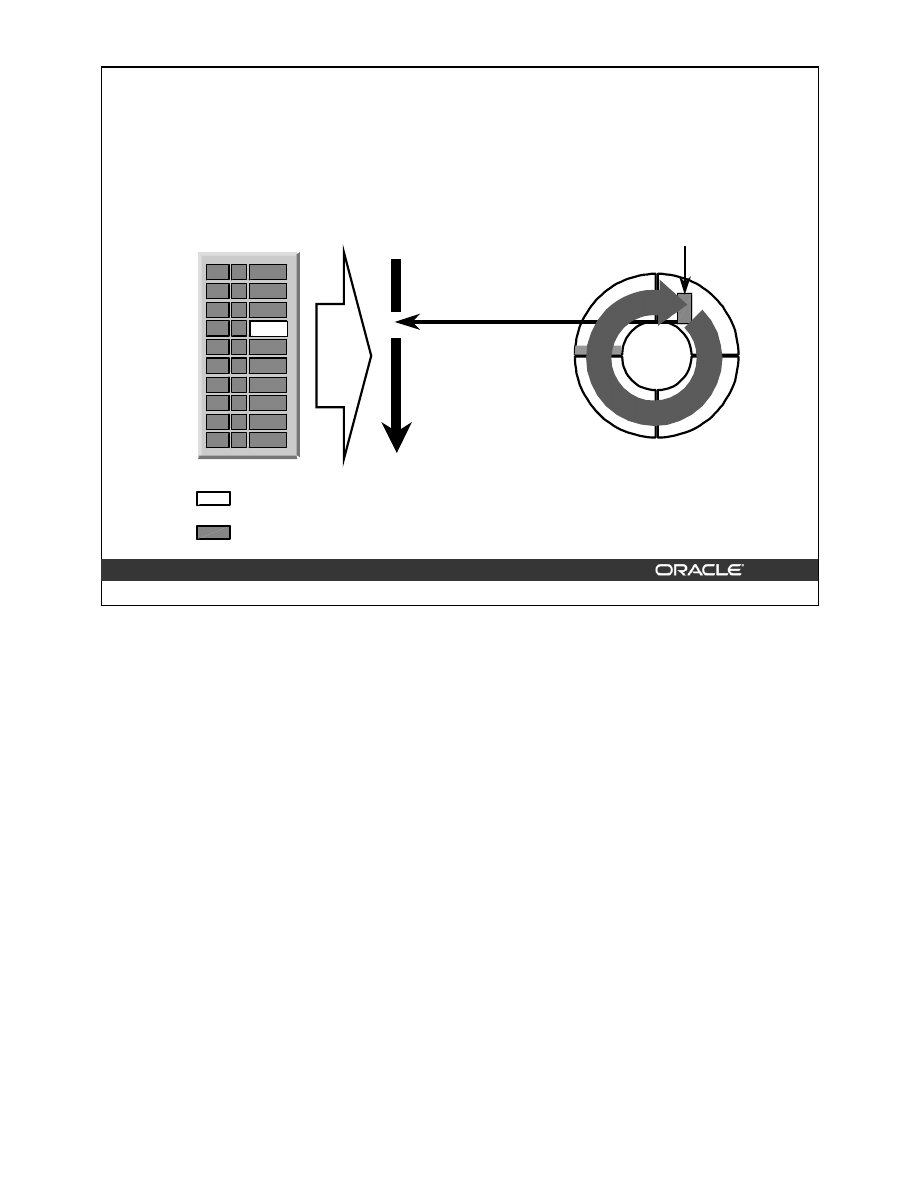
DBA Fundamentals I B
-
19
Possible Causes
To provide read consistency, the Oracle server guarantees that changes made by other users
that are not committed when the statement begins or are made after the statement begins
execution are not seen by the statement. If the Oracle server cannot construct a read-
consistent image of data, the user will receive an
ORA-01555 SNAPSHOT TOO OLD
error. This error can occur when the transaction that made the change has already committed
and:
• The transaction slot in the rollback header has been reused.
• The before image in the rollback segment has been overwritten by another transaction.
Solution
Read-consistency errors can be minimized by ensuring that rollback segments are created
with:
• A higher
MINEXTENTS
value
• Larger extent sizes
• A higher
OPTIMAL
value
Note that these errors cannot be avoided by increasing
MAXEXTENTS
.
B-19
Copyright © Oracle Corporation, 2001. All rights reserved.
Image at statement commencement
New image
Table
SELECT *
FROM table
Read-Consistency Error
Reused block

DBA Fundamentals I B
-
20
Possible Causes
When an extent in a rollback segment is full, the Oracle server attempts to reuse the next
extent in the segment. If this new extent contains one active entry—that is, an entry by a
transaction that is still active—it cannot be used. In these cases, a rollback segment allocates
an additional extent. The transaction cannot skip an extent in the ring and continue writing to
a subsequent extent. A transaction that has made only a few changes, but has been idle for a
long time could cause rollback segments to grow even though there are many free extents. In
this situation, a lot of space is wasted and a database administrator may need to intervene to
avoid excessive rollback segment growth.
B-20
Copyright © Oracle Corporation, 2001. All rights reserved.
Blocking Session
Extent 3
Existing extent
New extent
4
1
3
2
1
2
3
4
5
Blocking
session

DBA Fundamentals I B
-
21
Possible Causes (continued)
Solution
Query
V$ROLLSTAT
,
V$SESSION
, and
V$TRANSACTION
views to find any blocking
transactions.
Example
SQL> SELECT s.sid, s.serial#, t.start_time, t.xidusn,
s.username
2 FROM v$session s, v$transaction t, v$rollstat r
3 WHERE s.saddr = t.ses_addr
4 AND t.xidusn = r.usn
5 AND ((r.curext = t.start_uext-1) OR
6 ((r.curext = r.extents-1) AND t.start_uext=0));
SID
SERIAL#
START_TIME
XIDUSN USERNAME
---
-------
------------------
-------
------
9
27
10/30/97 21:10:41
2 SYSTEM
1 row selected.
Check whether the transaction can be ended by the user. If not, it may be necessary to kill the
session.

DBA Fundamentals I B
-
22
Problem Diagnosis and Resolution
If a tablespace contains one or more active rollback segments, it cannot be taken offline. The
session executing the statement receives an ORA-01546 error message.
Solution
Perform the following steps:
1. Query
DBA_ROLLBACK_SEGS
to find which rollback segments are in the tablespace.
2. Take all rollback segments in the tablespace offline.
3. Check
V$TRANSACTION
to find which transactions are currently using these rollback
segments.
4. Use
V$SESSION
to obtain the user name and session information.
5. Kill the session or have the user end the transaction.
6. Take the tablespace offline.
B-22
Copyright © Oracle Corporation, 2001. All rights reserved.
Error in Taking a Tablespace Offline
You cannot take a tablespace containing an active
rollback segment offline.
1. Determine which rollback segments are in the
tablespace.
2. Take all of these rollback segments offline.
3. Find active transactions using these rollback
segments.
4. Find the session ID and serial number.
5. Terminate the session, if necessary.
6. Take the tablespace offline.

DBA Fundamentals I B
-
23
B-23
Copyright © Oracle Corporation, 2001. All rights reserved.
Summary
In this lesson, you should have learned how to:
•
Create adequate rollback segments
•
Troubleshoot rollback segment problems

DBA Fundamentals I B
-
24

DBA Fundamentals I C
-
1
C
Copyright © Oracle Corporation, 2001. All rights reserved.
C
Practice Solutions for SQL*Plus

DBA Fundamentals I C
-
2
Practice 1: Solutions
1
Which one of the following statements is true?
a
An Oracle server is a collection of data consisting of three file types.
b
A user establishes a connection with the database by starting an Oracle instance.
c
A connection is a communication pathway between the Oracle Server and the
Oracle Instance.
d
A session starts when a user is validated by the Oracle server.
Answer: D
2
Which one of the following memory areas is not part of the SGA?
a
Database buffer cache
b
PGA
c
Redo log buffer cache
d
Shared Pool
Answer: B
3
Which two of the following statements are true about the Shared Pool?
a
The shared Pool consists of the Library Cache, Data Dictionary Cache, Shared SQL
area, Java Pool, and Large Pool.
b
The Shared Pool is used to store the most recently executed SQL statements and the
most recently used data.
c
The Shared Pool is used for object that can be shared globally.
d
The Library Cache consist of the Shared SQL and Shared PL/SQL areas.
Answer: B D
4
Which one of the following memory areas is used to cache the data dictionary
information?
a
Database Buffer Cache
b
PGA
c
Redo log buffer cache
d
Shared Pool
Answer: D
5
The primary purpose of the Redo Log Buffer Cache is to record all changes to the
database data blocks.
a
True
b
False
Answer: True
6
The PGA is a memory region that contains data and control information for multiple
server processes or multiple background processes.
a
True
b
False
Answer: False, A PGA is a memory region that contains data and control
information for a single server process or a single background process.

DBA Fundamentals I C
-
3
Practice 1: Solutions (continued)
7
Which one of the following processes is available when an Oracle instance is started.
a
User process
b
Background process
c
Server process
d
System process
Answer: B
8
Identify five mandatory background processes.
________________________________________
________________________________________
________________________________________
________________________________________
________________________________________
Answer: DBWR, LGWR, PMON, SMON, CKPT
9
Which one of the following memory areas is used to cache the data dictionary
information?
a
Database Buffer Cache
b
PGA
c
Redo log buffer cache
d
Shared Pool
Answer: D
10
Match the process with its task.
a
Database Writer
___ Assists with writing to the data file headers
b
Log Writer
___ Responsible for instance recovery
c
System Monitor
___ Cleans up after failed processes
d
Process Monitor
___ Can call on the Database Writer to write
e
Checkpoint
___ Writes dirty buffers to the data files
Answer: E,C,D,B,A
11
The physical structure of an Oracle database consists of control files, data files, and
redo log files.
a
True
b
False
Answer: True
12 Place the following structures in order of hierarchy beginning with database.
a
Tablespaces
b
Extent
c
Segment
d
database
e
block
Answer: D,A,C,B,E

DBA Fundamentals I C
-
4
Practice 1: Solutions (continued)
13 Identify the components of an Oracle server.
________________________________________
________________________________________
Answer: Oracle instance, Oracle database,
14 Identify the components of an Oracle instance.
________________________________________
________________________________________
Answer: SGA, Background processes
15 Identify three file types that make up an Oracle database
________________________________________
________________________________________
________________________________________
Answer: Datafiles, Control files, Redo log files

DBA Fundamentals I C
-
5
Practice 2: Solutions
1
List the common database administration tools available to a DBA.
2
Connect to SQL*Plus as SYS AS SYSDBA and start the database.
Oracle Universal Installer
Oracle Database Configuration Assistant
Password File Utility
SQL*Plus
Oracle Enterprise Manager
SQL> CONNECT / AS SYSDBA
Connected to an idle instance.
SQL> STARTUP
ORACLE instance started.
Total System Global Area 21790412 bytes
Fixed Size 278220 bytes
Variable Size 16777216 bytes
Database Buffers 4194304 bytes
Redo Buffers 540672 bytes
Database mounted.
Database opened.

DBA Fundamentals I C
-
6
Practice 2: Solutions (continued)
3
Select columns
OWNER
,
TABLE_NAME
, and
TABLESPACE_NAME
from data
dictionary view
DBA_TABLES
, and format the output. (The display of the first ten
rows is sufficient.)
Exit SQL*Plus.
SQL> COLUMN owner FORMAT a5;
SQL> COLUMN table_name FORMAT a20;
SQL> COLUMN tablespace_name FORMAT a15;
SQL> SELECT owner,table_name,tablespace_name
2 FROM
dba_tables
3 WHERE
rownum < 10;
OWNER TABLE_NAME TABLESPACE_NAME
----- -------------------- ---------------
SYS FILE$ SYSTEM
SYS BOOTSTRAP$ SYSTEM
SYS SEG$ SYSTEM
SYS ICOL$ SYSTEM
SYS PROXY_ROLE_DATA$ SYSTEM
SYS IND$ SYSTEM
SYS CDEF$ SYSTEM
SYS OBJ$ SYSTEM
SYS CCOL$ SYSTEM
9 rows selected.
SQL> EXIT

DBA Fundamentals I C
-
7
Practice 2: Solutions (continued)
4
Start SQL*Plus and run a script named
lab02_03.sql
, which spools all initialization
parameters to the output file
para.lst
.
5
Remove the current password file located in
$HOME/ADMIN/PFILE
.
Create a new password file using the following information:
- Password for sys:
oracle
- Enable five privileged users
- Location
$HOME/ADMIN/PFILE
Ensure that Oracle can write to this file by changing permissions on the file:
chmod 660 $HOME/ADMIN/PFILE/orapw$ORACLE_SID
Hint: Use the
orapwd
utility to create the password file.
Note: The password file is normally created in
$ORACLE_HOME/dbs
, owned by
the owner of
$ORACLE_HOME
, and the permissions are not changed.
SQL> @$HOME/STUDENT/LABS/lab02_03.sql
SQL> CONNECT / AS SYSDBA
Connected.
SQL> SET PAGESIZE 999
SQL> SPOOL para.lst;
SQL> SHOW parameter
NAME TYPE VALUE
------------------------------------ ----------- ----------------------
O7_DICTIONARY_ACCESSIBILITY
boolean FALSE
active_instance_count integer
aq_tm_processes integer 0
archive_lag_target integer 0
.
.
.
SQL> !rm $HOME/ADMIN/PFILE/orapw$ORACLE_SID
SQL> !orapwd file=$HOME/ADMIN/PFILE/orapw$ORACLE_SID password=oracle
entries=5
SQL> !chmod 660 $HOME/ADMIN/PFILE/orapw$ORACLE_SID

DBA Fundamentals I C
-
8
Practice 3: Solutions
1
Connect to the database as user
SYS AS SYSDBA
and shutdown the database.
2
With the database shutdown, create an
SPFILE
from the
PFILE
.
Place the
SPFILE
in directory
$HOME/ADMIN/PFILE
with the file name format
spfileSID.ora
, use your instance name in place of
SID
. Create the
SPFILE
from
the
PFILE
located in
$HOME/ADMIN/PFILE
.
SQL> CONNECT / AS SYSDBA
Connected.
SQL>
SQL> SHUTDOWN IMMEDIATE
Database closed.
Database dismounted.
ORACLE instance shut down.
SQL> CONNECT / AS SYSDBA
Connected to an idle instance.
SQL> CREATE SPFILE='$HOME/ADMIN/PFILE/spfile$ORACLE_SID.ora'
2 FROM PFILE='$HOME/ADMIN/PFILE/init$ORACLE_SID.ora';
File created.

DBA Fundamentals I C
-
9
Practice 3: Solutions (continued)
3
From the operating system, view the
SPFILE
.
4
Connect as user
SYS AS SYSDBA
, and start the database using the
SPFILE
.
SQL> !more $HOME/ADMIN/PFILE/spfile$ORACLE_SID.ora
*.background_dump_dest='/u01/home/db01/ADMIN/BDUMP'
*.compatible='9.0.0'
*.control_files='/u01/home/db01/ORADATA/u01/ctrl01.ctl'
*.core_dump_dest='/u01/home/db01/ADMIN/CDUMP'
*.db_block_size=4096
*.db_cache_size=4M
*.db_domain='world'
*.db_name='db01'
*.global_names=TRUE
*.instance_name='db01'
*.java_pool_size='0'
*.max_dump_file_size='10240'
*.remote_login_passwordfile='exclusive'
*.service_names='db01'
*.shared_pool_size=8M
*.undo_management='AUTO'
*.undo_tablespace='UNDOTBS'
*.user_dump_dest='/u01/home/db01/ADMIN/UDUMP'
SQL> CONNECT / AS SYSDBA
Connected to an idle instance.
SQL> STARTUP
ORACLE instance started.
Total System Global Area 21790412 bytes
Fixed Size 278220 bytes
Variable Size 16777216 bytes
Database Buffers 4194304 bytes
Redo Buffers 540672 bytes
Database mounted.
Database opened.

DBA Fundamentals I C
-
10
Practice 3: Solutions (continued)
5
Shutdown the database and open it in read-only mode. Connect as user
HR
password
HR
and and insert the following into the
REGIONS
table.
INSERT INTO regions VALUES ( 5, ‘Mars’ );
What happens? Put the database back in read-write mode.
SQL> CONNECT / AS SYSDBA
Connected.
SQL> SHUTDOWN IMMEDIATE
Database closed.
Database dismounted.
ORACLE instance shut down.
SQL> STARTUP MOUNT
ORACLE instance started.
Total System Global Area 21790412 bytes
Fixed Size 278220 bytes
Variable Size 16777216 bytes
Database Buffers 4194304 bytes
Redo Buffers 540672 bytes
Database mounted.
SQL> ALTER DATABASE OPEN READ ONLY;
Database altered.
SQL> CONNECT hr/hr
Connected.
SQL> INSERT INTO regions VALUES ( 5, 'Mars');
INSERT INTO regions VALUES ( 5, 'Mars')
*
ERROR at line 1:
ORA-01552: cannot use system rollback segment for non-system tablespace
‘SAMPLE'
SQL> CONNECT / AS SYSDBA
Connected.
SQL> SHUTDOWN IMMEDIATE
Database closed.
Database dismounted.
ORACLE instance shut down.
SQL> STARTUP
ORACLE instance started.

DBA Fundamentals I C
-
11
Practice 3: Solutions (continued)
6
Connect as user
HR
password
HR
and insert the following row into the table
REGIONS
;
do not commit or exit.
INSERT INTO regions VALUES ( 5, ‘Mars’ );
In a new telnet session start SQL*Plus. Connect as
SYS AS SYSDBA
and perform
a shut down transactional.
What happens? Rollback the insert in the
HR
session and exit, what happens?
Note: Parameter
UNDO_RETENTION
, which will be discussed in Managing Undo
Data, is set to 15 minutes by default. Because of this parameter it could be
15 minutes before the database shuts down after the
ROLLBACK
command is
executed. Connect to another session as
SYS AS SYSDBA
and execute the
following command to speed up the process.
ALTER SYSTEM SET undo_retention=0 SCOPE=MEMORY;
HR SESSION
SQL> CONNECT hr/hr
Connected.
SQL> INSERT INTO regions VALUES (5, 'Mars');
1 row created.
SYS SESSION
SQL> CONNECT / AS SYSDBA
Connected.
SQL> SHUTDOWN TRANSACTIONAL
HR SESSION
SQL> ROLLBACK;
Rollback complete.
SQL> EXIT;
ERROR:
ORA-01089: immediate shutdown in progress - no operations are permitted
Disconnected from Oracle9i Enterprise Edition Release 9.0.0.0.0 - Beta
With the Partitioning option
JServer Release 9.0.0.0.0 - Beta (with complications)
SYS SESSION
Database closed.
Database dismounted.
ORACLE instance shut down.
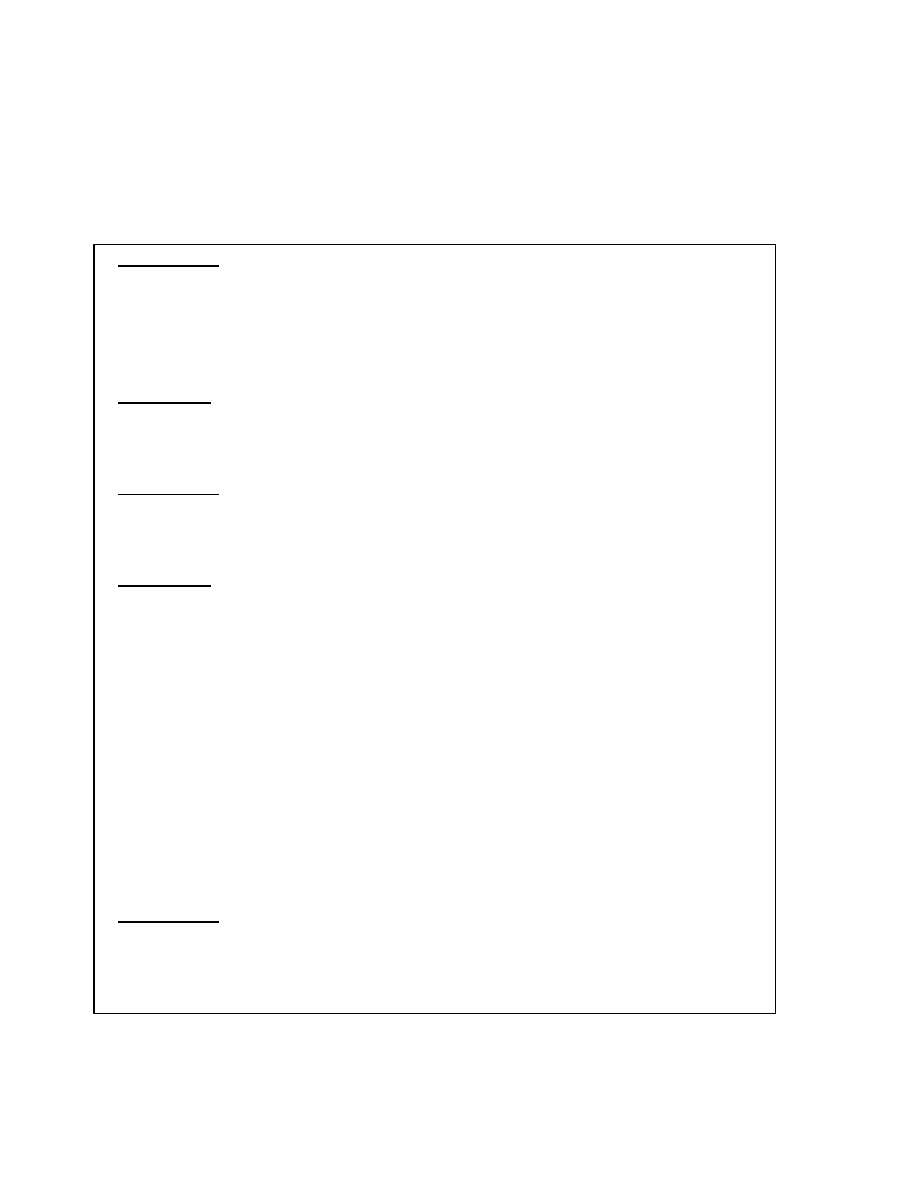
DBA Fundamentals I C
-
12
Practice 3: Solutions (continued)
7
Make sure the database is started. Keep the two SQL*Plus sessions open, one
session as user
SYS AS SYSDBA
and one as user
HR
. As user
SYS AS
SYSDBA
enable restricted session. As user
HR
select from the regions table. Is
the select successful? In the
HR
session exit SQL*Plus then reconnect as
HR
.
What happens? Disable restricted session.
SYS SESSION
SQL> CONNECT / AS SYSDBA
Connected to an idle instance.
SQL> STARTUP
ORACLE instance started.
HR SESSION
SQL> CONNECT hr/hr
Connected.
SYS SESSION
SQL> ALTER SYSTEM ENABLE RESTRICTED SESSION;
System altered.
HR SESSION
SQL> SELECT *
2 FROM regions;
REGION_ID REGION_NAME
---------- -------------------------
1 Europe
2 Americas
3 Asia
4 Middle East and Africa
SQL> CONNECT hr/hr
ERROR:
ORA-01035: ORACLE only available to users with RESTRICTED SESSION
privilege
Warning: You are no longer connected to ORACLE.
SYS SESSION
SQL> ALTER SYSTEM DISABLE RESTRICTED SESSION;
System altered.

DBA Fundamentals I C
-
13
Practice 5: Solutions
1
Which of the following statements are true about the data dictionary?
a
The data dictionary describes the database and its objects.
b
The data dictionary includes two types of objects: base tables, data dictionary views.
c
The data dictionary is a set of tables.
d
The data dictionary records and verifies information about its associated database.
Answer: All of the Above
2
Base tables are created using the catalog.sql script.
a
True
b
False
Answer: False, sql.bsq script
3
Which three of the following statements are true about how the data dictionary is used?
a
The Oracle server modifies it when a DML statement is executed.
b
It is used to find information about users, schema objects, and storage structures.
c
Used by users and DBAs as a reference.
d
The data dictionary is a necessary ingredient for the database to function.
Answer: B,C,D
4
Data dictionary views are static views.
a
True
b
False
Answer: True
5
The information for a Dynamic Performance table is gathered from the control file
and memory.
a
True
b
False
Answer: True
6
Which of the following questions might a dynamic performance view answer?
a
Is the object online and available?
b
What locks are being held?
c
Who owns the object?
d
What privileges do users have?
e
Is the session active?
Answer: A,B,E

DBA Fundamentals I C
-
14
Practice 5: Solutions (continued)
7
Find a list of the data dictionary views.
SQL> CONNECT / AS SYSDBA
Connected.
SQL> SELECT table_name
2 FROM dictionary;
TABLE_NAME
------------------------------
ALL_ALL_TABLES
ALL_ARGUMENTS
ALL_ASSOCIATIONS
ALL_AUDIT_POLICIES
ALL_BASE_TABLE_MVIEWS
ALL_CATALOG
ALL_CLUSTERS
ALL_CLUSTER_HASH_EXPRESSIONS
ALL_COLL_TYPES
.
.
.

DBA Fundamentals I C
-
15
Practice 5: Solutions (continued)
8
Identify the database name, instance name, and size of the database blocks.
Hint: Query the Dynamic Views
V$DATABASE
,
V$THREAD
, and
V$PARAMETER
.
9
List the name and size of the data files, online redo log files, and the name of the
control files.
Hint: Query the Dynamic Views
V$DATAFILE
,
V$LOGFILE
, and
V$CONTROLFILE
.
SQL> SELECT name
2 FROM v$database;
NAME
---------
DB01
SQL> SELECT instance
2 FROM v$thread;
INSTANCE
----------------
db01
SQL> SELECT value
2 FROM v$parameter
3 WHERE name ='db_block_size';
VALUE
--------------------------------
4096
SQL> SELECT name
2 FROM v$datafile;
NAME
------------------------------------------------------------------
/u01/home/db01/ORADATA/u01/system01.dbf
/u01/home/db01/ORADATA/u02/undotbs.dbf
/u01/home/db01/ORADATA/u03/users01.dbf
/u01/home/db01/ORADATA/u03/indx01.dbf
/u01/home/db01/ORADATA/u02/sample01.dbf
/u01/home/db01/ORADATA/u01/querydata01.dbf
6 rows selected.

DBA Fundamentals I C
-
16
Practice 5: Solutions (continued)
10
Identify the data file that makes up the
SYSTEM
tablespace.
Hint: Query the data dictionary view
DBA_DATA_FILES
to identify the data files
that make up
SYSTEM
tablespace.
11
How much free space is available in the database and how much is already used?
Hints:
-
Query the data dictionary view
DBA_FREE_SPACE
to show how much free
space is available in the database.
-
Query the data dictionary view
DBA_SEGMENTS
to display how much space
is already used.
SQL> SELECT file_name
2 FROM
dba_data_files
3 WHERE tablespace_name = 'SYSTEM';
FILE_NAME
---------------------------------------
/u01/home/db01/ORADATA/u01/system01.dbf
SQL> SELECT sum(bytes)/1024 "free space in KB"
2 FROM
dba_free_space;
free space in KB
----------------
42700
SQL> SELECT sum(bytes)/1024 "used space in KB"
2 FROM
dba_segments;
used space in KB
----------------
131992

DBA Fundamentals I C
-
17
Practice 5: Solutions (continued)
12
List the name and creation date of the database users.
Hint: Query the data dictionary view
DBA_USERS
to list the name and the creation
of the database users.
SQL> SELECT username, created
2 FROM
dba_users;
USERNAME CREATED
------------------------------ ---------
SYS 16-APR-01
SYSTEM 16-APR-01
OUTLN 16-APR-01
DBSNMP 16-APR-01
ORDSYS 16-APR-01
ORDPLUGINS 16-APR-01
MDSYS 16-APR-01
HR 16-APR-01
OE 16-APR-01
9 rows selected.

DBA Fundamentals I C
-
18
Practice 6: Solutions
1
Where is the existing control file located and what is the name?
Hint: Query the dynamic performance view
V$CONTROLFILE
or
V$PARAMETER
, or execute the
SHOW PARAMETER
command to
display the name and the location of the control file.
2
Try to start the database without any control files. (Simulate this by changing the
name of the control file in the parameter file or changing the control file name.)
What happens?
SQL> COL name FORMAT a50
SQL> SELECT *
2 FROM v$controlfile;
STATUS NAME
------- --------------------------------------
/u01/home/db01/ORADATA/u01/ctrl01.ctl
SQL> CONNECT / AS SYSDBA
Connected.
SQL> SHUTDOWN IMMEDIATE
Database closed.
Database dismounted.
ORACLE instance shut down.
SQL> !cp $HOME/ORADATA/u01/ctrl01.ctl $HOME/ORADATA/u01/ctrl01.bak
SQL> !rm $HOME/ORADATA/u01/ctrl01.ctl
SQL> STARTUP
ORACLE instance started.
Total System Global Area 21790412 bytes
Fixed Size 278220 bytes
Variable Size 16777216 bytes
Database Buffers 4194304 bytes
Redo Buffers 540672 bytes
ORA-00205: error in identifying controlfile, check alert log for more
info
SQL> SHUTDOWN IMMEDIATE
ORA-01507: database not mounted
ORACLE instance shut down.
SQL> !cp $HOME/ORADATA/u01/ctrl01.bak $HOME/ORADATA/u01/ctrl01.ctl
SQL> STARTUP
ORACLE instance started.

DBA Fundamentals I C
-
19
Practice 6: Solutions (continued)
3
Multiplex the existing control file, using the directory
u02
, and name the new control
file
ctrl02.ctl
. Make sure that the Oracle Server is able to write to the new
control file. For example, on Unix use the command
chmod 660
. Confirm that both
control files are being used.
Hints:
-
Before shutting down the database alter the
SPFILE (SCOPE=SPILE)
to add
the new control file to the initialization file.
-
Shut down the database, and copy the existing control file to a new file
with the name
ctrl02.ctl
in the directory
u02
. Use the command
chmod 660
on Unix. Normally the permissions on the file would not
be changed, this is for the classroom environment.
-
Start up the database.
-
Query the Dynamic View
V$CONTROLFILE
or
V$PARAMETER
, or use
the
SHOW PARAMETER
command to confirm that both control files are
being used.
SQL> CONNECT / AS SYSDBA
Connected.
SQL> ALTER SYSTEM SET control_files = '$HOME/ORADATA/u01/ctrl01.ctl',
'$HOME/ORADATA/u02/ctrl02.ctl' SCOPE=SPFILE;
System altered.
SQL> SHUTDOWN IMMEDIATE;
Database closed.
Database dismounted.
ORACLE instance shut down.
SQL> !cp $HOME/ORADATA/u01/ctrl01.ctl $HOME/ORADATA/u02/ctrl02.ctl
SQL> !chmod 660 $HOME/ORADATA/u02/ctrl02.ctl
SQL> STARTUP
ORACLE instance started.
Database mounted.
Database opened.
SQL> SELECT name
2 FROM v$controlfile;
NAME
--------------------------------------
/u01/home/db01/ORADATA/u01/ctrl01.ctl
/u01/home/db01/ORADATA/u02/ctrl02.ctl

DBA Fundamentals I C
-
20
Practice 6: Solutions (continued)
4
What is the initial sizing of the data file section in your control file?
Hint: Query the Dynamic View
V$CONTROLFILE_RECORD_SECTION
.
SQL> SELECT records_total
2 FROM v$controlfile_record_section
3 WHERE type = 'DATAFILE';
RECORDS_TOTAL
-------------
40

DBA Fundamentals I C
-
21
Practice 7: Solutions
1
List the number and location of existing log files and display the number of redo
log file groups and members your database has.
Hints:
-
Query the dynamic view
V$LOGFILE
.
-
Use the dynamic view
V$LOG
.
2
In which database mode is your database configured? Is archiving enabled?
Hints:
-
Query the dynamic view
V$DATABASE
.
-
Query the dynamic view
V$INSTANCE
.
SQL> SELECT member
2 FROM v$logfile;
MEMBER
-------------------------------------
/u01/home/db01/ORADATA/u03/log02a.rdo
/u01/home/db01/ORADATA/u03/log01a.rdo
SQL> SELECT group#, members
2 FROM v$log;
GROUP# MEMBERS
---------- ----------
1 1
2 1
SQL> SELECT log_mode
2 FROM v$database;
LOG_MODE
------------
NOARCHIVELOG
SQL> SELECT archiver
2 FROM v$instance;
ARCHIVE
-------
STOPPED

DBA Fundamentals I C
-
22
Practice 7: Solutions (continued)
3
Add a redo log member to each group in your database located on
u04
, using the
following naming conventions:
Add member to Group 1:
log01b.rdo
Add member to Group 2:
log02b.rdo
Verify the result.
Hints:
-
Execute the
ALTER DATABASE ADD LOGFILE MEMBER
command
to add a redo log member to each group.
-
Query the dynamic performance view
V$LOGFILE
to verify the result.
SQL> ALTER DATABASE ADD LOGFILE MEMBER
2 '$HOME/ORADATA/u04/log01b.rdo' to Group 1,
3 '$HOME/ORADATA/u04/log02b.rdo' to Group 2;
Database altered.
SQL> COLUMN GROUP# FORMAT 99
SQL> COLUMN MEMBER FORMAT a40
SQL> SELECT *
2 FROM v$logfile;
GROUP# STATUS TYPE MEMBER
------ ------- ------- -------------------------------------
2 ONLINE /u01/home/db01/ORADATA/u03/log02a.rdo
1 STALE ONLINE /u01/home/db01/ORADATA/u03/log01a.rdo
1 INVALID ONLINE /u01/home/db01/ORADATA/u04/log01b.rdo
2 INVALID ONLINE /u01/home/db01/ORADATA/u04/log02b.rdo

DBA Fundamentals I C
-
23
Practice 7: Solutions (continued)
4
Add a redo log group in your database with two members located on
u03
and
u04
using the following naming conventions:
Add Group 3:
log03a.rdo
and
log03b.rdo
Verify the result.
Hints:
-
Execute the
ALTER DATABASE ADD LOGFILE
command to create
a new group.
-
Query the Dynamic View
V$LOGFILE
to display the name
of the new members of the new group.
-
Query the Dynamic View
V$LOG
to display the number of
redo log file groups and members.
SQL> ALTER DATABASE ADD
2 LOGFILE GROUP 3(
3 '$HOME/ORADATA/u03/log03a.rdo',
4 '$HOME/ORADATA/u04/log03b.rdo'
5 ) SIZE 1024K;
Database altered.
SQL> COLUMN GROUP# FORMAT 99
SQL> COLUMN MEMBER FORMAT a40
SQL> SELECT *
2 FROM v$logfile;
GROUP# STATUS TYPE MEMBER
------ ------- ------- ----------------------------------------
2 ONLINE /u01/home/db01/ORADATA/u03/log02a.rdo
1 STALE ONLINE /u01/home/db01/ORADATA/u03/log01a.rdo
1 INVALID ONLINE /u01/home/db01/ORADATA/u04/log01b.rdo
2 INVALID ONLINE /u01/home/db01/ORADATA/u04/log02b.rdo
3 ONLINE /u01/home/db01/ORADATA/u03/log03a.rdo
3 ONLINE /u01/home/db01/ORADATA/u04/log03b.rdo
6 rows selected.
SQL> SELECT group#, members
2 FROM v$log;
GROUP# MEMBERS
------ ----------
1 2
2 2
3 2

DBA Fundamentals I C
-
24
Practice 7: Solutions (continued)
5
Remove the redo log group created in step 4.
Hints:
-
Execute the
ALTER DATABASE DROP LOGFILE GROUP
command to
remove the log group.
-
Query the Dynamic View
V$LOG
to verify the result.
-
Remove the operating system files for the group
SQL> ALTER SYSTEM SWITCH LOGFILE;
System altered.
SQL> ALTER SYSTEM SWITCH LOGFILE;
System altered.
SQL> ALTER SYSTEM SWITCH LOGFILE;
System altered.
SQL> SELECT group#, members
2 FROM v$log;
GROUP# MEMBERS
------ ----------
1 2
2 2
3 2
SQL> ALTER DATABASE DROP LOGFILE GROUP 3;
Database altered.
SQL> !rm $HOME/ORADATA/u03/log03a.rdo
SQL> !rm $HOME/ORADATA/u04/log03b.rdo

DBA Fundamentals I C
-
25
Practice 7: Solutions (continued)
6
Resize all online redo log files to 1024 KB. (Because we cannot resize log files,
we have to add new logs and drop the old.)
Hints:
-
Execute the
ALTER DATABASE ADD LOGFILE GROUP
command
to add two new groups with the size 1024 KB.
-
Query the Dynamic View
V$LOG
to check the active group.
-
Execute the
ALTER SYSTEM SWITCH LOGFILE
command to force log
switches and change the group stage to inactive. The number of log switches
required will vary.
-
Execute the
ALTER DATABASE DROP LOGFILE
command to remove
the inactive groups.
-
Query the Dynamic View
V$LOG
to verify the result.
SQL> ALTER DATABASE ADD LOGFILE
2 GROUP 3( '$HOME/ORADATA/u03/log03a.rdo',
3 '$HOME/ORADATA/u04/log03b.rdo'
4 ) SIZE 1024K,
5 GROUP 4( '$HOME/ORADATA/u03/log04a.rdo',
6 '$HOME/ORADATA/u04/log04b.rdo'
7 ) SIZE 1024K
8 ;
Database altered.
SQL> SELECT group#, status
2 FROM v$log;
GROUP# STATUS
------ ----------------
1 ACTIVE
2 CURRENT
3 UNUSED
4 UNUSED
SQL> ALTER SYSTEM SWITCH LOGFILE;
System altered.
SQL> ALTER SYSTEM SWITCH LOGFILE;
System altered.
SQL> ALTER SYSTEM SWITCH LOGFILE;
System altered.
SQL> ALTER SYSTEM SWITCH LOGFILE;
System altered.

DBA Fundamentals I C
-
26
Practice 7: Solutions (continued)
SQL> ALTER DATABASE DROP LOGFILE GROUP 1, GROUP 2;
Database altered.
SQL> SELECT group#, bytes
2 FROM v$log;
GROUP# BYTES
------ ----------
3 1048576
4 1048576

DBA Fundamentals I C
-
27
Practice 8: Solutions
1
Create permanent tablespaces with the following names and storage:
a
DATA01
data dictionary managed.
b
DATA02
locally managed with uniform sized extents (Ensure that every used extent
size in the tablespace is a multiple of 100 KB.)
c
INDX01
locally managed with uniform sized extents of 4K
( Enable automatic extension of 500 KB when more extents are required with a
maximum size of 2 MB. )
d
RONLY
for read-only tables with the default storage. DO NOT make the tablespace
read only at this time.
Display the information from the data dictionary.
SQL> CREATE TABLESPACE data01
2 DATAFILE '$HOME/ORADATA/u04/data01.dbf' SIZE 2M
3 EXTENT MANAGEMENT DICTIONARY;
Tablespace created.
SQL> CREATE TABLESPACE data02
2 DATAFILE '$HOME/ORADATA/u03/data02.dbf' SIZE 1M
3 EXTENT MANAGEMENT LOCAL UNIFORM SIZE 100K;
Tablespace created.
SQL> CREATE TABLESPACE indx01
2 DATAFILE '$HOME/ORADATA/u02/indx01.dbf' SIZE 1M
3 AUTOEXTEND ON NEXT 500K MAXSIZE 2M
4 EXTENT MANAGEMENT LOCAL UNIFORM SIZE 4K;
Tablespace created.
SQL> CREATE TABLESPACE ronly
2 DATAFILE '$HOME/ORADATA/u01/ronly01.dbf' SIZE 1M;
Tablespace created.

DBA Fundamentals I C
-
28
Practice 8: Solutions (continued)
2
Allocate 500K more disk space to tablespace
DATA02. V
erify the result.
SQL> COLUMN name FORMAT a50
SQL> SET LINESIZE 80
SQL> SET PAGESIZE 999
SQL> SELECT name, bytes, create_bytes
2 FROM v$datafile;
NAME BYTES CREATE_BYTES
-------------------------------------------- --------- ------------
/u01/home/db01/ORADATA/u01/system01.dbf 131072000
0
/u01/home/db01/ORADATA/u02/undotbs.dbf 31457280
0
/u01/home/db01/ORADATA/u03/users01.dbf 5242880
0
/u01/home/db01/ORADATA/u03/indx01.dbf 5242880
0
/u01/home/db01/ORADATA/u02/example01.dbf 5242880
0
/u01/home/db01/ORADATA/u01/querydata01.dbf 1048576
0
/u01/home/db01/ORADATA/u04/data01.dbf 2097152
2097152
/u01/home/db01/ORADATA/u03/data02.dbf 1048576
1048576
/u01/home/db01/ORADATA/u02/indx01.dbf 1048576
1048576
/u01/home/db01/ORADATA/u01/ronly01.dbf
1048576
1048576
10 rows selected.
SQL> ALTER DATABASE
2 DATAFILE '$HOME/ORADATA/u03/data02.dbf' RESIZE 1500K;
Database altered.
SQL> COLUMN name FORMAT a40
SQL> SELECT name, bytes, create_bytes
2 FROM v$datafile
3 WHERE name LIKE '%data02%‘;
NAME BYTES CREATE_BYTES
---------------------------------------- ---------- ------------
/u01/home/db02/ORADATA/u03/data02.dbf 1536000 1048576

DBA Fundamentals I C
-
29
Practice 8: Solutions (continued)
3
Relocate tablespace
INDX01
to subdirectory
u06
.
SQL> ALTER TABLESPACE indx01 OFFLINE;
Tablespace altered.
SQL> SELECT name, status
2 FROM v$datafile;
NAME STATUS
-------------------------------------------------- -------
/u01/home/db01/ORADATA/u01/system01.dbf SYSTEM
/u01/home/db01/ORADATA/u02/undotbs.dbf ONLINE
/u01/home/db01/ORADATA/u03/users01.dbf ONLINE
/u01/home/db01/ORADATA/u03/indx01.dbf ONLINE
/u01/home/db01/ORADATA/u02/sample01.dbf
ONLINE
/u01/home/db01/ORADATA/u01/querydata01.dbf ONLINE
/u01/home/db01/ORADATA/u04/data01.dbf ONLINE
/u01/home/db01/ORADATA/u03/data02.dbf ONLINE
/u01/home/db01/ORADATA/u02/indx01.dbf OFFLINE
/u01/home/db01/ORADATA/u01/ronly01.dbf ONLINE
10 rows selected.
SQL> !mv $HOME/ORADATA/u02/indx01.dbf $HOME/ORADATA/u06/indx01.dbf
SQL> ALTER TABLESPACE indx01
2 RENAME DATAFILE
3 '$HOME/ORADATA/u02/indx01.dbf' TO
4 '$HOME/ORADATA/u06/indx01.dbf';
Tablespace altered.
SQL> ALTER TABLESPACE indx01 ONLINE;
Tablespace altered.

DBA Fundamentals I C
-
30
Practice 8: Solutions (continued)
SQL> SELECT name, status
2 FROM v$datafile;
NAME STATUS
-------------------------------------------------- -------
/u01/home/db01/ORADATA/u01/system01.dbf SYSTEM
/u01/home/db01/ORADATA/u02/undotbs.dbf ONLINE
/u01/home/db01/ORADATA/u03/users01.dbf ONLINE
/u01/home/db01/ORADATA/u03/indx01.dbf ONLINE
/u01/home/db01/ORADATA/u02/sample01.dbf
ONLINE
/u01/home/db01/ORADATA/u01/querydata01.dbf ONLINE
/u01/home/db01/ORADATA/u04/data01.dbf ONLINE
/u01/home/db01/ORADATA/u03/data02.dbf ONLINE
/u01/home/db01/ORADATA/u06/indx01.dbf ONLINE
/u01/home/db01/ORADATA/u01/ronly01.dbf ONLINE
10 rows selected.

DBA Fundamentals I C
-
31
Practice 8: Managing Tablespaces and Data Files
4
Create a table in tablespace
RONLY
. Make tablespace
RONLY
read-only.
Attempt to create an additional table. Drop the first created table. What happens
and why?
SQL> CREATE TABLE table1 ( x CHAR(1))
2 TABLESPACE ronly;
Table created.
SQL> ALTER TABLESPACE ronly READ ONLY;
Tablespace altered.
SQL> SELECT name, enabled, status
2 FROM v$datafile;
NAME ENABLED STATUS
-------------------------------------------------- ---------- ------
/u01/home/db01/ORADATA/u01/system01.dbf READ WRITE SYSTEM
/u01/home/db01/ORADATA/u02/undotbs.dbf READ WRITE ONLINE
/u01/home/db01/ORADATA/u03/users01.dbf READ WRITE ONLINE
/u01/home/db01/ORADATA/u03/indx01.dbf READ WRITE ONLINE
/u01/home/db01/ORADATA/u02/example01.dbf READ WRITE ONLINE
/u01/home/db01/ORADATA/u01/querydata01.dbf READ ONLY ONLINE
/u01/home/db01/ORADATA/u04/data01.dbf READ WRITE ONLINE
/u01/home/db01/ORADATA/u03/data02.dbf READ WRITE ONLINE
/u01/home/db01/ORADATA/u06/indx01.dbf READ WRITE ONLINE
/u01/home/db01/ORADATA/u01/ronly01.dbf READ ONLY ONLINE
10 rows selected.
SQL> CREATE TABLE table2 ( y CHAR(1))
2 TABLESPACE ronly;
CREATE TABLE table2 ( y CHAR(1))
*
ERROR at line 1:
ORA-01647: tablespace 'RONLY' is read only, cannot allocate space in it
SQL> DROP TABLE table1;
Table dropped.

DBA Fundamentals I C
-
32
Practice 8: Solutions (continued)
5
Drop tablespace
RONLY
and the associated datafile. Verify it.
SQL> DROP TABLESPACE ronly INCLUDING CONTENTS AND DATAFILES;
Tablespace dropped.
SQL> SELECT *
2 FROM v$tablespace;
TS# NAME INC
------- ------------- ---
0 SYSTEM YES
1 UNDOTBS YES
3 USERS YES
4 INDX YES
5 SAMPLE
YES
2 TEMP YES
6 QUERY_DATA YES
7 DATA01 YES
8 DATA02 YES
9 INDX01 YES
10 rows selected.
SQL> !ls $HOME/ORADATA/u01/*
/u01/home/db01/ORADATA/u01/ctrl01.bak
/u01/home/db01/ORADATA/u01/querydata01.dbf
/u01/home/db01/ORADATA/u01/ctrl01.ctl
/u01/home/db01/ORADATA/u01/system01.dbf

DBA Fundamentals I C
-
33
Practice 8: Solutions (continued)
6
Set
DB_CREATE_FILE_DEST
to
$HOME/ORADATA/u05
in memory only. Create
tablespace
DATA03
size 5M. Do not specify a file location. Verify the creation of the
data file.
SQL> ALTER SYSTEM SET DB_CREATE_FILE_DEST='$HOME/ORADATA/u05'
SCOPE=MEMORY;
System altered.
SQL> CREATE TABLESPACE data03
2 DATAFILE SIZE 5M;
Tablespace created.
SQL> SELECT *
2 FROM v$tablespace;
TS# NAME INC
------- ------------- ---
0 SYSTEM YES
1 UNDOTBS YES
3 USERS YES
4 INDX YES
5 SAMPLE
YES
2 TEMP YES
6 QUERY_DATA YES
7 DATA01 YES
8 DATA02 YES
9 INDX01 YES
11 DATA03 YES
11 rows selected.
SQL> !ls $HOME/ORADATA/u05
ora_data03_xg17n9nd.dbf

DBA Fundamentals I C
-
34
Practice 9: Solutions
1
As user
SYSTEM
, run the
lab09_01.sql
script to create tables and indexes.
SQL> @$HOME/STUDENT/LABS/lab09_01.sql
SQL> CONNECT system/manager
Connected.
SQL> CREATE TABLE emp ( empno NUMBER(4),
2 ename VARCHAR2(30),
3 job VARCHAR2(9),
4 mgr NUMBER(4),
5 hiredate DATE,
6 sal NUMBER(7,2),
7 comm NUMBER(7,2),
8 deptno NUMBER(2) )
9 TABLESPACE data01
10 STORAGE ( INITIAL 100K
11 NEXT 100K
12 PCTINCREASE 0
13 MINEXTENTS 8
14 MAXEXTENTS 10 );
Table created.
SQL> CREATE TABLE fragment1( a NUMBER )
2 TABLESPACE data01
3 STORAGE( INITIAL 10K );
Table created.
SQL> CREATE TABLE dept ( deptno NUMBER,
2 dname VARCHAR2(15),
3 loc VARCHAR2(20) )
4 TABLESPACE data01
5 STORAGE( INITIAL 50K
6 NEXT 50K );
Table created.
SQL> CREATE TABLE fragment2( a NUMBER )
2 TABLESPACE data01
3 STORAGE ( INITIAL 8K );
Table created.

DBA Fundamentals I C
-
35
Practice 9: Solutions (continued)
SQL> CREATE TABLE big_emp ( empno NUMBER(4),
2 ename VARCHAR2(30) )
3 TABLESPACE data01
4 STORAGE ( INITIAL 1M
5 NEXT 1M
6 MAXEXTENTS 10 );
Table created.
SQL> CREATE INDEX i_e_empno
2 ON emp(ename)
3 TABLESPACE indx01
4 STORAGE ( INITIAL 50K
5 NEXT 50K );
Index created.
SQL> DROP TABLE fragment1;
Table dropped.
SQL> DROP TABLE fragment2;
Table dropped.

DBA Fundamentals I C
-
36
Practice 9: Solutions (continued)
2
Identify the different types of segments in the database.
SQL> CONNECT system/manager
Connected.
SQL> SELECT DISTINCT segment_type
2 FROM
dba_segments;
SEGMENT_TYPE
------------------
CACHE
CLUSTER
INDEX
INDEX PARTITION
LOBINDEX
LOBSEGMENT
NESTED TABLE
ROLLBACK
TABLE
TABLE PARTITION
TYPE2 UNDO
11 rows selected.

DBA Fundamentals I C
-
37
Practice 9: Solutions (continued)
3
Write a query to check which segments are within five extents short of the maximum
extents. Ignore the bootstrap segment. This query is useful in identifying any segments
that are likely to generate errors during future data load.
4
Which files have space allocated for the
EMP
table?
SQL> CONNECT system/manager
Connected.
SQL> COLUMN segment_name FORMAT a20
SQL> COLUMN segment_type FORMAT a15
SQL> SELECT segment_name,segment_type,
2 max_extents, extents
3 FROM
dba_segments
4 WHERE extents+5 > max_extents
5 AND segment_type<>'CACHE';
SEGMENT_NAME SEGMENT_TYPE MAX_EXTENTS EXTENTS
-------------------- --------------- ----------- ----------
EMP TABLE 10 8
SQL> CONNECT system/manager
Connected.
SQL> SELECT DISTINCT f.file_name
2 FROM
dba_extents e,dba_data_files f
3 WHERE e.segment_name='EMP'
4 AND e.file_id=f.file_id;
FILE_NAME
-------------------------------------
/u01/home/db01/ORADATA/u04/data01.dbf

DBA Fundamentals I C
-
38
Practice 9: Solutions (continued)
5
Run the
lab09_05.sql
script.
6
List the free space available by tablespace. The query should display the number of
fragments, the total free space, and the largest free extent in each tablespace.
SQL> @$HOME/STUDENT/LABS/lab09_05.sql
SQL> CONNECT / AS SYSDBA;
Connected.
SQL> SELECT tablespace_name,COUNT(*) AS fragments,
2 SUM(bytes) AS total,
3 MAX(bytes) AS largest
4 FROM
dba_free_space
5 GROUP BY tablespace_name;
TABLESPACE_NAME FRAGMENTS TOTAL LARGEST
------------------------------ ---------- ---------- ----------
DATA01 3 147456 126976
DATA02 1 1433600 1433600
DATA03 1 5177344 5177344
SAMPLE
1 2555904 2555904
INDX 1 5120000 5120000
INDX01 1 917504 917504
QUERY_DATA 1 983040 983040
SYSTEM 1 4943872 4943872
UNDOTBS 15 24903680 6750208
USERS 1 5177344 5177344
10 rows selected.

DBA Fundamentals I C
-
39
Practice 9: Solutions (continued)
7
List segments that will generate errors because of lack of space when they try to
allocate an additional extent.
SQL> SELECT s.segment_name, s.segment_type, s.tablespace_name,
2 s.next_extent
3 FROM dba_segments s
4 WHERE NOT EXISTS (SELECT 1
5
FROM dba_free_space
f
6 WHERE s.tablespace_name=f.tablespace_name
7
HAVING max(f.bytes) > s.next_extent)
8 ;
SEGMENT_NAME SEGMENT_TYPE TABLESPACE_NAME NEXT_EXTENT
------------ ------------ --------------- -----------
BIG_EMP TABLE DATA01 1048576

DBA Fundamentals I C
-
40
Practice 10: Solutions
1
Connect as user
SYS
, and list the undo segments in tablespace
UNDOTBS
.
2
Create undo tablespace
UNDO2
, size 15M, in
$HOME/oradata/u03
. List the
rollback segments in tablespace
UNDO2
.
SQL> CONNECT / AS SYSDBA
Connected.
SQL> SELECT segment_name
2 FROM
dba_rollback_segs
3 WHERE tablespace_name = 'UNDOTBS';
SEGMENT_NAME
--------------------
_SYSSMU1$
_SYSSMU2$
_SYSSMU3$
_SYSSMU4$
_SYSSMU5$
_SYSSMU6$
_SYSSMU7$
_SYSSMU8$
8 rows selected.
SQL> CREATE UNDO TABLESPACE undo2
2 DATAFILE '$HOME/ORADATA/u03/undo2.dbf' size 15M;
Tablespace created.
SQL> SELECT segment_name
2 FROM
dba_rollback_segs
3 WHERE tablespace_name = 'UNDO2';
SEGMENT_NAME
--------------------
_SYSSMU9$
_SYSSMU10$
_SYSSMU11$
_SYSSMU12$
_SYSSMU13$
_SYSSMU14$
_SYSSMU15$
_SYSSMU16$
8 rows selected.

DBA Fundamentals I C
-
41
Practice 10: Solutions (continued)
3
In a new telnet session start SQL*Plus and connect as user
HR
and run script
lab10_03.sql
to insert a row into table
DEPARTMENTS
.
Do not commit, roll back, or exit the session.
4
In the session in which you are connected as
SYS
, using the
ALTER SYSTEM
command, switch the
UNDO
tablespace from
UNDOTBS
to
UNDO2
for the instance.
5
As
SYS
drop tablespace
UNDOTBS
. What happened? Why?
SQL> @$HOME/STUDENT/LABS/lab10_03.sql
SQL> CONNECT hr/hr
Connected.
SQL> INSERT INTO departments (department_id, department_name)
2 VALUES (9999,'x');
1 row created.
SQL> ALTER SYSTEM SET undo_tablespace='UNDO2' SCOPE=BOTH;
System altered.
SQL> DROP TABLESPACE undotbs INCLUDING CONTENTS AND DATAFILES;
DROP TABLESPACE undotbs INCLUDING CONTENTS AND DATAFILES
*
ERROR at line 1:
ORA-30013: undo tablespace 'UNDOTBS' is currently in use

DBA Fundamentals I C
-
42
Practice 10: Solutions (continued)
6
List the undo segments in tablespace
UNDOTBS
and their status. Compare this
list to the list in step 1.
SQL> SELECT segment_name
2 FROM
dba_rollback_segs
3 WHERE tablespace_name = 'UNDOTBS';
SEGMENT_NAME
--------------------
_SYSSMU1$
_SYSSMU2$
_SYSSMU3$
_SYSSMU4$
_SYSSMU5$
_SYSSMU6$
_SYSSMU7$
_SYSSMU8$
8 rows selected.
SQL> SELECT a.usn,a.name,b.status
2 FROM v$rollname a, v$rollstat b
3 WHERE a.name IN ( SELECT segment_name
4
FROM
dba_segments
5
WHERE tablespace_name = 'UNDOTBS'
6
)
7 AND a.usn = b.usn;
USN NAME STATUS
----- -------------------------------------- ---------------
2 _SYSSMU2$ PENDING OFFLINE
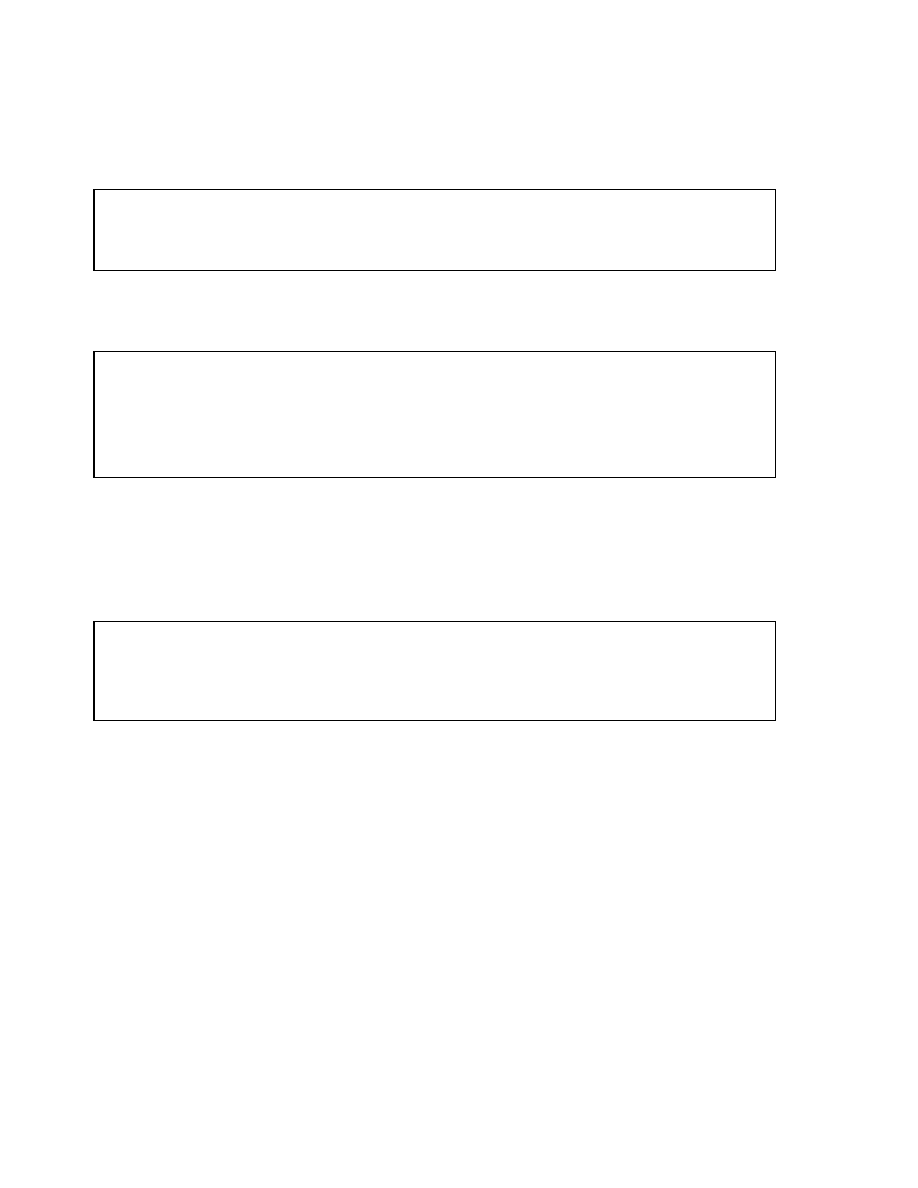
DBA Fundamentals I C
-
43
Practice 10: Solutions (continued)
7
In the session connected as
HR
, roll back the transaction and exit the session.
8
In the session connected as
SYS
drop tablespace
UNDOTBS
. What happened? Why?
9
As
SYS
issue the following command:
ALTER SYSTEM SET undo_retention=0 SCOPE=memory;
Now drop tablespace
UNDOTBS
. What happened? Why?
Note: There still may be a delay before the tablespace is drop.
SQL> ROLLBACK;
Rollback complete.
SQL> EXIT;
SQL> DROP TABLESPACE undotbs;
DROP TABLESPACE undotbs
*
ERROR at line 1:
ORA-30013: undo tablespace 'UNDOTBS' is currently in use
SQL> ALTER SYSTEM SET undo_retention=0 SCOPE=MEMORY;
System altered.
SQL> DROP TABLESPACE undotbs INCLUDING CONTENTS AND DATAFILES;
Tablespace dropped.
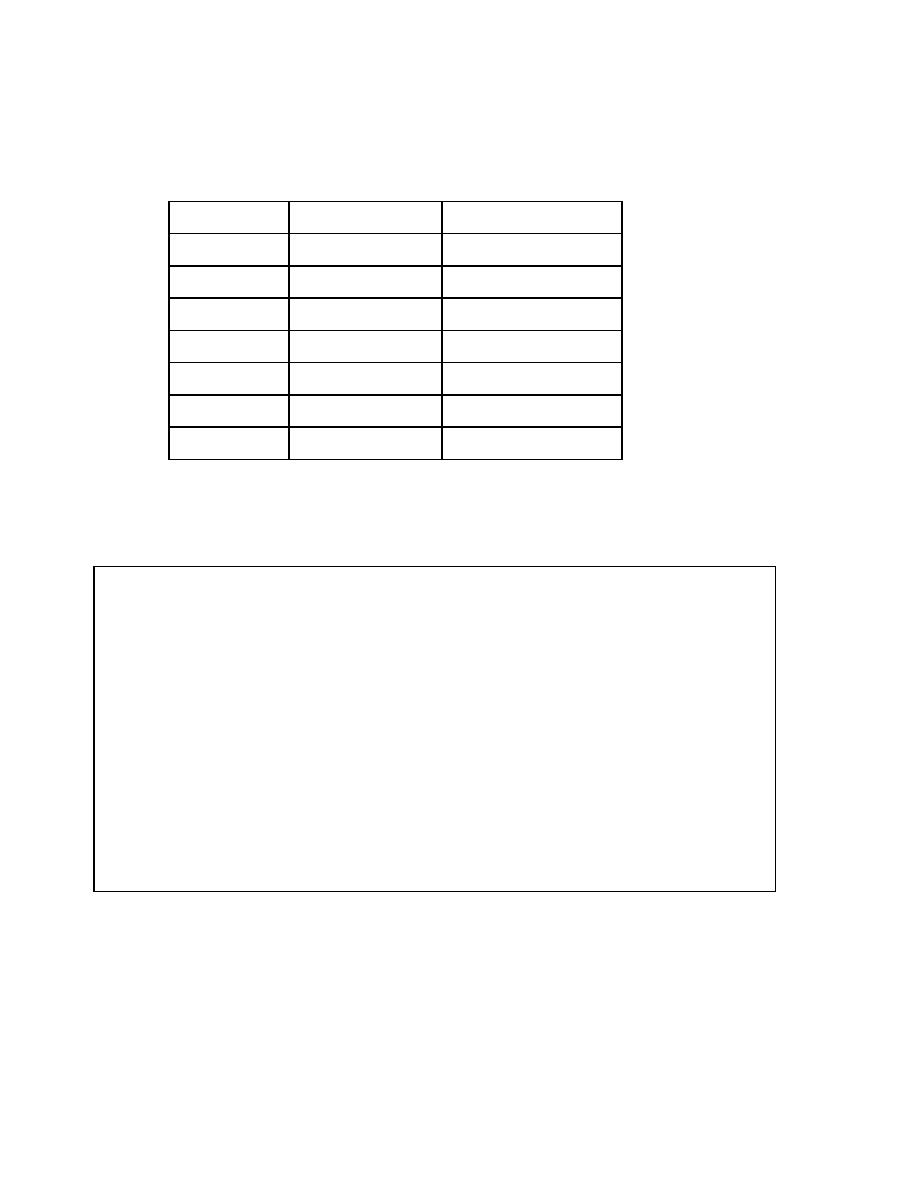
DBA Fundamentals I C
-
44
Practice 11: Solutions
1
Create the following tables as user
SYSTEM
for an order entry system that you are
implementing now. The tables and the columns are shown below:
You have been informed that in the table
ORDERS
, rows will be inserted without a
value for
DATE_OF_DELY
, and it will be updated when the order is fulfilled. Use
tablespace
USERS
. You can use the default storage settings.
DATE
DATE_OF_DELY
VARCHAR2(3)
CUST_CODE
DATE
ORD_DATE
NUMBER(3)
ORD_ID
ORDERS
VARCHAR2(5)
REGION
VARCHAR2(50)
NAME
VARCHAR2(3)
CUST_CODE
CUSTOMERS
Data Type and Size
Column
Table
SQL> CONNECT system/manager
Connected.
SQL> CREATE TABLE customers ( cust_code VARCHAR2(3),
2 name VARCHAR2(50),
3 region VARCHAR2(5) )
4 TABLESPACE users;
Table created.
SQL> CREATE TABLE orders ( ord_id NUMBER(3),
2
ord_date DATE,
3
cust_code VARCHAR2(3),
4 date_of_dely DATE )
5 TABLESPACE users;
Table created.

DBA Fundamentals I C
-
45
Practice 11: Solutions (continued)
2
Run the script
lab11_02.sql
to insert rows into the tables.
3
Find which files and blocks contain the rows for the orders table.
Hint: Query data dictionary view
DBA_EXTENTS
.
4
Check the number of extents used by the table
ORDERS
.
SQL> @$HOME/STUDENT/LABS/lab11_02.sql
SQL> CONNECT system/manager
Connected.
SQL> SELECT file_id, block_id, blocks
2 FROM
dba_extents
3 WHERE owner = 'SYSTEM'
4 AND segment_name = 'ORDERS'
5 AND segment_type = 'TABLE';
FILE_ID BLOCK_ID BLOCKS
---------- ---------- ----------
3 25 8
SQL> SELECT count(*)
2 FROM
dba_extents
3 WHERE segment_name='ORDERS'
4 AND owner='SYSTEM';
COUNT(*)
----------
1

DBA Fundamentals I C
-
46
Practice 11: Solutions (continued)
5
Allocate an extent manually, with default size, for the table
ORDERS
and confirm
that the extent has been added as specified.
6
Create another table,
ORDERS2
as copy of the
ORDERS
table, but with
MINEXTENTS=10
. Verify that the table has been created
with the specified number of extents.
SQL> ALTER TABLE orders ALLOCATE EXTENT;
Table altered.
SQL> SELECT count(*)
2 FROM
dba_extents
3 WHERE segment_name='ORDERS'
4 AND owner='SYSTEM';
COUNT(*)
----------
2
SQL> CREATE TABLE orders2
2 TABLESPACE users
3 STORAGE(MINEXTENTS 10)
4 AS
5 SELECT * FROM orders;
Table created.
SQL> SELECT count(*)
2 FROM
dba_extents
3 WHERE segment_name='ORDERS2'
4 AND owner='SYSTEM';
COUNT(*)
----------
10

DBA Fundamentals I C
-
47
Practice 11: Solutions (continued)
7
Truncate table
ORDERS
without releasing space and check the number of extents to
verify extents have not been deallocated.
8
Truncate the
ORDERS2
table, releasing space. How many extents does the table have
now?
9
Run the script
lab11_09.sql
to insert some rows into the
ORDERS2
table.
SQL> TRUNCATE TABLE orders REUSE STORAGE;
Table truncated.
SQL> SELECT count(*)
2 FROM
dba_extents
3 WHERE segment_name='ORDERS'
4 AND owner='SYSTEM';
COUNT(*)
----------
2
SQL> TRUNCATE TABLE orders2;
Table truncated.
SQL> SELECT count(*)
2 FROM
dba_extents
3 WHERE segment_name='ORDERS2'
4 AND owner='SYSTEM';
COUNT(*)
----------
10
SQL> @$HOME/STUDENT/LABS/lab11_09.sql

DBA Fundamentals I C
-
48
Practice 11: Solutions (continued)
10
View the columns for the
ORDERS2
table. Then mark the
DATE_OF_DELY
column
as
UNUSED
. View the columns for the
ORDERS2
table again. What happens?
11
Drop the unused column
DATE_OF_DELY
.
12
Drop the
ORDERS2
table.
SQL> DESCRIBE orders2;
Name Null? Type
-------------------------- -------- ------------------
ORD_ID NUMBER(3)
ORD_DATE DATE
CUST_CODE VARCHAR2(3)
DATE_OF_DELY DATE
SQL> ALTER TABLE orders2
2 SET UNUSED COLUMN date_of_dely
3 CASCADE CONSTRAINTS;
Table altered.
SQL> DESCRIBE orders2;
Name Null? Type
-------------------------- -------- ------------------
ORD_ID NUMBER(3)
ORD_DATE DATE
CUST_CODE VARCHAR2(3)
SQL> ALTER TABLE orders2
2 DROP UNUSED COLUMNS CHECKPOINT 1000;
Table altered.
SQL> DROP TABLE orders2;
Table dropped.

DBA Fundamentals I C
-
49
Practice 12: Solutions
1
You are considering creating indexes on the
NAME
and
REGION
columns of the
CUSTOMERS
table. What types of index are appropriate for the two columns? Create
the indexes, naming them
CUST_NAME_IDX
and
CUST_REGION_IDX
, respectively,
and placing them in the appropriate tablespaces.
Hint: A B-tree index is suitable for a column with many distinct values, and a
bitmap index is suitable for columns with only a few distinct values.
2
Move the
CUST_REGION_IDX
index to another tablespace.
Hint: The index can be rebuilt specifying a different tablespace.
3
Note the files and blocks used by the extents by
CUST_REGION_IDX
index.
Hint: Use the view
DBA_EXTENTS
to get this information.
SQL> CONNECT system/manager
Connected.
SQL> CREATE INDEX cust_name_idx
2 ON customers(name)
3 TABLESPACE indx01;
Index created.
SQL> CREATE BITMAP INDEX cust_region_idx
2 ON system.customers(region)
3 TABLESPACE indx01;
Index created.
SQL> ALTER INDEX cust_region_idx REBUILD
2 TABLESPACE indx;
Index altered.
SQL> SELECT file_id, block_id, blocks
2 FROM
dba_extents
3 WHERE segment_name='CUST_REGION_IDX'
4 AND owner='SYSTEM';
FILE_ID BLOCK_ID BLOCKS
---------- ---------- ----------
4 17 125

DBA Fundamentals I C
-
50
Practice 12: Solutions (continued)
4
Re-create the
CUST_REGION_IDX
index without dropping and re-creating it, and
retain it in the same tablespace as before. Does the new index use the same blocks that
were used earlier?
Hint: Rebuild the index.
The new index does not reuse the same space as seen from the location of the extent
after rebuild. This is because Oracle server builds a temporary index, drops the old one,
and renames the temporary index.
5
a
As user
SYSTEM
, run the script
lab12_05a.sql
to create and populate
the
NUMBERS
table.
b
Query the table
NUMBERS
to find the number of distinct values in the two
columns in the table.
SQL> ALTER INDEX cust_region_idx REBUILD;
Index altered.
SQL> SELECT file_id, block_id, blocks
2 FROM
dba_extents
3 WHERE segment_name='CUST_REGION_IDX'
4 AND owner='SYSTEM';
FILE_ID BLOCK_ID BLOCKS
---------- ---------- ----------
4 142 125
SQL> @$HOME/STUDENT/LABS/lab12_05a.sql
SQL> SELECT count(DISTINCT no) NO,
2 count(DISTINCT odd_even) OE
3 FROM numbers;
NO OE
---------- ----------
10000 2

DBA Fundamentals I C
-
51
Practice 12: Solutions (continued)
5
c
Create B-tree indexes
NUMB_OE_IDX
and
NUMB_NO_IDX
on the
ODD_EVEN
and
NO
columns of the
NUMBERS
table, respectively, and check the total sizes
of the indexes. Put the indexes in tablespace
INDX01
.
Hint: Check the total blocks allocated to the extents from
DBA_SEGMENTS
.
SQL> CREATE INDEX numb_oe_idx
2 ON numbers(odd_even)
3 TABLESPACE indx01;
Index created.
SQL> CREATE INDEX numb_no_idx
2 ON numbers(no)
3 TABLESPACE indx01;
Index created.
SQL> COLUMN segment_name FORMAT a15
SQL> SELECT segment_name, blocks
2 FROM
dba_segments
3 WHERE segment_name LIKE 'NUMB%'
4 AND segment_type='INDEX';
SEGMENT_NAME BLOCKS
--------------- ----------
NUMB_OE_IDX 40
NUMB_NO_IDX 46

DBA Fundamentals I C
-
52
Practice 12: Solutions (continued)
5
d
Create bitmap indexes
NUMB_OE_IDX
and
NUMB_NO_IDX
on the
ODD_EVEN
and
NO
columns of the
NUMBERS
table, respectively, and check the total sizes
of the indexes. Put the indexes in tablespace
INDX01.
What can you conclude about the relationship between cardinality and sizes of the
two types of indexes?
Hint: The existing indexes need to be dropped before creating the new indexes.
Now re-execute the query to check the sizes of the indexes.
It can be seen from the results that a bitmap index is compact for a low-cardinality
column, while a B-tree index is compact for a high-cardinality column.
SQL> DROP INDEX numb_oe_idx;
Index dropped.
SQL> DROP INDEX numb_no_idx;
Index dropped.
SQL> CREATE BITMAP INDEX numb_oe_idx
2 ON numbers(odd_even)
3 TABLESPACE indx01;
Index created.
SQL> CREATE BITMAP INDEX numb_no_idx
2 ON numbers(no)
3 TABLESPACE indx01;
Index created.
SQL> SELECT segment_name, blocks
2 FROM
dba_segments
3 WHERE segment_name LIKE 'NUMB%'
4 AND segment_type='INDEX';
SEGMENT_NAME BLOCKS
--------------- ----------
NUMB_OE_IDX 2
NUMB_NO_IDX 72

DBA Fundamentals I C
-
53
SQL> COLUMN constraint_name FORMAT a25
SQL> COLUMN table_name FORMAT a10
SQL> COLUMN constraint_type FORMAT a1
SQL> COLUMN deferrable FORMAT a15
SQL> COLUMN status FORMAT a10
SQL> SELECT constraint_name, table_name,
2 constraint_type, deferrable, status
3 FROM
dba_constraints
4 WHERE table_name IN
5 ('PRODUCTS','ORDERS','CUSTOMERS')
6 AND owner='SYSTEM';
CONSTRAINT_NAME TABLE_NAME C DEFERRABLE STATUS
------------------------- ---------- - --------------- ----------
CUSTMOERS_REGION_CK CUSTOMERS C NOT DEFERRABLE ENABLED
CUSTOMERS_CUST_CODE_PK CUSTOMERS P DEFERRABLE ENABLED
ORDERS_CUST_CODE_FK ORDERS R DEFERRABLE ENABLED
ORDERS_DATE_OF_DELY_CK ORDERS C NOT DEFERRABLE ENABLED
ORDERS_ORD_ID_PK ORDERS P NOT DEFERRABLE ENABLED
PRODUCTS_PROD_CODE_UK PRODUCTS U DEFERRABLE DISABLED
6 rows selected.
Practice 13: Solutions
1
Examine the script
lab13_01.sql
. Run the script to create the constraints.
2
Query the data dictionary to:
a
Check for constraints, whether they are deferrable, and their status.
Hint: Use the
DBA_CONSTRAINTS
view to get this information.
SQL> @$HOME/STUDENT/LABS/lab13_01.sql

DBA Fundamentals I C
-
54
Practice 13: Solutions (continued)
2
b
Check the names and types of indexes created to validate the constraints.
Hint: The indexes are only created for primary key and unique constraints and
have the same name as the constraints
3
Insert two records with the following values into the
PRODUCTS
table:
2400
NT Monitor
4000
3620
Unix Monitor
4000
LIST_PRICE
PRODUCT_DESCRIPTION
PRODUCT_ID
SQL> SELECT index_name,table_name,uniqueness
2 FROM
dba_indexes
3 WHERE index_name in
4 ( SELECT constraint_name
5 FROM
dba_constraints
6 WHERE table_name IN ('PRODUCTS', 'ORDERS', 'CUSTOMERS')
7 AND owner='SYSTEM'
8 AND constraint_type in ('P','U')
9 )
10 ;
INDEX_NAME TABLE_NAME UNIQUENES
------------------------------ ---------- ---------
CUSTOMERS_CUST_CODE_PK CUSTOMERS NONUNIQUE
ORDERS_ORD_ID_PK ORDERS UNIQUE
SQL> INSERT INTO system.products
2 VALUES(4000,'UNIX Monitor',3620);
1 row created.
SQL> INSERT INTO system.products
2 VALUES(4000,'NT Monitor', 2400);
1 row created.
SQL> COMMIT;
Commit complete.

DBA Fundamentals I C
-
55
Practice 13: Solutions (continued)
4
Enable the unique constraint on the
PRODUCT
table. Was it successful?
Why or why not?
5
a
Ensure that new rows added to the table do not violate the constraint on the
PRODUCT
table.
Hint: This can be done by enabling the constraint
NOVALIDATE
.
b
Query the data dictionary to verify the effect of the change.
SQL> ALTER TABLE system.products
2 ENABLE CONSTRAINT products_prod_code_uk;
ALTER TABLE system.products
*
ERROR at line 1:
ORA-02299: cannot validate (SYSTEM.PRODUCTS_PROD_CODE_UK) - duplicate
keys found
SQL> ALTER TABLE system.products
2 ENABLE NOVALIDATE CONSTRAINT products_prod_code_uk;
Table altered.
SQL> SELECT constraint_name, table_name,
2 constraint_type, validated, status
3 FROM
dba_constraints
4 WHERE table_name = 'PRODUCTS'
5 AND owner='SYSTEM';
CONSTRAINT_NAME TABLE_NAME C VALIDATED STATUS
------------------------- ---------- - ------------- ----------
PRODUCTS_PROD_CODE_UK PRODUCTS U NOT VALIDATED ENABLED

DBA Fundamentals I C
-
56
Practice 13: Solutions (continued)
5
c
Test that the constraint disables inserts that violate the change by adding a
row with the following values:
3000
Monitor
4000
LIST_PRICE
PRODUCT_DESCRIPTION
PRODUCT_ID
SQL> INSERT INTO system.products
2 VALUES(4000,'Monitor',3000);
INSERT INTO system.products
*
ERROR at line 1:
ORA-00001: unique constraint (SYSTEM.PRODUCTS_PROD_CODE_UK) violated

DBA Fundamentals I C
-
57
Practice 13: Solutions (continued)
6
Take the necessary steps to identify existing constraint violations in the
PRODUCTS
table, modify product codes as needed, and guarantee that all existing as well as new
data do not violate the constraint. (Assume that the table has several thousands of
rows and it is too time-consuming to verify each row manually.)
Hint: Use the following steps:
a
Create the
EXCEPTIONS
table.
b
Run the command to enable the constraint and trap the exceptions.
c
Use the
ROWID
s in the
EXCEPTIONS
table to list the rows in the
PRODUCTS
table that violate the constraint. (Do not list LOB columns.)
SQL> CONNECT system/manager
Connected.
SQL> @?/rdbms/admin/utlexcpt
SQL> ALTER TABLE system.products
2 ENABLE CONSTRAINT products_prod_code_uk
3 EXCEPTIONS INTO system.exceptions;
ALTER TABLE system.products
*
ERROR at line 1:
ORA-02299: cannot validate (SYSTEM.PRODUCTS_PROD_CODE_UK) - duplicate
keys found
SQL> SELECT rowid, prod_code, description
2 FROM system.products
3 WHERE
rowid IN ( SELECT row_id
4 FROM exceptions
5 WHERE table_name='PRODUCTS'
6 )
7 ;
ROWID PROD_CODE DESCRIPTION
------------------ ---------- ------------------------------
AAABSgAAIAAAAASAAA 4000 UNIX Monitor
AAABSgAAIAAAAASAAB 4000 NT Monitor

DBA Fundamentals I C
-
58
Practice 13: Solutions (continued)
6
d
Rectify the errors.
e
Enable the constraint.
SQL> UPDATE system.products
2 SET prod_code='4001'
3 WHERE
rowid = ( SELECT max(row_id)
4
FROM exceptions
5
WHERE table_name='PRODUCTS'
6 )
7 ;
1 row updated.
SQL> ALTER TABLE system.products
2 ENABLE CONSTRAINT products_prod_code_uk
3 EXCEPTIONS INTO system.exceptions;
Table altered.

DBA Fundamentals I C
-
59
Practice 13: Solutions (continued)
7
Run the script
lab13_07.sql
to insert rows into the table. Were the inserts
successful? Roll back the changes.
8
Now examine the script
lab13_08
. Notice that this script also performs the
inserts in the same sequence. Run the script and check if it executes successfully.
9
Truncate the
CUSTOMERS
table. Was it successful? Why or why not?
SQL> @$HOME/STUDENT/LABS/lab13_07.sql
SQL> INSERT INTO system.orders
2 VALUES (800,'01-JAN-98','J01',NULL);
INSERT INTO system.orders
*
ERROR at line 1:
ORA-02291: integrity constraint (SYSTEM.ORDERS_CUST_CODE_FK) violated -
parent key not found
SQL> INSERT INTO system.customers
2 VALUES ('J01','Sports Store', 'East');
1 row created.
SQL> ROLLBACK;
Rollback complete.
SQL> @$HOME/STUDENT/LABS/lab13_08.sql
SQL> ALTER SESSION SET CONSTRAINTS=deferred;
Session altered.
SQL> INSERT INTO system.orders
2 VALUES (800,'01-JAN-98','J01',NULL);
1 row created.
SQL> INSERT INTO system.customers
2 VALUES ('J01','Sports Store', 'East');
1 row created.
SQL> COMMIT;
Commit complete.
SQL> TRUNCATE TABLE system.customers;
TRUNCATE TABLE system.customers
*
ERROR at line 1:
ORA-02266: unique/primary keys in table referenced by enabled foreign
keys
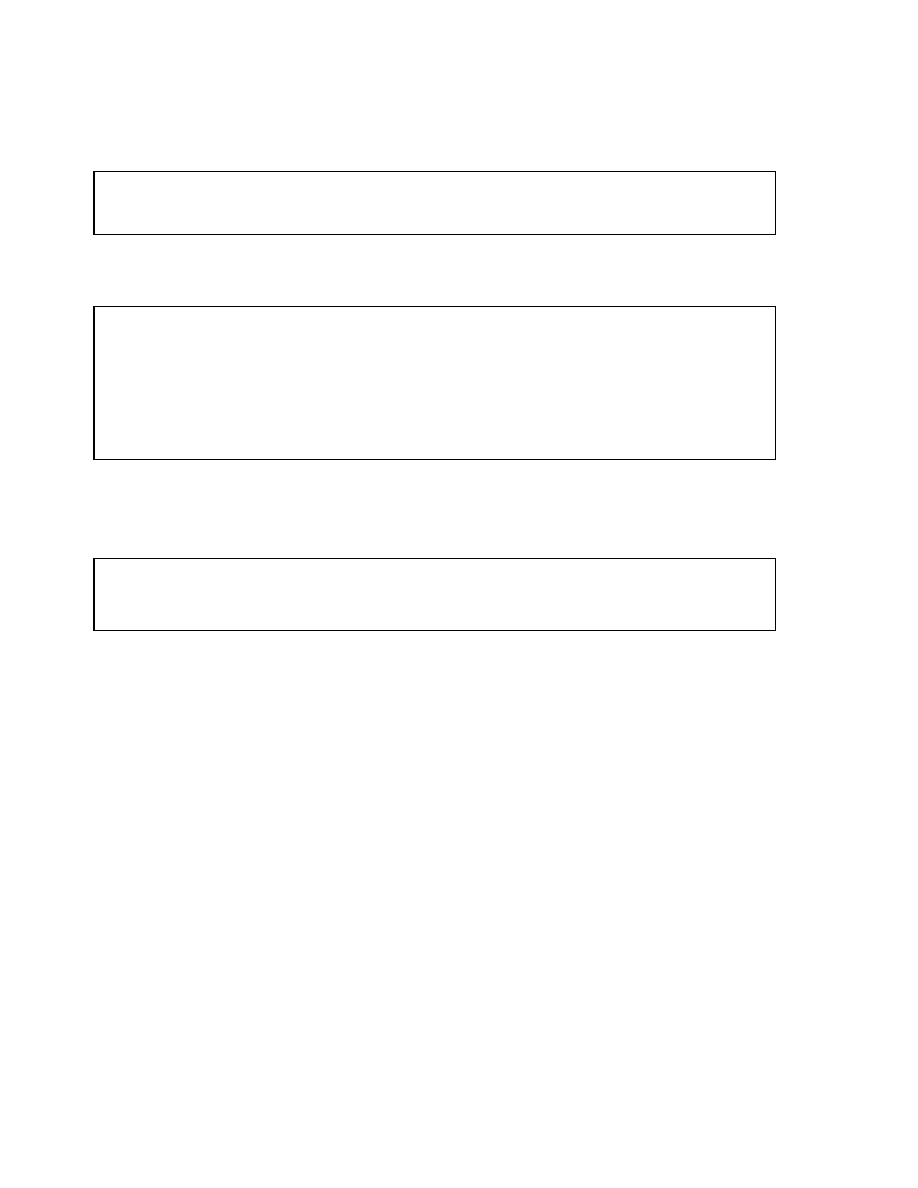
DBA Fundamentals I C
-
60
Practice 14: Solutions
1
Run the
lab14_01.sql
script to create user Jeff. Enable password management
by running script
@$ORACLE_HOME/rdbms/admin/utlpwdmg.sql
.
2
Try to change the password of user
Jeff
to
JEFF
. What happens?
3
Try changing the password for Jeff to follow the password management format.
Hint: Password should contain at least one digit, one character, and one punctuation.
SQL> @$HOME/STUDENT/LABS/lab14_01.sql
SQL> @$ORACLE_HOME/rdbms/admin/utlpwdmg.sql
SQL> ALTER USER jeff IDENTIFIED BY jeff;
ALTER USER jeff IDENTIFIED BY jeff
*
ERROR at line 1:
ORA-28003: password verification for the specified password failed
ORA-20001: Password same as or similar to user
SQL> ALTER USER jeff
2 IDENTIFIED BY super1$;
User altered.

DBA Fundamentals I C
-
61
Practice 14: Solutions (continued)
4
Alter the
DEFAULT
profile to ensure the following applies to users assigned the
DEFAULT
profile:
-
After two login attempts, the account should be locked.
-
The password should expire after 30 days.
-
The same password should not be reused for at least one minute.
-
The account should have a grace period of five days to change an expired
password.
-
Ensure that the requirements given have been implemented.
Hints:
Use the
ALTER PROFILE
command to change the default profile limits.
Query the data dictionary view
DBA_PROFILES
to verify the result.
SQL> ALTER PROFILE default LIMIT
2 FAILED_LOGIN_ATTEMPTS 2
3 PASSWORD_LIFE_TIME 30
4 PASSWORD_REUSE_TIME 1/1440
5 PASSWORD_GRACE_TIME 5;
Profile altered.
SQL> SELECT resource_name, limit
2 FROM
dba_profiles
3 WHERE profile='DEFAULT'
4 AND resource_type='PASSWORD';
RESOURCE_NAME LIMIT
----------------------------- -------------------------------------
FAILED_LOGIN_ATTEMPTS 2
PASSWORD_LIFE_TIME 30
PASSWORD_REUSE_TIME .0006
PASSWORD_REUSE_MAX UNLIMITED
PASSWORD_VERIFY_FUNCTION VERIFY_FUNCTION
PASSWORD_LOCK_TIME .0006
PASSWORD_GRACE_TIME 5
7 rows selected.

DBA Fundamentals I C
-
62
Practice 14: Solutions (continued)
5
Log in to user
Jeff
supplying an invalid password. Try this twice, then log in again,
this time supplying the correct password. What happens? Why?
6
Using data dictionary view DBA_USERS verify user Jeff is locked. Unlock the account
for the user Jeff. After unlocking user Jeff connect as Jeff.
Hint: Execute the
ALTER USER
command to unlock the account.
SQL> CONNECT jeff/superman
ERROR:
ORA-01017: invalid username/password; logon denied
Warning: You are no longer connected to ORACLE.
SQL> CONNECT jeff/super
ERROR:
ORA-01017: invalid username/password; logon denied
SQL> CONNECT jeff/super1$
ERROR:
ORA-28000: the account is locked
SQL> CONNECT / AS SYSDBA
Connected.
SQL> SELECT username, account_status
2 FROM
dba_users;
USERNAME ACCOUNT_STATUS
--------------- ---------------
SYS OPEN
SYSTEM OPEN
OUTLN OPEN
ORDSYS OPEN
MDSYS OPEN
OE OPEN
HR OPEN
ORDPLUGINS OPEN
DBSNMP OPEN
JEFF LOCKED(TIMED)
10 rows selected.
SQL> ALTER USER jeff
2 ACCOUNT UNLOCK;
User altered.
SQL> CONNECT jeff/super1$
Connected.

DBA Fundamentals I C
-
63
Practice 14: Solutions (continued)
7
Disable password checks for the
DEFAULT
profile.
Hint: Execute the
ALTER PROFILE
command to disable the password checks.
8
Log in to user
Jeff
supplying an invalid password. Try this twice, then log in again,
this time supplying the correct password. What happens? Why?
SQL> CONNECT jeff/superman
ERROR:
ORA-01017: invalid username/password; logon denied
Warning: You are no longer connected to ORACLE.
SQL> CONNECT jeff/super
ERROR:
ORA-01017: invalid username/password; logon denied
SQL> CONNECT jeff/super1$
Connected.
SQL> ALTER PROFILE default LIMIT
2 FAILED_LOGIN_ATTEMPTS UNLIMITED
3 PASSWORD_LIFE_TIME UNLIMITED
4 PASSWORD_REUSE_TIME UNLIMITED
5 PASSWORD_REUSE_MAX UNLIMITED
6 PASSWORD_VERIFY_FUNCTION NULL
7 PASSWORD_LOCK_TIME UNLIMITED
8 PASSWORD_GRACE_TIME UNLIMITED;
Profile altered.

DBA Fundamentals I C
-
64
Practice 15: Solutions
1
Create user
Bob
with a password of
CRUSADER
. Make sure that any objects and
temporary segments created by Bob are not created in the system tablespace. Also,
ensure that
Bob
can log in and create objects up to one megabyte in size in
USERS
and
INDX
tablespaces.
Hint: Ensure that the temporary tablespace temp is assigned. Use the
lab15_01.sql
script to grant Bob the ability to create sessions.
2
Create a user
Emi
with a password of
MARY
. Make sure that any objects and sort
segments created by
Emi
are not created in the system tablespace.
3
Display the information on
Bob
and
Emi
from the data dictionary.
Hint: This can be obtained by querying
DBA_USERS
.
SQL> CONNECT system/manager
Connected.
SQL> CREATE USER bob
2 IDENTIFIED BY crusader
3 DEFAULT TABLESPACE USERS
4 TEMPORARY TABLESPACE temp
5 QUOTA 1M ON USERS
6 QUOTA 1M ON INDX;
User created.
SQL> @$HOME/STUDENT/LABS/lab15_01.sql
SQL> GRANT CREATE SESSION TO bob;
Grant succeeded.
SQL> CREATE USER emi
2 IDENTIFIED BY mary
3 DEFAULT TABLESPACE users
4 TEMPORARY TABLESPACE temp;
User created.
SQL> SELECT username, default_tablespace,
2 temporary_tablespace
3 FROM
dba_users
4 WHERE username IN ('BOB', 'EMI');
USERNAME DEFAULT_TABLESPACE TEMPORARY_TABLE
---------- -------------------- ---------------
EMI USERS TEMP
BOB USERS TEMP

DBA Fundamentals I C
-
65
Practice 15: Solutions (continued)
4
From the data dictionary, display the information on the amount of space that Bob
can use in tablespaces.
Hint: This can be obtained by querying
DBA_TS_QUOTAS
.
5
a
As user
BOB
change his temporary tablespace. What happens? Why?
b
As
Bob
, change his password to
SAM
.
SQL> COLUMN tablespace_name FORMAT a15
SQL> COLUMN user FORMAT a10
SQL> SELECT *
2 FROM
dba_ts_quotas
3 WHERE username = 'BOB';
TABLESPACE_NAME USERNAME BYTES MAX_BYTES BLOCKS MAX_BLOCKS
--------------- -------- -------- ---------- ---------- ----------
INDX BOB 0 1048576 0 256
USERS BOB 0 1048576 0 256
SQL> connect bob/crusader;
Connected.
SQL> ALTER USER bob
2 TEMPORARY TABLESPACE users;
ALTER USER bob
*
ERROR at line 1:
ORA-01031: insufficient privileges
SQL> connect bob/crusader;
Connected.
SQL> ALTER USER bob
2 IDENTIFIED BY sam;
User altered.
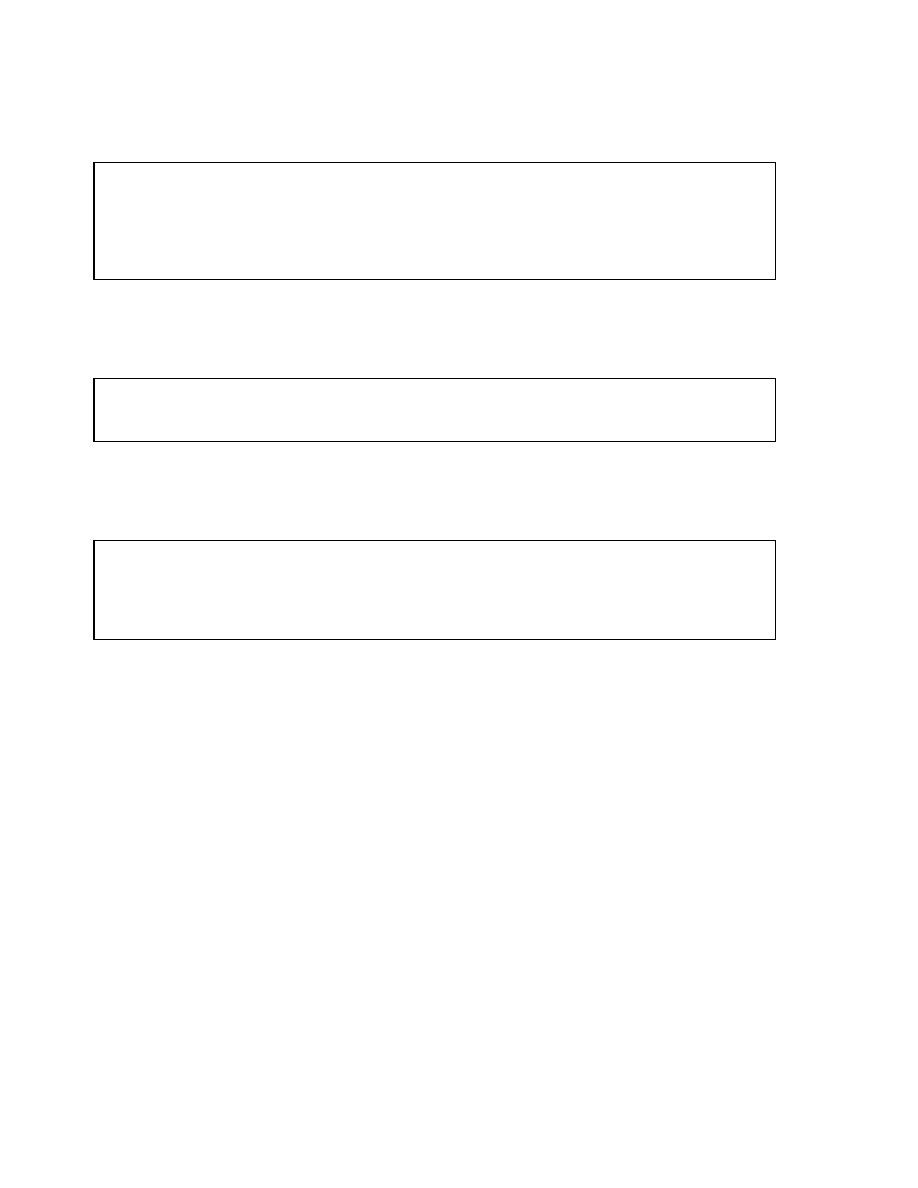
DBA Fundamentals I C
-
66
Practice 15: Solutions (continued)
6
As
SYSTEM
, remove
Bob
’s quota on his default tablespace.
7
Remove
Emi
’s account from the database.
Hint: Because
Emi
owns tables, you need to use the
CASCADE
option.
8
Bob
has forgotten his password. Assign him a password of
OLINK
and require
that
Bob
change his password the next time he logs on.
SQL> CONNECT system/manager
Connected.
SQL> ALTER USER bob QUOTA 0 ON users;
User altered.
SQL> DROP USER emi;
User dropped.
SQL> ALTER USER bob
2 IDENTIFIED BY olink
3 PASSWORD EXPIRE;
User altered.

DBA Fundamentals I C
-
67
Practice 16: Solutions
1
As
SYSTEM
, create user
Emi
and give her the capability to log on to the database and
create objects in her schema.
2
a
Connect as
Emi
, and create tables using the script
lab16_02a.sql
to create the
tables
CUSTOMERS
and
ORDERS
.
SQL> CONNECT system/manager
Connected.
SQL> CREATE USER emi
2 IDENTIFIED BY "abcd12"
3 DEFAULT TABLESPACE data01
4 TEMPORARY TABLESPACE temp
5 QUOTA 1M ON data01;
User created.
SQL> GRANT create session, create table TO emi;
Grant succeeded.
SQL> CONNECT emi/abcd12;
Connected.
SQL> @$HOME/STUDENT/LABS/lab16_02a.sql;

DBA Fundamentals I C
-
68
Practice 16: Solutions (continued)
2
b
Connect as
SYSTEM
and copy the data from
SYSTEM.CUSTOMERS
to
Emi
’s
CUSOMTERS
table. Verify that records have been inserted.
c
As
SYSTEM
give
Bob
the ability to select from
Emi
's
CUSTOMERS
table. What
happens and why?
SQL> CONNECT system/manager;
Connected.
SQL> INSERT INTO emi.customers
2 SELECT *
3 FROM system.customers;
9 rows created.
SQL> SELECT * FROM emi.customers;
CUS NAME REGIO
--- -------------------------------------------------- -----
A01 TKB SPORT SHOP West
A02 VOLLYRITE North
A03 JUST TENNIS North
A04 EVERY MOUNTAIN South
A05 SHAPE UP South
A06 SHAPE UP West
A07 WOMENS SPORTS South
A08 NORTH WOODS HEALTH AND FITNESS SUPPLY CENTER East
J01 Sports Store East
9 rows selected.
SQL> CONNECT system/manager
Connected.
SQL> GRANT select ON emi.customers TO bob;
GRANT select ON emi.customers TO bob
*
ERROR at line 1:
ORA-01031: insufficient privileges

DBA Fundamentals I C
-
69
Practice 16: Solutions (continued)
3
Reconnect as
Emi
and give
Bob
the ability to select from
Emi
's
CUSTOMERS
table.
Also, enable
Bob
to give the select capability to other users. Examine the data
dictionary views that record these actions.
4
Create user
Trevor
with the capability to log on to the database.
SQL> CONNECT emi/abcd12;
Connected.
SQL> GRANT select ON customers
2 TO bob WITH GRANT OPTION;
Grant succeeded.
SQL> CONNECT system/manager;
Connected.
SQL> COLUMN grantee FORMAT a8
SQL> COLUMN owner FORMAT a8
SQL> COLUMN table_name FORMAT a10
SQL> COLUMN grantor FORMAT a8
SQL> COLUMN privilege FORMAT a10
SQL> COLUMN grantable FORMAT a3
SQL> COLUMN hiearchy FORMAT a3
SQL> SELECT *
2 FROM
dba_tab_privs
3 WHERE grantee='BOB';
GRANTEE OWNER TABLE_NAME GRANTOR PRIVILEGE GRA HIE
-------- -------- ---------- -------- ---------- --- ---
BOB EMI CUSTOMERS EMI SELECT YES NO
SQL> CONNECT system/manager
Connected.
SQL> CREATE USER trevor IDENTIFIED BY "abcd1?";
User created.
SQL> GRANT create session TO trevor;
Grant succeeded.

DBA Fundamentals I C
-
70
Practice 16: Solutions (continued)
5
a
As
Bob
, enable
Trevor
to access
Emi
’s
CUSTOMERS
table. Give
Bob
the new
password
sam
.
b
As
Emi
, remove
Bob
’s privilege to read
Emi
’s
CUSTOMERS
table.
c
As
Trevor
, query
Emi
’s
CUSTOEMRS
table. What happens and why?
SQL> CONNECT bob/olink
ERROR:
ORA-28001: the password has expired
Changing password for bob
New password:
Retype new password:
Password changed
Connected.
SQL> GRANT select ON emi.customers TO trevor;
Grant succeeded.
SQL> CONNECT emi/abcd12;
Connected.
SQL> REVOKE select ON customers FROM bob;
Revoke succeeded.
SQL> CONNECT trevor/abcd1?;
Connected.
SQL> SELECT *
2 FROM emi.customers;
FROM emi.customers
*
ERROR at line 2:
ORA-00942: table or view does not exist

DBA Fundamentals I C
-
71
Practice 16: Solutions (continued)
6
a
Enable
Emi
to create tables in any schema. As
Emi
, create the table
ORDERS
in
Bob
’s schema as a copy of
EMI.ORDERS
. What happened and why?
b
As
SYSTEM
, examine the data dictionary view
DBA_TABLES
to
check the result.
7
Enable
Emi
to start up and shut down the database without the ability to create a
new database.
SQL> CONNECT system/manager
Connected.
SQL> GRANT create any table TO emi;
Grant succeeded.
SQL> CONNECT emi/abcd12
Connected.
SQL> CREATE TABLE bob.orders
2 AS
3 SELECT *
4 FROM orders;
FROM orders
*
ERROR at line 4:
ORA-01536: space quota exceeded for tablespace 'USERS'
SQL> CONNECT system/manager
Connected.
SQL> SELECT owner, table_name
2 FROM
dba_tables
3 WHERE table_name IN ('CUSMTERS', 'ORDERS');
OWNER TABLE_NAME
-------- ----------
OE ORDERS
SYSTEM ORDERS
EMI ORDERS
SQL> CONNECT sys/oracle AS SYSDBA
Connected.
SQL> GRANT sysoper TO emi;
Grant succeeded.

DBA Fundamentals I C
-
72
Practice 17: Solutions
1
Examine the data dictionary view and list the system privileges of the
RESOURCE
role.
2
Create a role called
DEV
, which enables a user to create a table, create a view and
select from
Emi
’s
CUSTOMERS
table.
SQL> CONNECT system/manager
Connected.
SQL> COLUMN privilege FORMAT a20
SQL> COLUMN grantee FORMAT a10
SQL> SELECT *
2 FROM
dba_sys_privs
3 WHERE
grantee = 'RESOURCE';
GRANTEE PRIVILEGE ADM
---------- -------------------- ---
RESOURCE CREATE CLUSTER NO
RESOURCE CREATE INDEXTYPE NO
RESOURCE CREATE OPERATOR NO
RESOURCE CREATE PROCEDURE NO
RESOURCE CREATE SEQUENCE NO
RESOURCE CREATE TABLE NO
RESOURCE CREATE TRIGGER NO
RESOURCE CREATE TYPE NO
8 rows selected.
SQL> CREATE ROLE dev;
Role created.
SQL> GRANT create table, create view TO dev;
Grant succeeded.
SQL> CONNECT emi/abcd12
Connected.
SQL> GRANT select ON customers TO dev;
Grant succeeded.
SQL> CONNECT system/manager
Connected.
SQL> GRANT dev TO bob;
Grant succeeded.

DBA Fundamentals I C
-
73
Practice 17: Solutions (continued)
3
a
Assign the
RESOURCE
and
DEV
roles to
Bob
, but make only the
RESOURCE
role to be automatically enabled when he logs on.
b
Give
Bob
the ability to read all the data dictionary information.
4
Bob
needs to check the undo segments that are currently used by the instance.
Connect as
Bob
and list the undo segments used.
SQL> CONNECT system/manager
Connected.
SQL> GRANT dev, resource TO bob;
Grant succeeded.
SQL> ALTER USER bob
2 DEFAULT ROLE resource;
User altered.
SQL> connect system/manager;
Connected.
SQL> GRANT select_catalog_role TO bob;
Grant succeeded.
SQL> CONNECT bob/sam
Connected.
SQL> SET ROLE select_catalog_role;
Role set.
SQL> SELECT segment_name
2 FROM
dba_rollback_segs
3 WHERE status='ONLINE';
SEGMENT_NAME
---------------
SYSTEM
_SYSSMU9$
_SYSSMU10$
_SYSSMU11$
_SYSSMU12$
_SYSSMU13$
_SYSSMU14$
_SYSSMU15$
_SYSSMU16$
9 rows selected.

DBA Fundamentals I C
-
74
Practice 17: Solutions (continued)
5
As
SYSTEM
, try to create a view
CUST_VIEW
on
Emi
’s
CUSTOMERS
table. What
happens and why?
6
As user
Emi
grant select on customers to
SYSTEM
. As
SYSTEM
try to create view
CUST_VIEW
on
Emi
’s
CUSTOMERS
table. What happens and why?
SQL> connect system/manager
Connected.
SQL> CREATE VIEW cust_view AS
2 SELECT *
3 FROM
emi.customers;
FROM
emi.customers
*
ERROR at line 3:
ORA-01031: insufficient privileges
SQL> CONNECT emi/abcd12
Connected.
SQL> GRANT select ON customers TO system;
Grant succeeded.
SQL> CONNECT system/manager
Connected.
SQL> CREATE VIEW cust_view AS
2 SELECT *
3 FROM
emi.customers;
View created.

DBA Fundamentals I C
-
75
Practice 18: Solutions
1
Check the database and the national character set.
2
Which are valid values for the database character set.
SQL> CONNECT sys/oracle AS SYSDBA
Connected.
SQL> SELECT parameter, value
2 FROM
nls_database_parameters
3 WHERE parameter LIKE '%CHARACTERSET%';
PARAMETER VALUE
------------------------------ ----------------------------------------
NLS_CHARACTERSET WE8ISO8859P1
NLS_NCHAR_CHARACTERSET AL16UTF16
SQL> SELECT value
2 FROM v$nls_valid_values
3 WHERE parameter = 'CHARACTERSET'
4 ORDER BY value;
VALUE
----------------------------------------------------------------
AL16UTF16
AL24UTFFSS
AL32UTF8
AR8ADOS710
AR8ADOS710T
AR8ADOS720
AR8ADOS720T
.
.
.

DBA Fundamentals I C
-
76
Practice 18: Solutions (continued)
3
Make sure that all dates in this session are displayed using a 4-digit year. Change
NLS_LANGUAGE
to
FRENCH
. Select
sysdate
from
DUAL
.
SQL> ALTER SESSION SET nls_date_format = 'DD-MON-YYYY';
Session altered.
SQL> ALTER SESSION SET NLS_LANGUAGE = FRENCH;
Session modifiee.
SQL> SELECT sysdate
2 FROM dual;
SYSDATE
-----------
29-AVR-2001
Wyszukiwarka
Podobne podstrony:
oracle dba checklists pocket reference
Fundamentowanie W 02
Teologia Fundamentalna 28.02.2009
Sławek, 02 Fundamentowanie projekt I - spis treści, Opis techniczny dźwigara pełmego gwoździowanego
26 0707PYRZ M 11 01 02 WYKOPY POD FUNDAMENTY
II 02 Rzut fundamentów A3
02 Vinyasa Fundamental
Pytania z egzaminu z Fundamentowania (KBI TOB) 02 02 2005r
02 Garry s Chess Fundamentals
02 ABS Fundamentals 1 20 03
ITCertify Oracle 9i 1Z0 031 Database Fundamentals I v15[1][1] 0
Fundamentals of Anatomy and Physiology 02 Chapter
Fundamentals of College Physics Chapter 02
C Users Marcin Desktop szkola sem 5 fundamentowanie Mój projekt nr 1 wykres 02 11 2014 Model (1)
II 02 Rzut fundamentów A3
więcej podobnych podstron